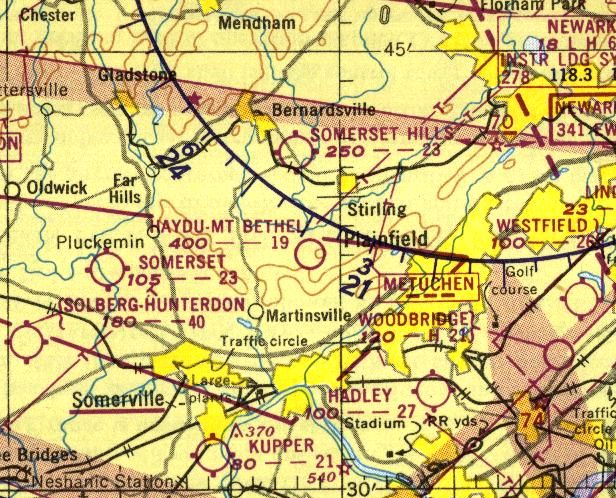
Abandoned & Little-Known Airfields:
Northeastern New Jersey
© 2002, © 2016 by Paul Freeman. Revised 11/22/16.
This site covers airfields in all 50 states: Click here for the site's main menu.
____________________________________________________
Please consider a financial contribution to support the continued growth & operation of this site.
Aeromarine Factory Airfield / Keyport Airport (revised 7/16/16) - Belford Airfield (revised 7/16/16) - Hadley Field (revised 7/10/15)
East Hanover Airport / Hanover Airport (revised 12/12/15) - Haydu – Mt Bethel Airport (added 11/22/16) - North Brunswick Airport (revised 9/11/15)
Passaic County Airport / Murchio Field / Murchio Airport (revised 7/23/16) - Ramapo Valley Airport (revised 7/16/16) - Somerset Hills Airport (revised 10/4/16)
Standard Aircraft Company Factory Airfield / Bayway Airfield (revised 12/7/14) - Totowa-Wayne Airport (revised 7/11/15) - Towaco Airport / Montville Airport (revised 7/11/15)
Walling Airport (revised 2/17/14) - Westfield Airport (revised 7/16/16) - Woodbridge Airport / Shinn-Woodbridge Airport (revised 9/13/14)
____________________________________________________
Haydu – Mt Bethel Airport, Warren, NJ
40.632, -74.502 (West of New York, NY)

Haydu – Mt Bethel Airport, as depicted on the 1950 NY Sectional Chart.
This small general aviation airport was evidently established at some point between 1947-50,
as it was not yet depicted on the 1945 NY Sectional Chart nor on the 1947 USGS topo map.
The earliest depiction which has been located of Haydu – Mt Bethel Airport was on the 1950 NY Sectional Chart.
It depicted Haydu – Mt Bethel Airport as having a mere 1,900' unpaved runway.
Lee Corbin recalled, “I remember driving by it as a kid.”
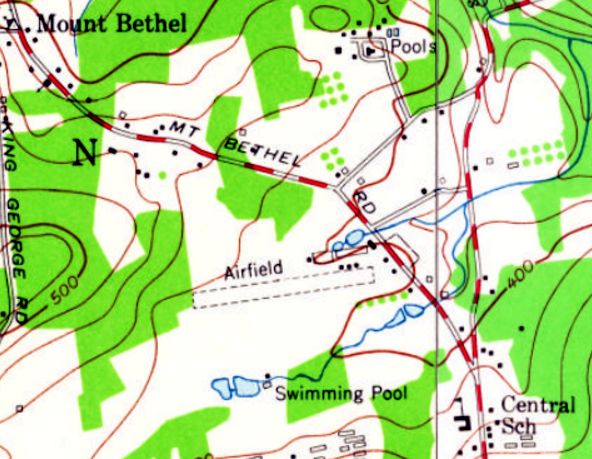
The 1954 USGS topo map (courtesy of Lee Corbin) depicted Haydu – Mt Bethel Airport as a single unpaved northeast/southwest runway,
labeled simply as “Airfield”, with a few small buildings on the northeast side.
A 1956 USGS aerial photo depicted Haydu – Mt Bethel Airport as having a single unpaved northeast/southwest runway,
with a few small buildings on the northeast side.
But there were no aircraft visible on the field.
A 1957 USGS aerial photo showed the Haydu – Mt Bethel Airport runway remained clear, but there was no indication of recent aviation use.
Haydu – Mt Bethel Airport was evidently closed at some point between 1950-58,
as it was no longer depicted on the 1958 NY Sectional Chart.
A 1963 USGS aerial photo showed objects stored on the eastern end of the runway,
and the western end of the runway appeared to have been dug up.
Haydu – Mt Bethel Airport was no longer depicted on the 1970 USGS topo map.
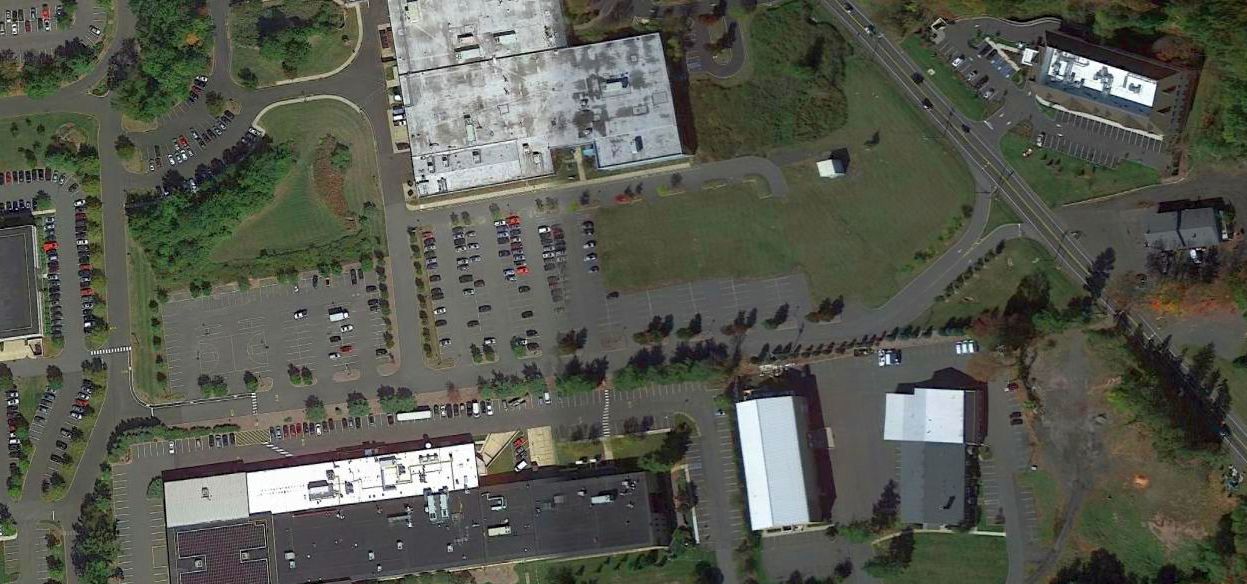
A 2014 aerial photo showed no trace remaining of Haydu – Mt Bethel Airport.
The site of Haydu – Mt Bethel Airport is located southwest of the intersection of Mt Bethel Road & Reinman Road.
Thanks to Lee Corbin for pointing out this airfield.
____________________________________________________
Standard Aircraft Company Factory Airfield / Bayway Airfield, Bayway, NJ
40.644, -74.214 (West of New York, NY)
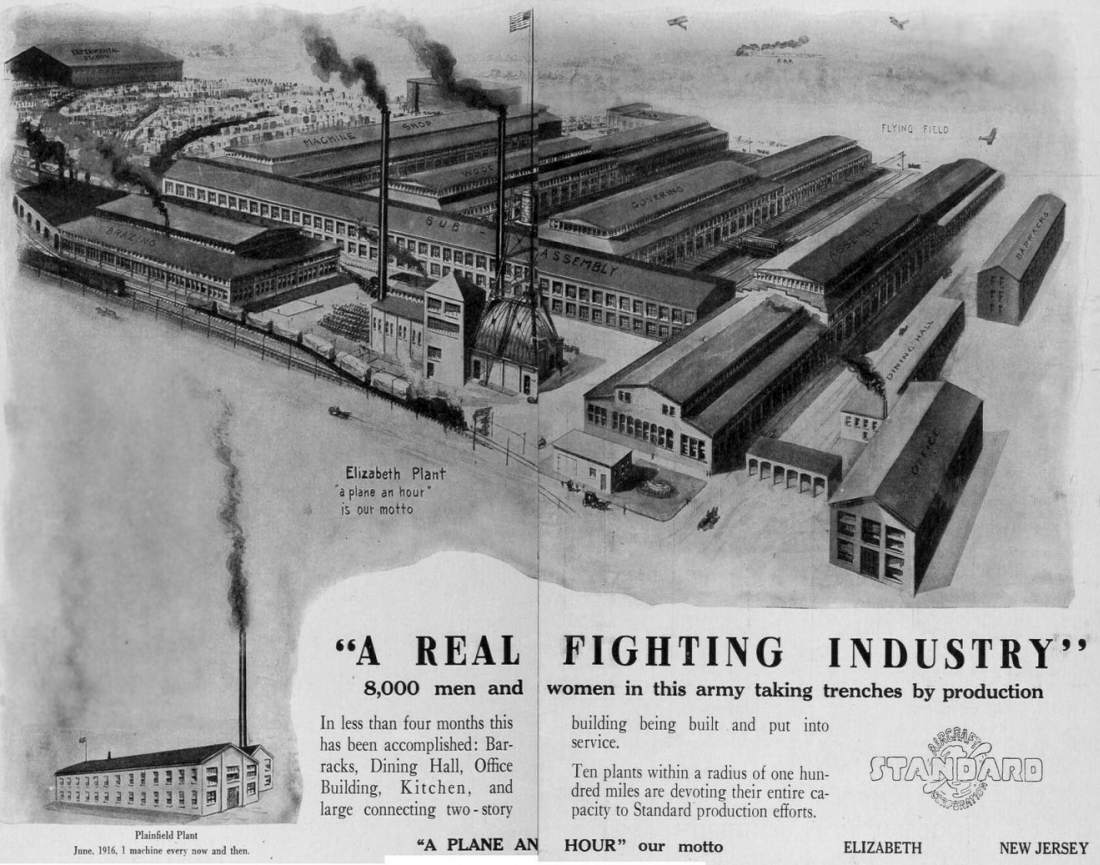
An image courtesy of Fred Cassel, which Fred observes is “an ad that Standard Aircraft ran in 1917
that used the exaggerated bird's eye view that was originally issued as a postcard of the Stephenson Trolley Works.
The image was re-labeled as the complex looked when Standard was in operation, including the label of Flying Field just beyond the buildings.”
According to Fred Cassel, “The complex was built in 1895 to build wooden trolleys for the Stephenson Trolley Works company.
As trolleys transitioned from wood to steel, the facility quickly became outdated,but became ideal for the woodworking-based aero industry.
Standard Aircraft purchased the plant with basically the entire skilled workforce,
created the airfield out back & overnight became one of the 4 largest aircraft manufacturers in the nation.
When it was operated by Stephenson Trolley & then Standard Aircraft,
it was a classic late 1800's red-brick industrial complex composed of numerous long narrow individual buildings.
In 1917 while prospects were still quite high, they built a huge assembly building solely for the final assembly of the massive 100' wingspan H-P O/400 bomber.
The airstrip was just to the northwest of the buildings.
Standard Aircraft built some rather large planes at this facility in the 1917-18 timeframe,
including the American-built versions of the early British bomber, the Handley-Page O/400, as well as countless other small early biplanes.”
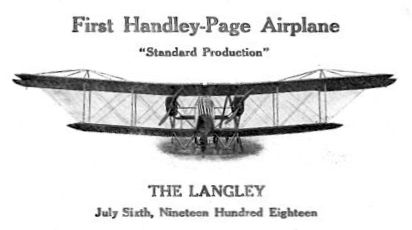
A commemoration of The Langley, the first Handley-Page airplane from the “Standard Production” on 7/6/18.
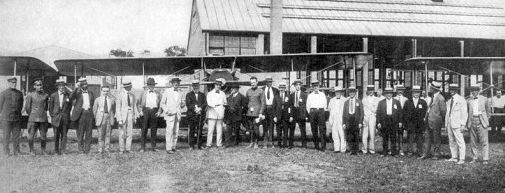
An 8/16/18 photo of a group in front of biplanes at the Standard Aircraft factory.
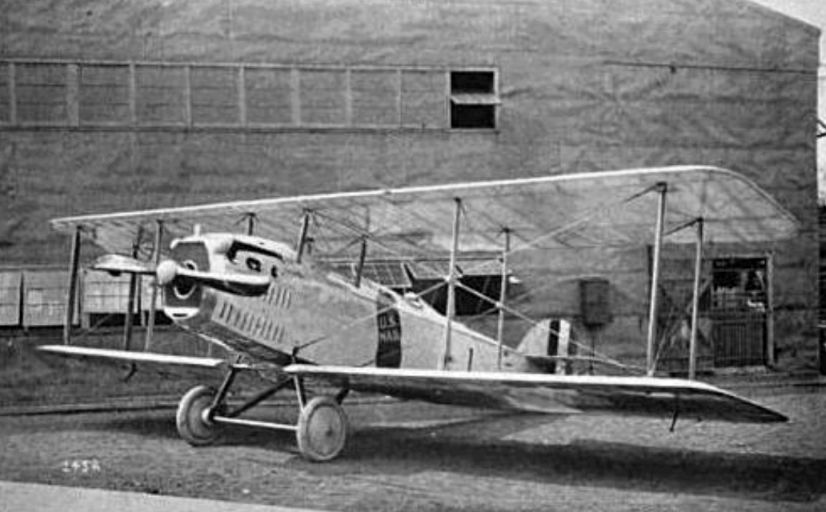
A circa 1918-19 photo of a single-engine Standard biplane in front of the factory.
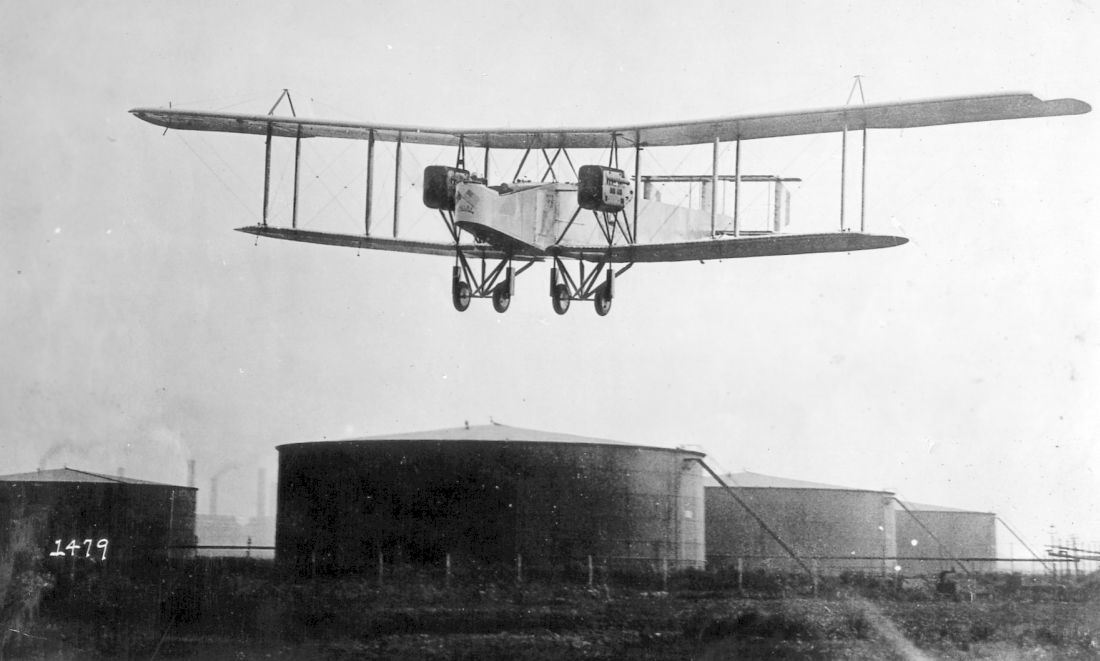
A 1918-19 photo of a massive Handley-Page O/400 approaching the Bayway Airfield, over the adjacent Standard Oil tanks.
Acording to Wikipedia, Standard Aircraft supplied the Sloan H as the Standard H-2 & H-3 to the Army,
and the float-equipped H-4H to the Navy, after the Sloan company was reorganised as the Standard Aircraft Company.
A more significant type was the Standard J series trainer, similar to the Curtiss JN-4,
which began with the SJ prototype, followed by the production J-1 (or SJ-1), of which some 800 were built.
They were badly hampered by the choice of engine, and attempts to cure the problems with subsequent designs were not successful.
Only handfuls of JRs & JR-1Bs were built; some were also purchased by the Post Office.
Standard's last type was the E-1. Intended as a fighter, 100 served as advanced trainers,
about half with a provision for fitting machine guns, as the M-Defense.
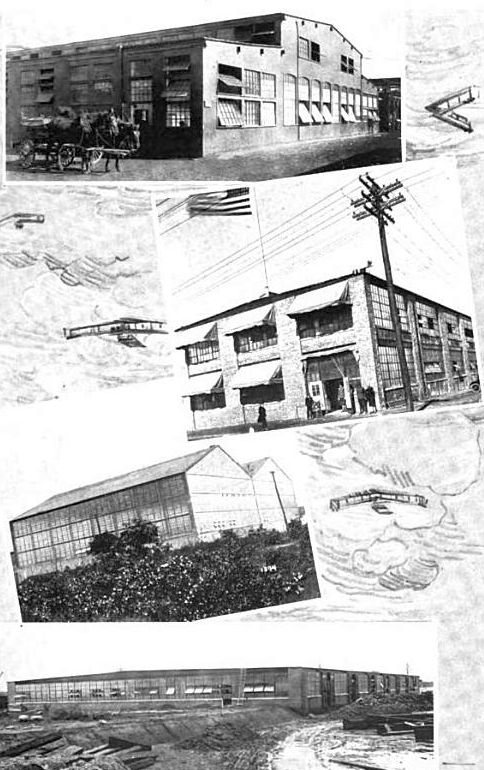
A 1919 photo of the Standard Aircraft Bayway factory buildings.
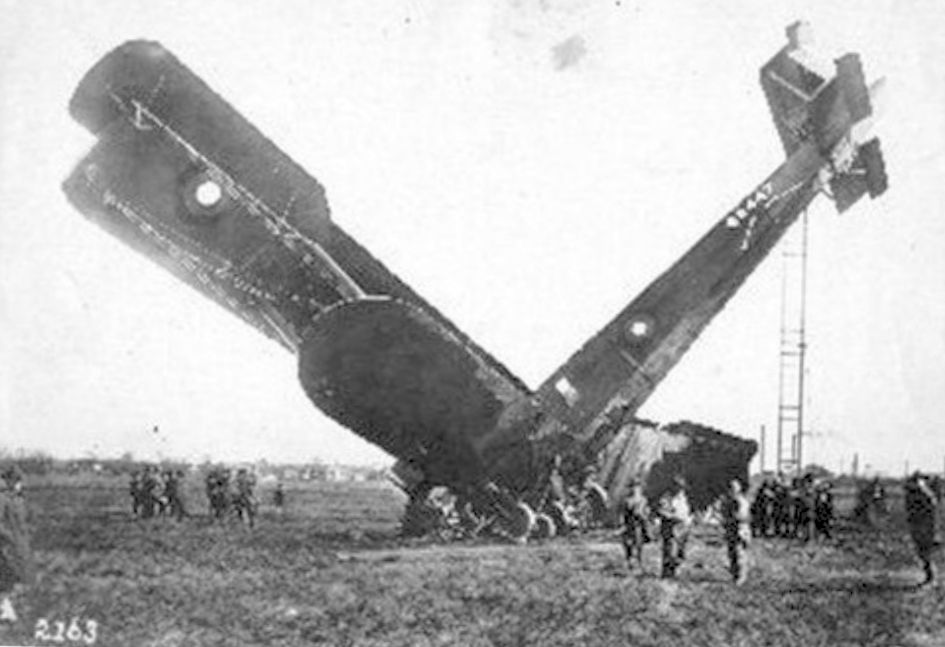
A 7/10/19 photo of a massive Handley-Page O/400 which crashed after takeoff from the Bayway Airfield.
According to Fred Cassel, “It didn't last long & they went under shortly after the war ended, as did the government's funding.”
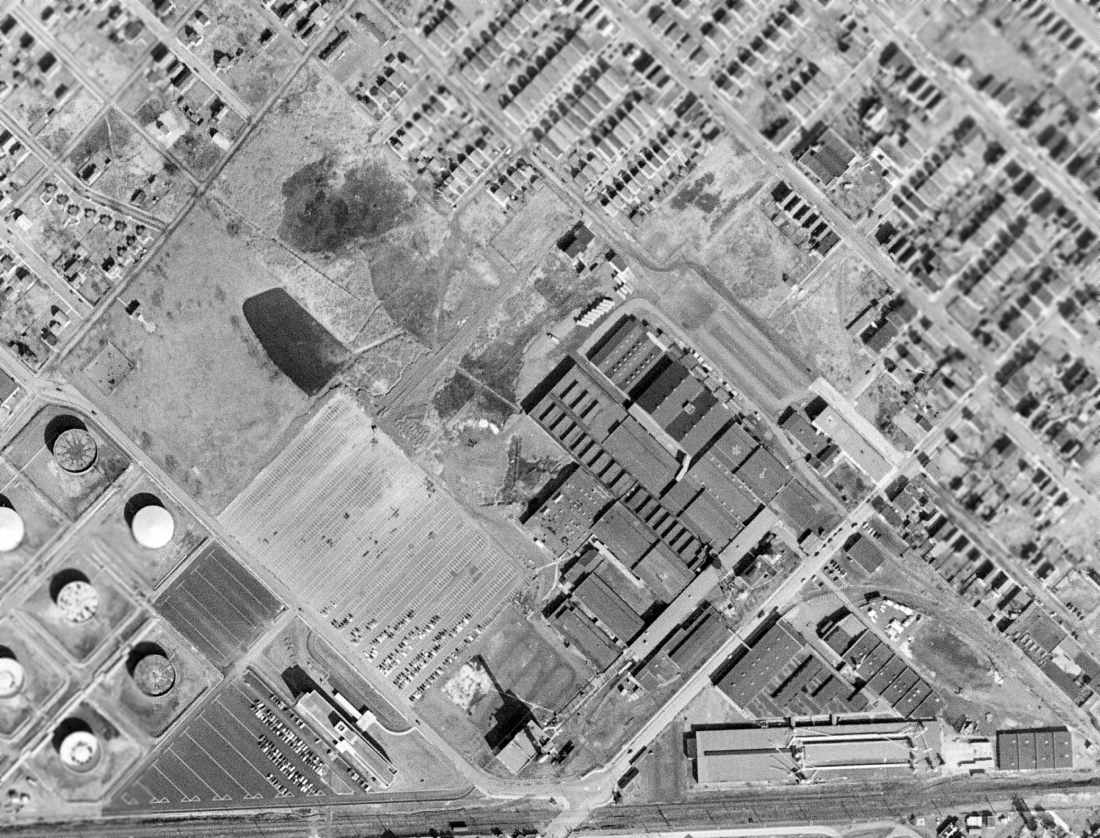
A 2/27/54 aerial view showed the Standard Aircraft factory buildings remained, with the clearing to the northwest (presumably the airfield) also remaining largely clear.
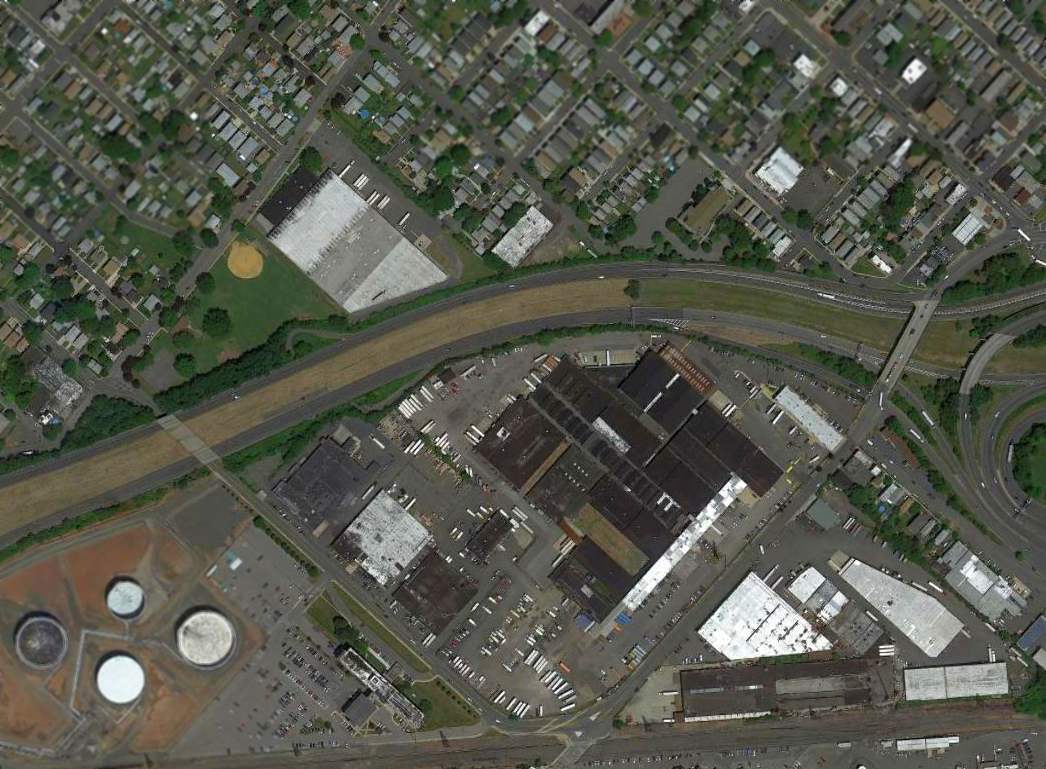
A 2010 aerial view showed the Standard Aircraft factory buildings remained, but Interstate 278 cuts through the area of the former airfield.
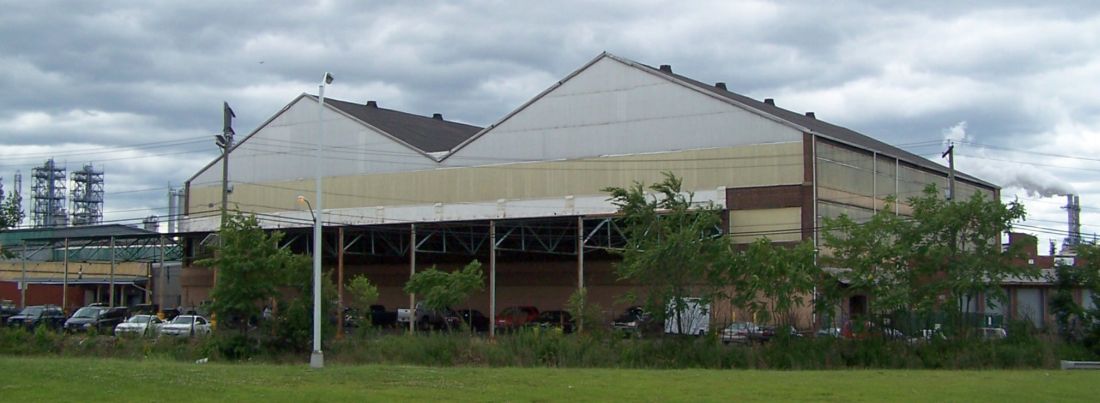
A 1/16/12 photo by Fred Cassel of the Standard Aircraft “double-truss main assembly building”,
the same building as shown in the 1919 photo above, showing it “as it looked when first built in 1917.”
Fred Cassel reported in 2014, “Remarkably, most of this complex has survived to this day, while its former history has been long forgotten.
Today, all of the buildings have been combined into one massive large warehouse complex,
but [aerial photos] clearly show the rooflines of the original structures.
The 1917 H-P O/400 assembly building is still a stand-alone building with a distinct double-truss roof.
Millions of cars pass right by this building every day on their way from NJ into Staten Island, completely unaware of the history of these buildings.
The airstrip has been replaced by Route 278 as it leads to the Goethals Bridge.
We are soon approaching the 100th anniversary of the beginning of this ambitious, if short-lived, company
and I am hoping to publish a modest book about the company's history & it's manufacturing plant also located here in Linden.
Part of my goal is to have marker added to the buildings commemorating their aviation history.”
Fred requests that anyone having more information about the Standard facility email him.
The site of the Standard Aircraft factory airfield is located west of the intersection of Interstate 278 & Brunswick Avenue.
Thanks to Fred Cassel for pointing out this airfield.
____________________________________________________
Woodbridge Airport / Shinn-Woodbridge Airport, Woodbridge, NJ
40.576, -74.333 (West of New York, NY)
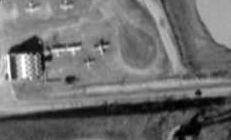
A 1947 aerial photo depicted several planes parked around the southern end of Woodbridge Airport.
Nothing but open land was depicted at this location on a 1940 aerial photo.
Woodbridge Airport was evidently established at some point between 1945-47 (like hundreds of other small airports in the post-WW2 general aviation boom),
as it was not yet depicted on the 1945 NY Sectional Chart.
The earliest depiction which has been located of Woodbridge Airport was a 1947 aerial photo.
It depicted 2 paved runways in an “X” shape,
with a single hangar & 11 light planes on the south side.
The Garden State Parkway was under construction directly adjacent to the east side of the airport.
Strangely, the 1947 USGS topo map didn't depict Woodbridge Airport at all.
George Manser recalled of Woodbridge Airport, “It was located on Oak Tree Road in what is now Iselin, part of Woodbridge Township.
The northern border was New Dover Road, the west side Wood Avenue and east side was absorbed by the Garden State Parkway.
It was south of Westfield Airport about 1 or 2 miles.
It had an administration building & paved runways.”
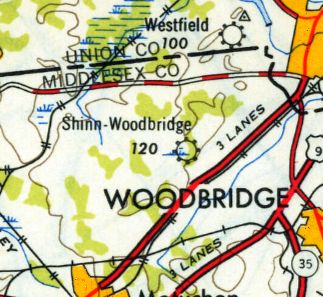
The 1949 USGS topo map depicted “Shinn-Woodbridge” as a commercial/municipal airport.
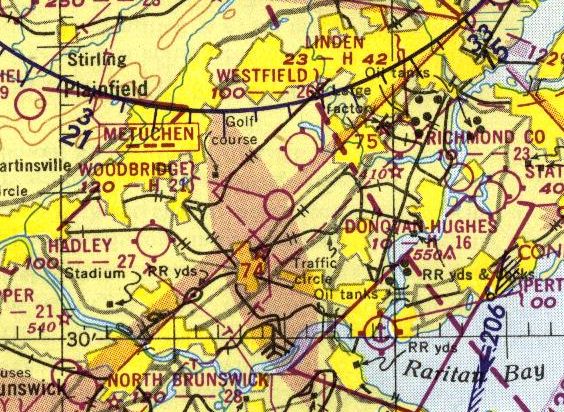
The only aeronautical chart depiction which has been located of Woodbridge Airport was on the 1950 NY Sectional Chart (courtesy of Mike Keefe).
It depicted Woodbridge as having a 2,100' paved runway.
Woodbridge Airport was evidently closed at some point between 1950-54, lasting no more than 9 years,
as a 1954 aerial photo showed the site covered with housing, with no trace remaining of the little airport.
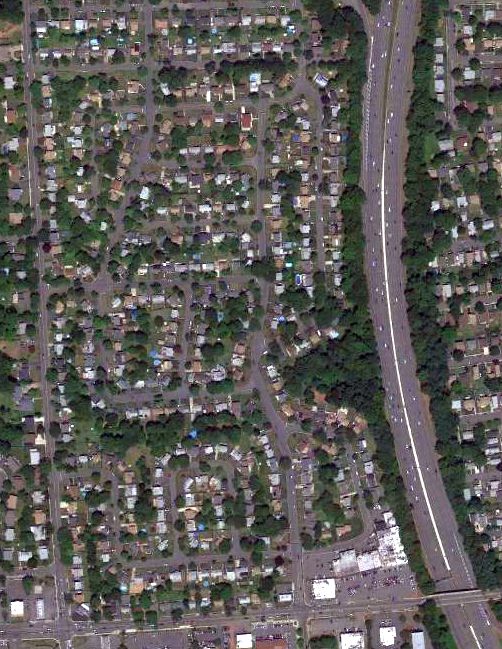
A 6/17/10 aerial photo showed no trace remaining of Woodbridge Airport.
George Manser reported in 2013, “There is a Shop Rite Market located in the same area as the administration building.”
Thanks to George Manser for pointing out this airfield.
____________________________________________________
Somerset Hills Airport (N64), Basking Ridge, NJ
40.693, -74.535 (West of New York, NY)
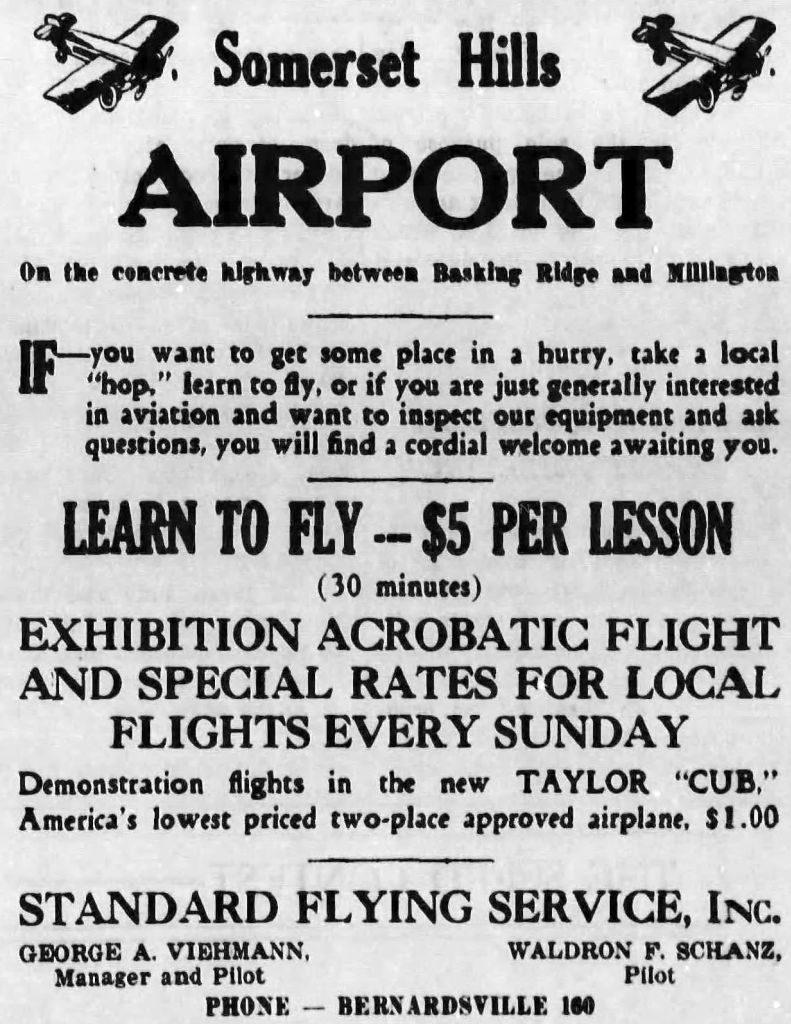
An advertisement for the Somerset Hills Airport from the 8/4/32 Bernardsville News (courtesy of Lee Corbin).
According to an article entitled “Basking Ridge plans for airport approved” in the 7/14/32 Bernardsville News (courtesy of Lee Corbin),
“Plans for an airport for Basking Ridge have been approved by the commissioner of aviation,
and George Viehman has begun leveling the field & building a hangar & office structures.
The work is being done on the Walter Fenner property in Building Lane.”
The earliest reference which has been located to the Somerset Hills Airport was an advertisement in 8/4/32 Bernardsville News (courtesy of Lee Corbin).
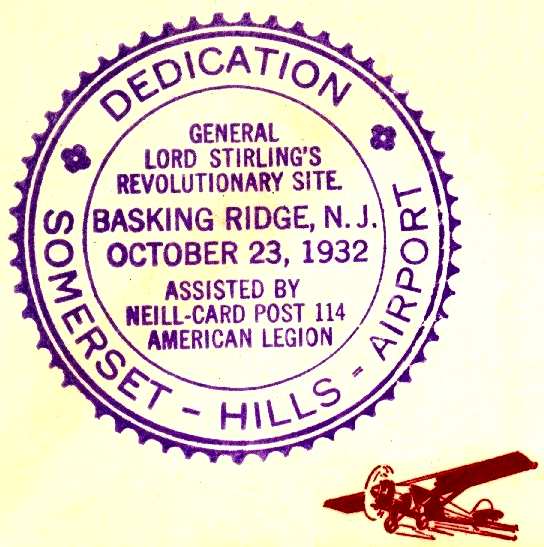
A postmark commemorating the 10/23/32 Somerset Hills Airport dedication (courtesy of Ed Drury).
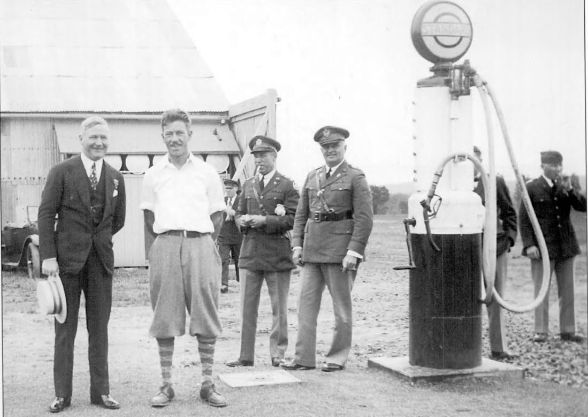
The earliest photo which has been located of Somerset Hills Airport was a 1932 photo (courtesy of Lee Corbin)
of Governor Harry Moore (at left) upon his arrival at the airport on a visit to the Lyons U.S. Veterans' Hospital.
Greeting the governor was Somerset Hills Airport manager & head instructor Wally Shantz, and to the right were several Army personnel.
Lee Corbin observed, “I love seeing all the Army guys with cigars & cigarettes milling around the fuel pump.”
The 1934 Department of Commerce Airport Directory (according to Chris Kennedy)
described Somerset Hills Airport as having 3 sod runways, with the longest being a 1,900' east/west strip.
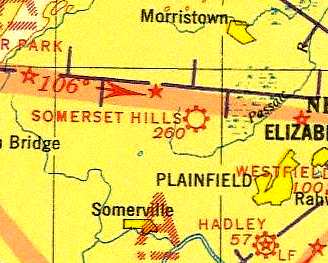
Somerset Hills Airport, as depicted on the 1935 Regional Aeronautical Chart.
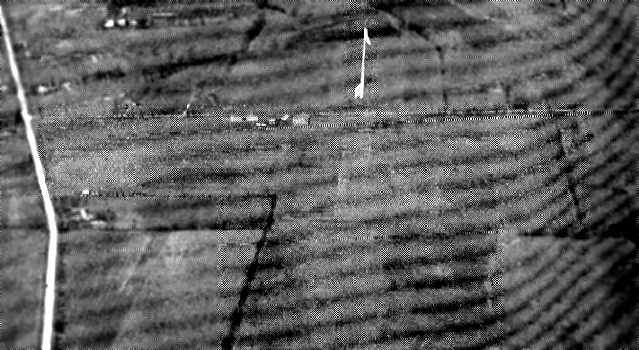
The earliest aerial photo which has been located of Somerset Hills Airport was an undated aerial view looking north
from The Airport Directory Company's 1937 Airports Directory (courtesy of Bob Rambo).
It described Somerset Hills as having a total of 3 sod runways,
with the longest being a 2,600' east/west strip.
The aerial photo depicted several hangars along the north side of the field.
According to a historical sign commemorating Somerset Hills Airport,
it served as an Army Air Corps flight training facility starting in 1941.
The 1944 US Army/Navy Directory of Airfields (courtesy of Ken Mercer).
described Somerset Hills as having a 2,200' runway.
According to a historical sign commemorating Somerset Hills Airport,
the Army Air Corps' use of the field ended in 1945.
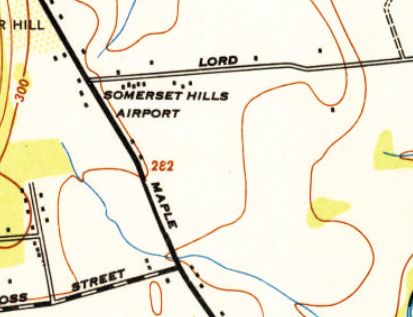
The 1947 USGS topo map depicted Somerset Hills Airport as an open area with several small buildings along the north side.
A 1956 aerial photo depicted Somerset Hills as having 3 unpaved runways,
and a hangar on the north side of the field, near which were parked over 25 light aircraft.
A 1957 aerial photo depicted the field in the same manner.
Paul Downing recalled, “Regarding Basking Ridge, as Somerset Hills Airport was more commonly known back in 'the day',
I soloed there on my 16th birthday & got my Private license one year later on my 17th.
This would have been July, 1957 & 1958.
At that time the airport was owned by Harry Calvin, a 707 flight engineer with Pan Am based in New York.
Rick Decker operated the airport, having moved up there when Westfield Airport closed.
Rick's brother in law, Richard 'Brick' Karl came with him as mechanic.
There was always a carnival atmosphere around the airport, always something going on.
The towns people would come out in droves,
filling up the parking lot waiting for the impromptu airshow that would always take place, Ed Mahler usually starting it.”
Paul continued, “Rick had an old fashioned bicycle - 5' front wheel, 1' rear wheel - that he kept at the airport.
We found several rolls of theater tickets in the attic of the tiny office as well as an old PA system that still worked.
We set up the PA, someone played a guitar & sang, I rode the bike up & down the line
and we sold airplane rides for a penny a pound, made a lot of money,
kids were coming back 3 & 4 times, couldn't believe it.”
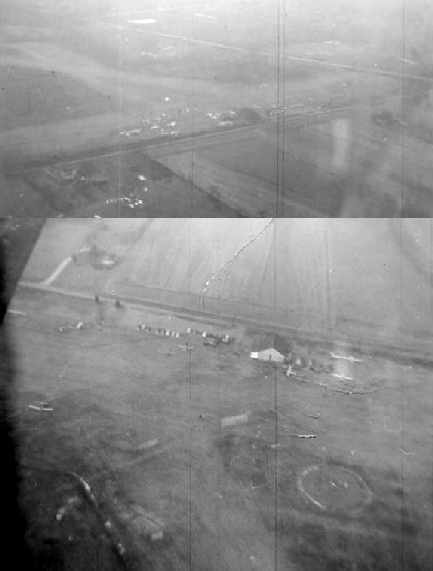
Two 1959 aerial photos of Basking Ridge Airport by Paul Downing.
Paul Downing recalled, “There was a farm house & barn just to the south of the approach end of the west runway
with power lines running from the street, across the end of the runway to the house.
The farmer refused to bury the lines which subsequently snagged aircraft over the years, though none fatally.
I think the lines were finally buried after I left.”
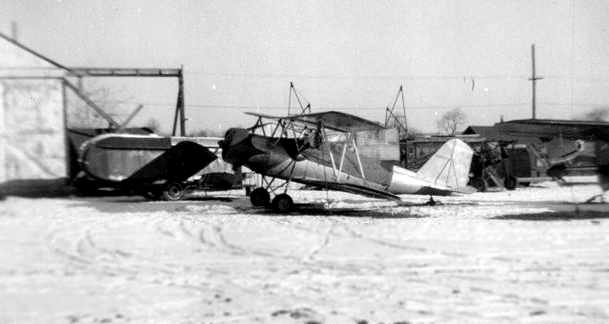
A 1959 photo by Paul Downing of a Meyers OTW at Basking Ridge.
Andy Wells recalled, “In the spring of 1961 (my senior year in high school),
I discovered that if I showed up at Basking Ridge with $6 (or more), I could get a short flying experience from Pop Decker in one of his 2 J-3 Cubs.
He would do the take off & quickly give me the controls. I was then free to fly around until my dollars were used up.
He never actually taught me anything at all, just let me experiment with the controls.
I was an experienced aeromodeler by then, so had an inkling of what to do.
I always managed to fly over to my home town of Cranford, make a few turns around the high school,
then get back to someplace near the airport, where Pop would take over with a big shake of the stick & make the landing.”
Paul Downing recalled, “Harry Calvin was transferred to Pan Am's SFO base,
Rick & Brick went down to run Kupper Field
and Jimmy, Harry's son, took over operations at Basking Ridge for awhile.
Harry was killed in an F4F accident on the west coast, I believe his wife sold the airport.”
The 1961 NY Local Aeronautical Chart (courtesy of Mike Keefe)
described Somerset Hills as having 3 turf runways, with the longest being 2,400'.
Somerset Hills Airport was described in the 1962 AOPA Airport Directory
as having with 3 turf runways (the largest being an 1,800' east/west strip).
and the operators were listed as Lawrence Tokash & James Stanley.
A 1963 aerial photo depicted Somerset Hills as having 3 unpaved runways,
and a hangar on the north side of the field, near which were parked over 20 light aircraft.
Kern Buck reported, “The best description of Somerset Hills Airport in the 1960s
appears in a book written by my brother, Rinker Buck, 'Flight of Passage'.
The flight described in the book began at Somerset Hills Airport.
Both Rinker & I made our 1st solo flights there, mine in 1964, Rinker's in 1966.”
Kern continued, “At that time, the field still had grass runways.
The main runway, 9/27 was about 2,500' long, with a very small hill at the east end,
the grade of which was no greater than the normal descent path of a light airplane.
Approaching from the west, one also descended over a declining grade,
with trees underneath & 25' wires over the threshold at Maple Avenue.
Runway 15 had a flat approach over open field,
but 10' wires over the dusty road leading from Maple Avenue to the airport parking lot.
The approach to Runway 33 was also relatively flat,
but there was a small housing development near the threshold,
and one of the houses had a TV antenna atop the roof.
The antenna was a factor for such a short runway.”
Kern continued, “The original operations building was still being used in the 1960s.
It was about the size of a child's playhouse, and had about 125 square feet of space inside.
The hangar was larger. It could hold 4 light airplanes, if they were positioned correctly.”
Kern continued, “At any one time during that era, the field was home for from 15-30 airplanes,
including civilianized World War II AT-6s, PT-19s, a PT-23, and a rare Meyers OTW.
There was also an assortment of Cubs, Aeroncas, Taylorcrafts, etc.”
Kern continued, “It was a great airport, somewhat unruly.
I recall Ed Mahler, who was a well known aerobatic pilot at the time,
flying his AT-6 on the deck toward the hangar at a speed approaching 300 mph before pulling straight up.
I was the only one looking at the time. I guess he was practicing.
He built his famous biplane, the PJ-260, in the hangar at Basking Ridge.”
The 1968 Flight Guide (courtesy of Robert Levittan) depicted Somerset Hills
as having 2 unpaved runways: 2,360' Runway 10/28 & 2,200' Runway 15/33.
Two small buildings were depicted on the north side of the field.
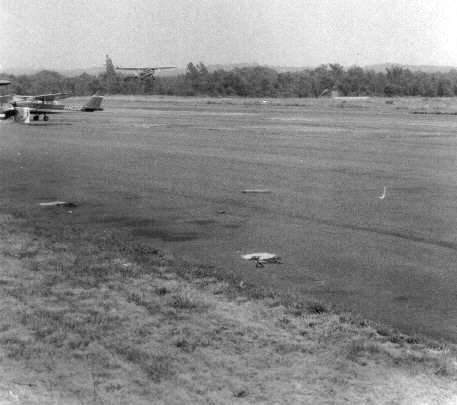
A 1970 photo of Somerset Hills Airport by Pete Galligan.
One runway at Somerset Hills was apparently paved at some point between 1962-70,
as Pete recalled that "at that time there was just one paved runway, and one grass."
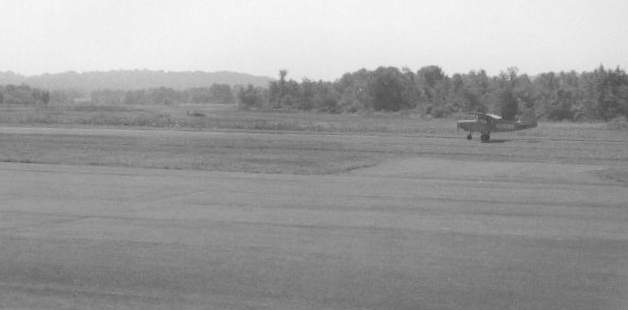
Somerset Hills Airport in 1970, by Pete Galligan.
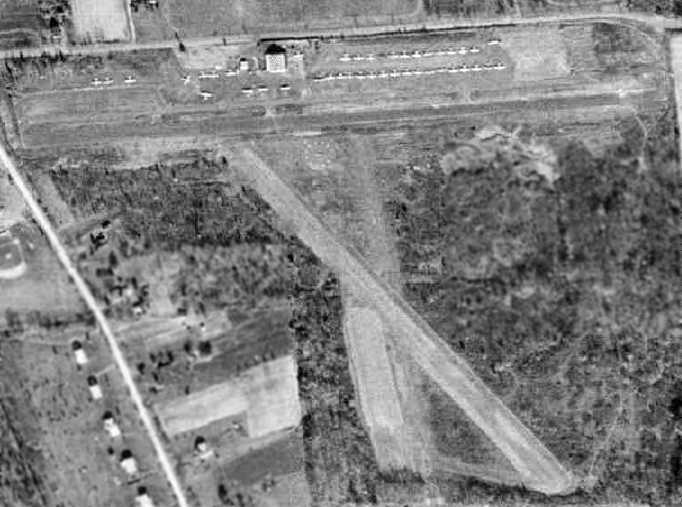
A 1970 aerial view depicted Somerset Hills' newly paved runway.
It also showed the field perhaps at its zenith of popularity,
with a total of over 37 light aircraft were visible parked on the north side of the field.
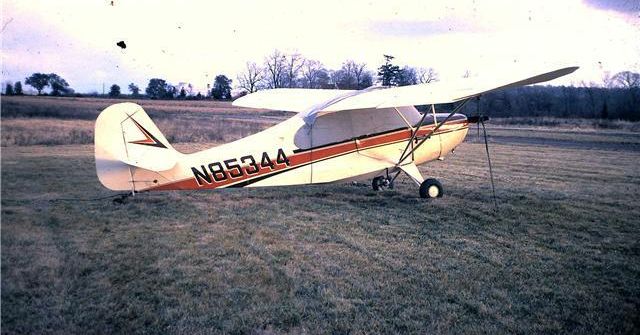
The last photo which has been located showing Somerset Hills Airport while open
was a circa 1972 photo of N85344, a 1946 Aeronca 7AC Champion, serial #7AC-4084.
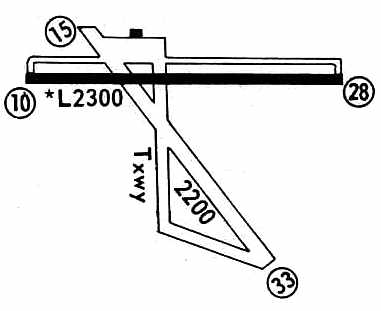
The 1972 Flight Guide (courtesy of Chris Kennedy)
depicted Somerset Hills as having a 2,300' paved Runway 10/28 & a 2,200' unpaved Runway 15/33.
A ramp on the northern side of the field had a single building along its northern edge.
About Somerset Hills Airport, Dennis Sandow recalled "I've lived under its traffic pattern since 1976.
The proximity caused me to become aware of GA & want to take up flying.
Between 1976 & about 1980, I don't ever recall seeing more than 6-10 based aircraft there."
Jan Wolitzky recalled, “I once visited the airport with my Grumman Cheetah N9734U during the late 1970s,
but with the surrounding trees I felt the field was too short for comfort.”
Niel Young recalled, “About 1978 there was a new maintenance & repair FBO who took over from Jim Calvin.
It was a successful operation that helped keep the airport going with 4 mechanics.
In the winter of 1979-80 the hangar burned down due to highly suspicious circumstances, with absolutely no connection to Calvin or the FBO.
I left the area shortly thereafter so I don't know the impact of the fire on the ultimate demise of the airport
but I'm sure the loss of the the FBO & the accompanying traffic contributed to it.
Up to that time it was a fairly active little airport.”
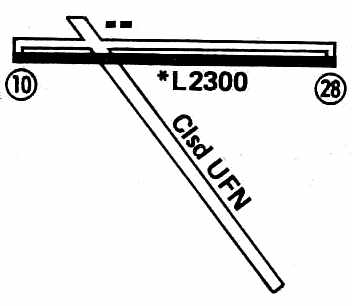
The 1979 Flight Guide (courtesy of Chris Kennedy)
showed that the crosswind grass runway was "Closed until further notice",
leaving the field's sole runway as the 2,300' paved Runway 10/28.
Two buildings were depicted on the north side of the field.
The last photo which has been located showing the Somerset Hills Airport in operation was a 1979 aerial view.
It depicted a very well-used little airport, with over 2-dozen light aircraft visible parked on the field.
The 1979 NY TCA chart (courtesy of Bill Suffa)
described Somerset Hills Airport as having a single 2,300' paved east/west runway.
Dennis Sandow recalled, "The legal issues started when a pilot landed short & hard (stalled turning final?)
on the athletic field of the high school about half mile west of the runway - about 1980.
The town quickly turned negative, and everything was downhill from then on."
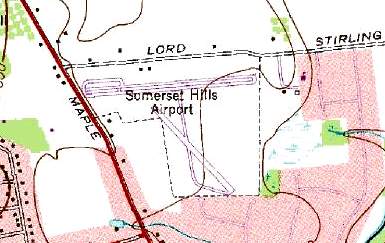
As depicted on the 1981 USGS topo map,
the airfield consisted of 2 paved runways (the largest was 2,400' long) & several taxiways.
Dennis Sandow recalled, ""The AT&T operating Headquarters was located less than 2 miles away,
but the official corporate Headquarters was still in NYC.
In April 1982, I last flew out of the field in a charter helicopter,
which regularly used the field to pick up & deliver AT&T execs flying into NYC.
At that time, the FBO was closed & there were no based aircraft left on the field."
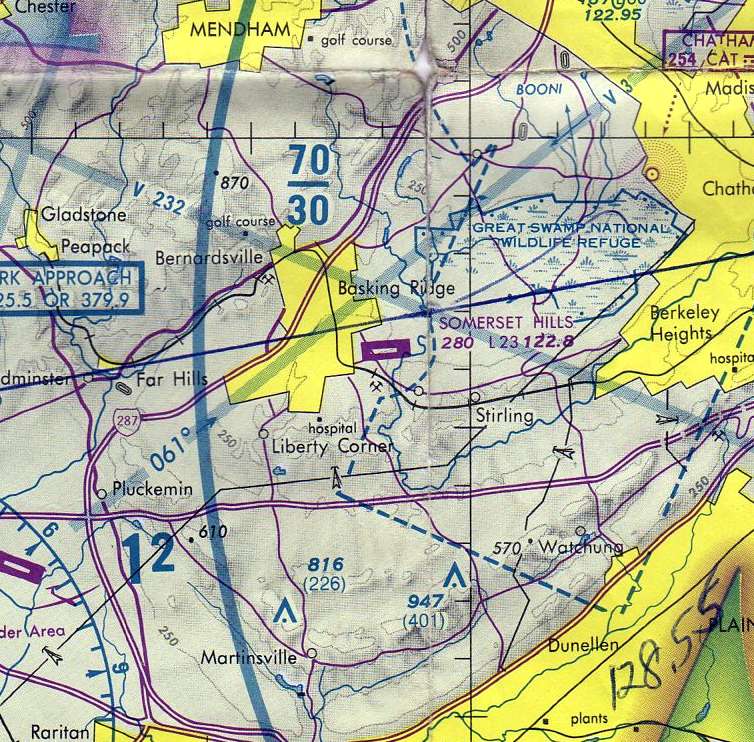
The last aeronautical chart depiction which has been located of Somerset Hills Airport
was on the June 1982 NY Terminal Aeronautical Chart (courtesy of Mitchell Hymowitz).
It depicted Somerset Hills Airport as having a single 2,300' paved east/west runway.
In a 1996 report by the New Jersey General Aviation Study Commission's Subcommittee on Airport Closings,
reasons were given for the closing of 13 New Jersey general aviation airports.
According to the report, in its final 16 years of operation,
Somerset Hills Airport saw its taxes rise 500%, from $2,000 / year to $10,000 / year.
The report also pointed out that litigation costs for development of small airports
had become enormous, discouraging airport growth.
At one point late in its existence, the owners of Somerset were trying to build 20 T-hangars,
but found their litigation expense equaled the expense of the improvements they were intending to make.
According to an article entitled “Airport to close October 15 for housing complex” in the 9/15/82 Bernardsville News (courtesy of Lee Corbin),
“Townhouses & single-family homes will soon replaced planes at the Somerset Hills Airport.
The airport, established 50 years ago, will close October 15.”
Somerset Hills Airport was was no longer listed among active airfields in the 1983 Flight Guide (according to Chris Kennedy).
By the time of the 1986 USGS topo map, it was labeled "Airfield (Abandoned)".
A 1987 aerial photo showed that housing had covered the site, with not a trace recognizable of Somerset Hills Airport.
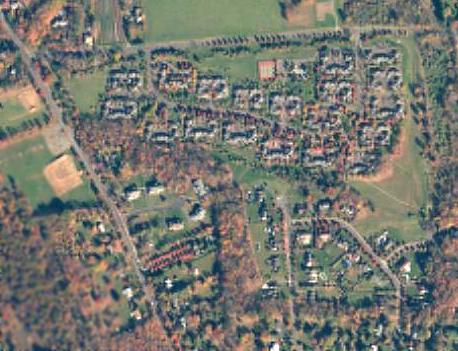
A circa 2001 aerial photo showed the site of Somerset Hills Airport had been completely redeveloped as a condominium complex,
with not a trace recognizable remaining of the airfield.
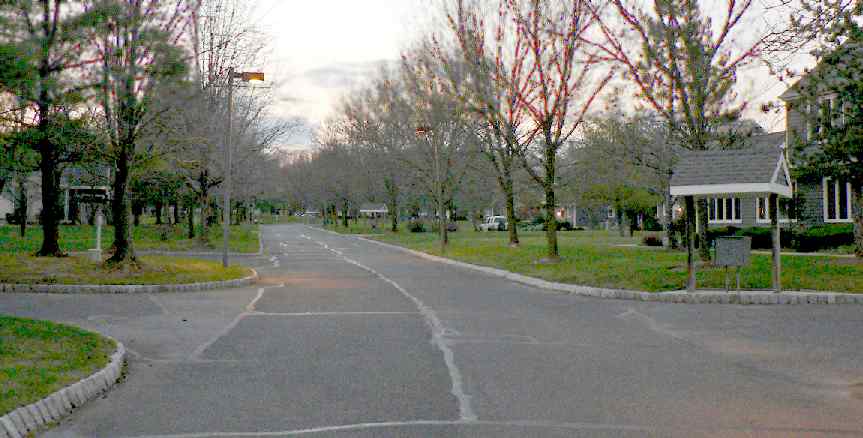
A December 2006 photo by Daniel Berek of the site of Somerset Hills Airport, now covered with housing.
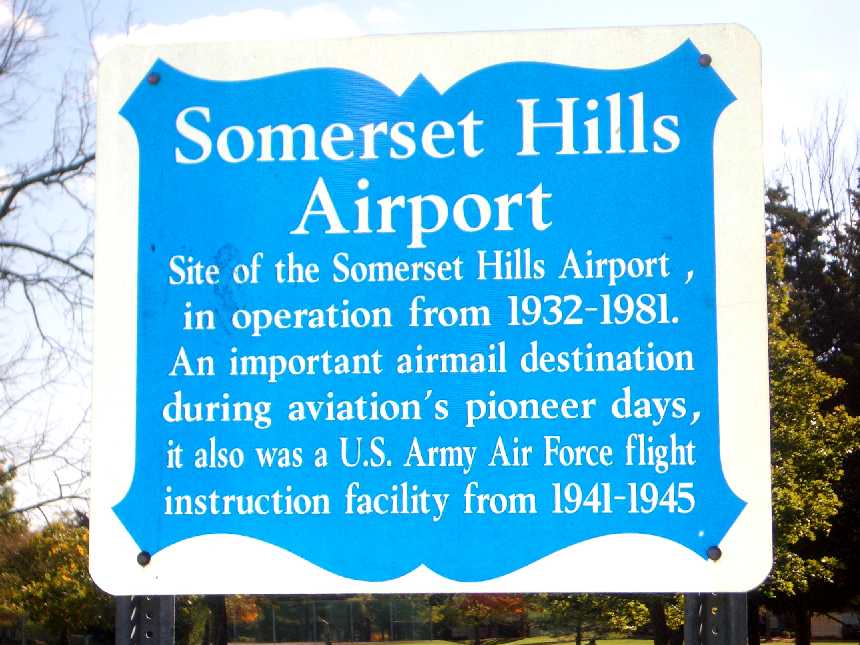
A 2008 photo by Jan Wolitzky of a historical sign which commemorates the site of Somerset Hills Airport.
The site of Somerset Hills Airport is located
southeast of the intersection of Maple Avenue & Lord Stirling Road.
Thanks to James G. for pointing out this airfield.
____________________________________________________
40.428, -74.188 (South of New York, NY)
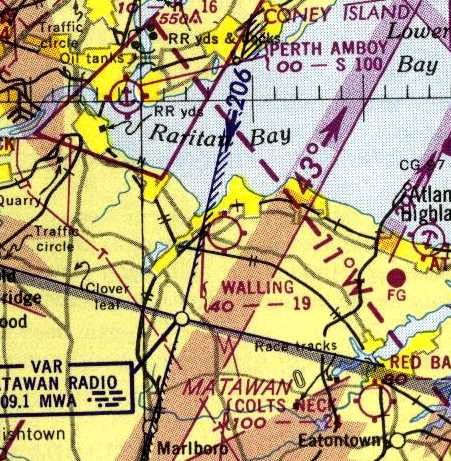
Walling Airport, as depicted on the 1950 NY Sectional Chart (courtesy of Mike Keefe).
This small general aviation airport was evidently established at some point between 1940-47,
as it was not yet depicted on a 1940 aerial photo.
The earliest depiction which has been located of Walling Airport was on a 1947 aerial photo.
It depicted the field as having 2 perpendicular grass runways, with 3 single-engine aircraft parked near some small buildings on the north side.
Walling Airport was not yet depicted on the 1947 USGS topo map.
Dick Lewis recalled, “Walling's Airport... As a teenager in the 1940s, I assisted passengers for a sight-seeing operation using a 'Standard' biplane.
The aircraft had a 4-seat front cockpit & my 'pay' was filling the occasional empty seat.”
The earliest aeronautical chart depiction which has been located of Walling Airport
was on the 1950 NY Sectional Chart (courtesy of Mike Keefe).
It depicted Walling as having a 1,900' unpaved runway.
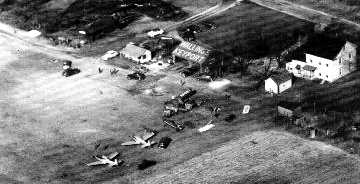
An undated (circa 1950s?) photo showing several aircraft parked near a hangar painted with “Walling Keyport”.
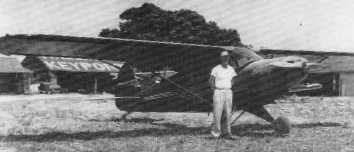
An undated (circa 1950s?) photo of an unidentified man in front of a Piper Cub, with the “Walling Keyport” hangar in the background.
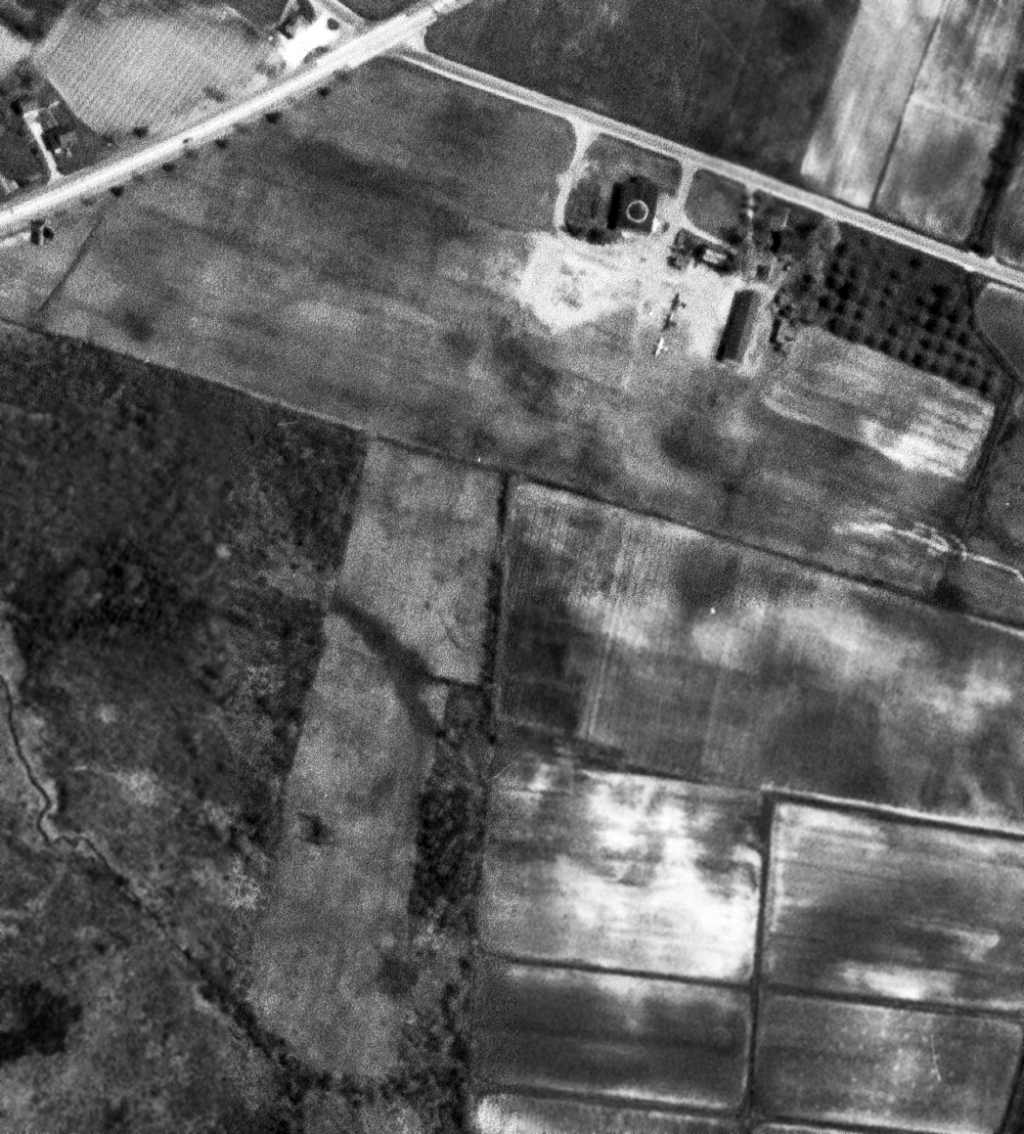
A 4/24/53 USGS aerial photo depicted a few buildings that had been added at some point between 1947-53.
A total of 3 single-engine aircraft were visible on the field.
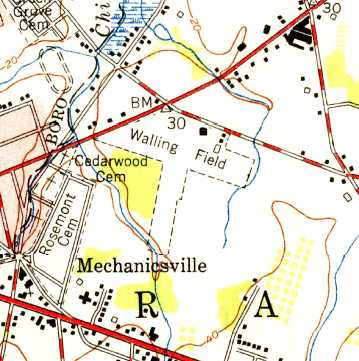
The 1954 USGS topo map depicted Walling Field as having 2 unpaved runways, with several buildings along the northeast side.
An article entitled “Plane just borrowed” in the 7/12/54 Schenectady Gazette
reported that a man stole a plane from Walling Airport & flew it to nearby Red Bank Airport.
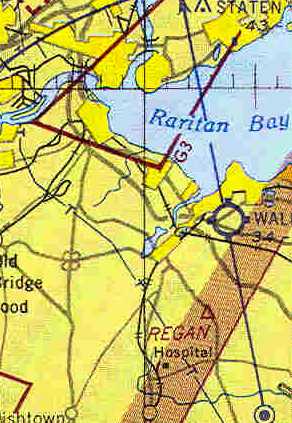
The last depiction which has been located of Walling Airport
was on a truncated portion of 1955 NY Sectional Chart (courtesy of Chris Kennedy).
It depicted Walling as having a 1,900' unpaved runway.
Walling Airport was evidently closed (for reasons unknown) at some point between 1955-57,
as the airport was no longer depicted on the 1957 NY Sectional Chart,
but its memory was commemorated by an aeronautical intersection, “Walling”, over the airport site.
A 1957 aerial photo showed the airport's demise compared to the 1953 photo:
new houses covered the southern half of the airport site,
and the northern half had been scraped clean, for new construction.
A 1963 photo showed that houses & a shopping center had covered the site of Walling Airport,
with no trace remaining.
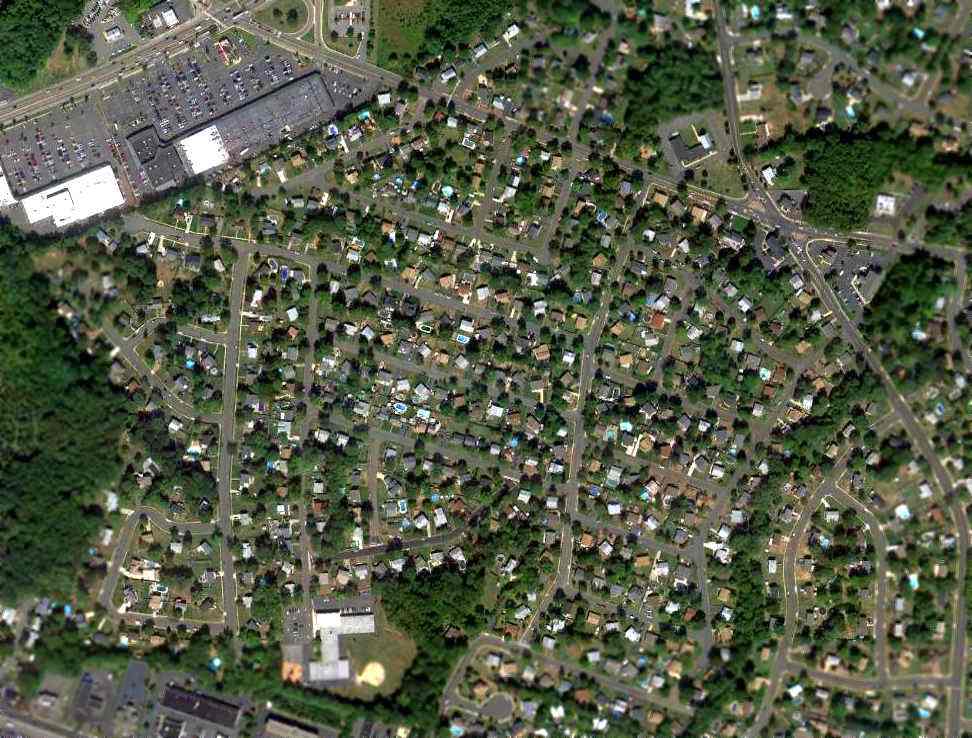
A 9/21/10 aerial view showed no trace remaining of Walling Airport.
As of 2011, the shopping center on the site of Walling Airport continues to be known as Airport Plaza.
The site of Walling Airport is located southeast of the intersection of Route 36 & Middle Road.
____________________________________________________
Hadley Field, South Plainfield, NJ
40.556, -74.43 (Southwest of New York, NY)
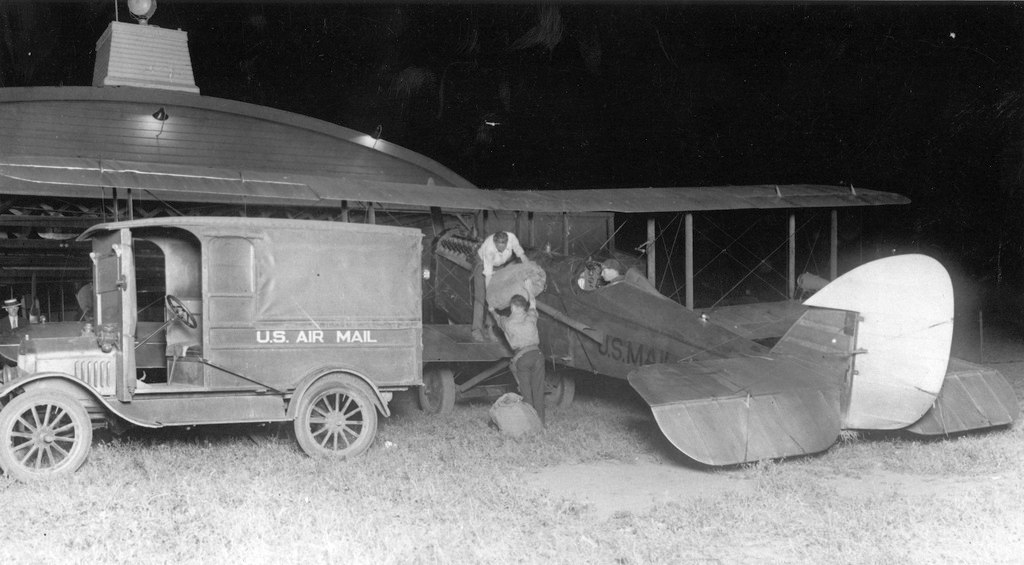
A 1925 photo of postal employees loading an Airmail deHavilland at Hadley Field at night.
As Post Office plans for inaugurating night airmail progressed,
it became apparent that New York's Hazlehurst Field, often blanketed in fog & smoke, proved sadly inadequate.
What was needed was an area allowing clear approach from all directions
and the establishment of improved terminal facilities.
Officials set out locating the ideal location;
in short order they found one, not in New York but in neighboring New Jersey.
On 11/1/24, John Hadley leased to the Post Office 77 acres of level ground 5 miles from New Brunswick, NJ,
for a new landing field to be called Hadley Field.
Immediately, preparations began, land was cleared, radio masts erected,
boundary lights installed, and provisions established for floodlights & revolving beacons.
So rapid was the construction that by December 15
daytime transcontinental operations shifted from Hazlehurst to Hadley.
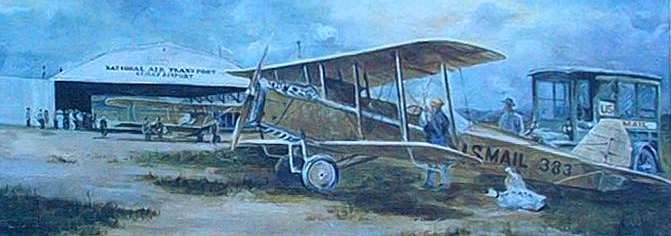
A painting of airmail operations at Hadley Field in 1925 (courtesy of Ed Drury).
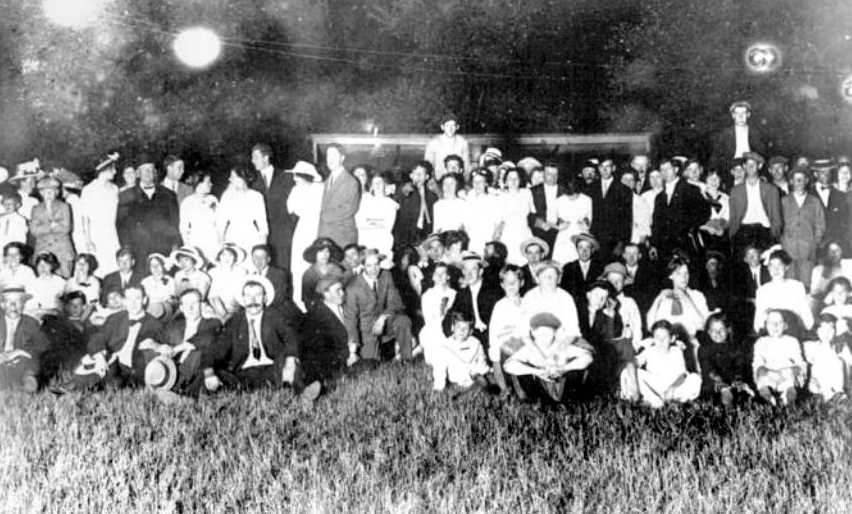
A 7/1/25 photo of the crowd gathered at Hadley Field to witness the first transcontinental night airmail flight.
On the night of 7/1/25, 500,000,000-candlepower arc floodlights swept the field for nearly a mile in half a circle.
A powerful searchlight stood on top of a hangar revolving six times a minute.
All was in readiness for the inaugural night flight
for which more than 15,000 people had turned out
to watch Dean Smith & J.D. Hill lift into a moonlit sky on their way to Cleveland.
As described by Dean Smith in "By the Seat of My Pants",
after the goodbyes & handshakes trouble awaited him:
"...I climbed in the DH-4. The newsreel cameras were grinding.
I ran up the engine & roared down the field.
As I was still climbing, not yet a hundred feet high,
the engine suddenly revved down as though the throttle had been pulled back.
Praise be, I managed to make a full one-eighty turn & straighten out,
floating back in over the fence, the engine not quite dead.
Examination disclosed that a pin connection in the throttle rod had broken,
and the butterfly valve in the carburetor had consequently slipped back.
That 1st night the rod was quickly repaired, and I took off toward Bellefonte with little total delay."
Smith's problems were far from over.
Engine failure forced him down again near Kylertown, PA.
Dropping his parachute flare, he landed in a small emergency field.
Two hours later he left for Cleveland in another plane
but ran out of gas fifteen minutes short of Cleveland & crashed landed,
unhurt but upside down with crumpled wings in a farmer's vineyard.
"Hmm," the farmer said looking at the crash, "Do you always land this way?"
J.D. Hill had better luck than Smith, his mail got through,
and the 1st inaugural flight out of Hadley Field was deemed a success.
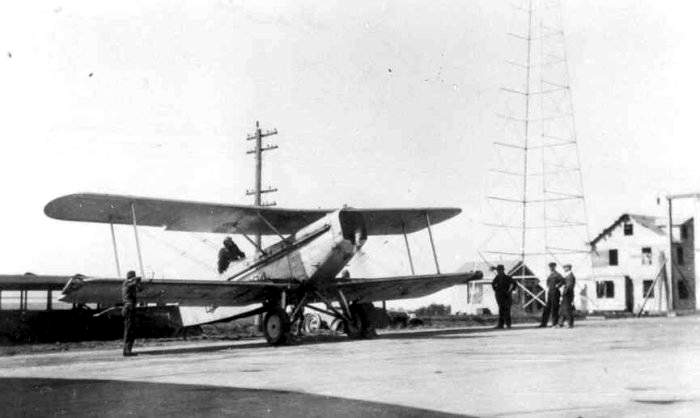
A circa 1925-28 photo of a Douglas M1-M4 airmail biplane, preparing to depart from Hadley Field.
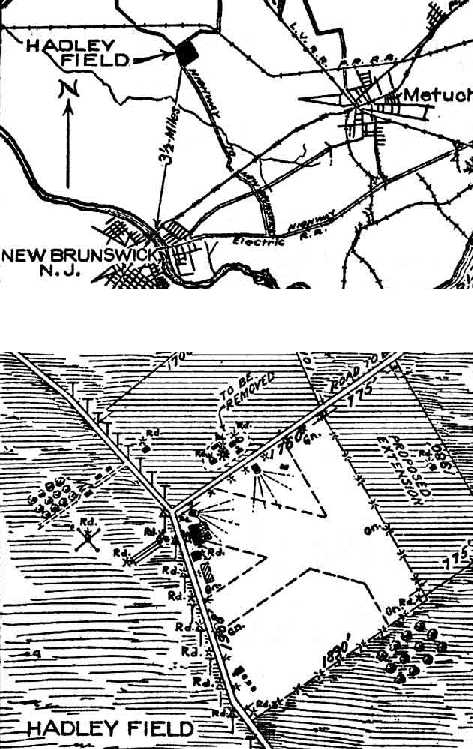
The location & layout of Hadley Field, as depicted on the 1927 Commerce Department Airway Bulletin (courtesy of David Brooks).
It described Hadley as a 141 acre rectangular sod field having 3 runways.
A single hangar was depicted on the northwest side.
David observed, “Of interest on the Hadley field are 2 floodlights & they used lines radiating out for them.”
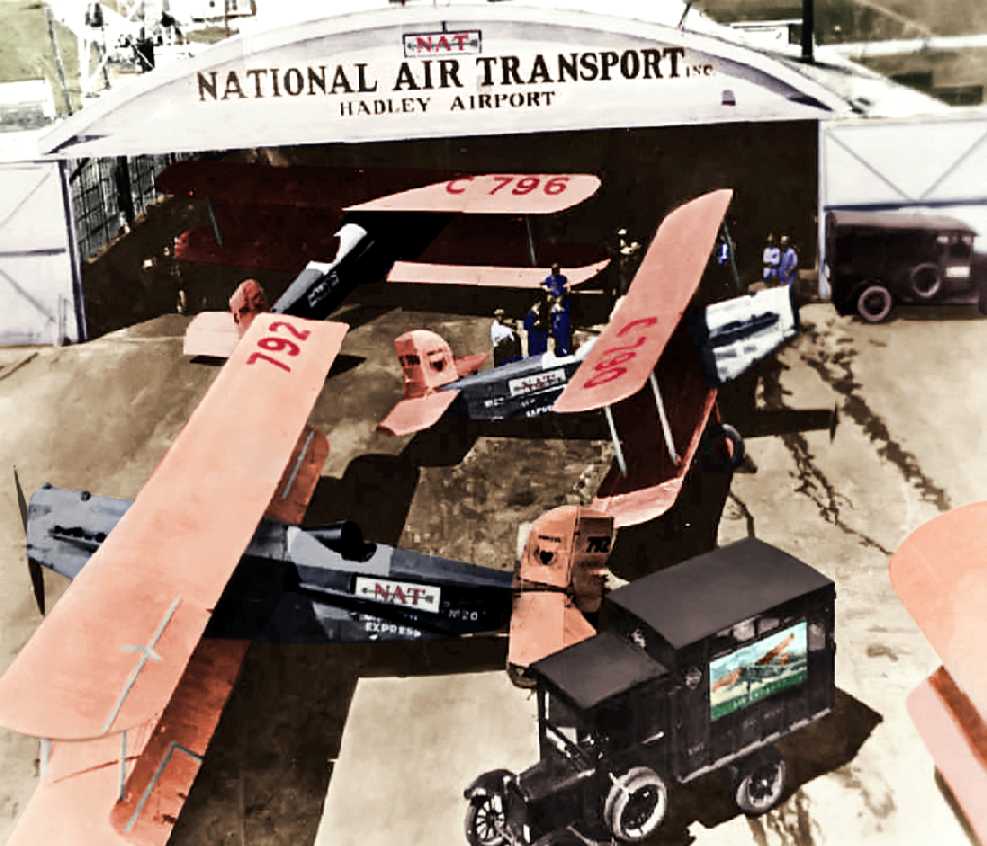
A 1927 photo of "The scene at Hadley Field, as 4 airlines & Railway Express Agency
began the 1st express & mail flights coast-to-coast" (courtesy of Karen Sindt, colorized by Joe Orth).
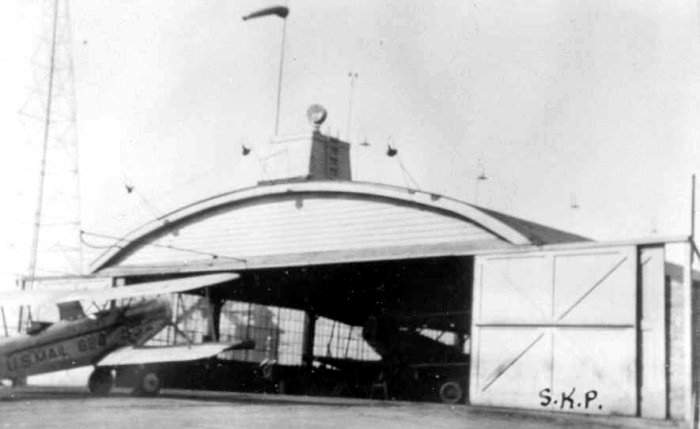
A pre-1929 photo of an unidentified airmail biplane in front of a hangar at Hadley Field.
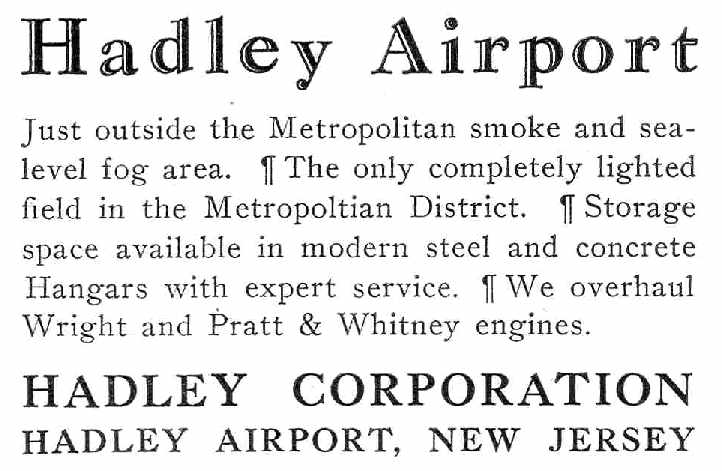
An advertisement for Hadley Airport from the 9/15/28 issue of Aviation Magazine (courtesy of Chris Kennedy).
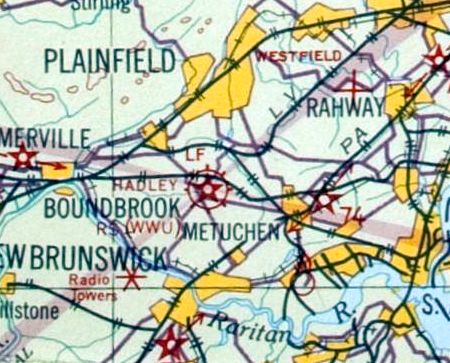
The earliest aeronautical chart depiction which has been located of Hadley Field
was on the November 1931 NYC-Albany Air Navigation Map.
A 1931 aerial view depicted Hadley Field as a square-shaped grass field,
with 2 hangars along the west side of the field.
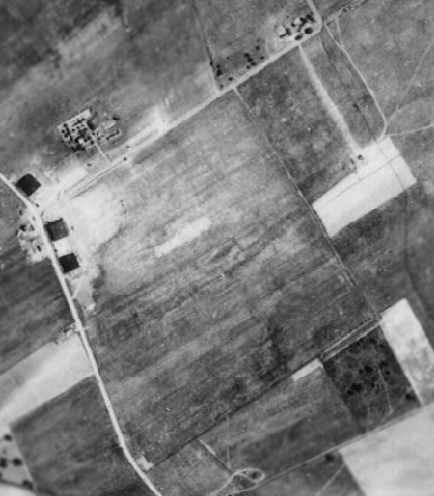
A circa early 1930s aerial view depicted Hadley Field as a square-shaped grass field,
with 2 hangars along the west side of the field.
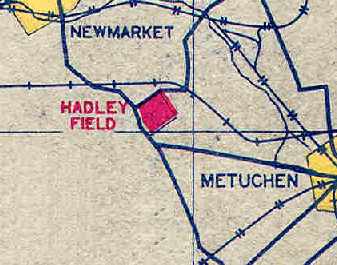
The 1934 U.S. Navy Aviation Chart (courtesy of Chris Kennedy)
depicted Hadley Field s consisting of a roughly square-shaped field.
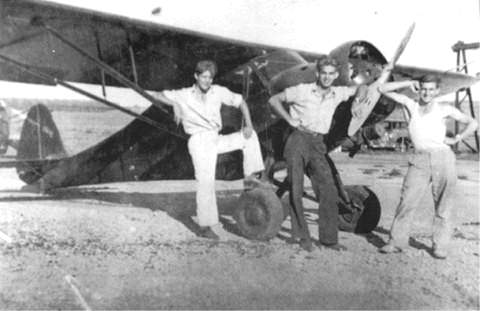
The Allen brothers & a friend, posing in front of an unidentified aircraft at Hadley Field, circa 1934.
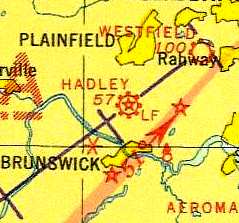
Hadley Field, as depicted on the 1935 Regional Aeronautical Chart.
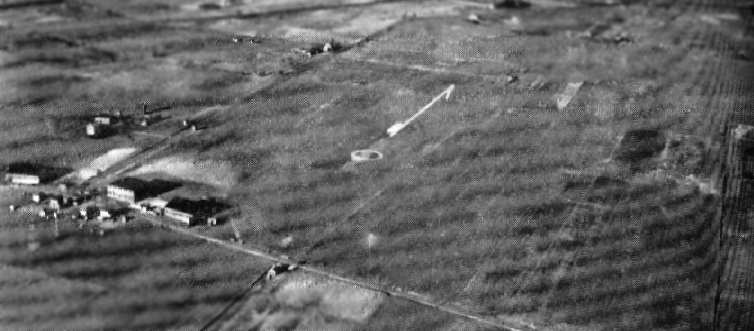
An aerial view looking northwest at Hadley Field,
from the Airport Directory Company's 1937 Airports Directory (courtesy of Bob Rambo).
The directory listed Hadley Field under the name of "New Brunswick",
without referring to the actual name of the airfield, inexplicably.
It described the field as consisting of a 1,900' sod square,
and pictured 2 hangars along the southwest corner of the field.
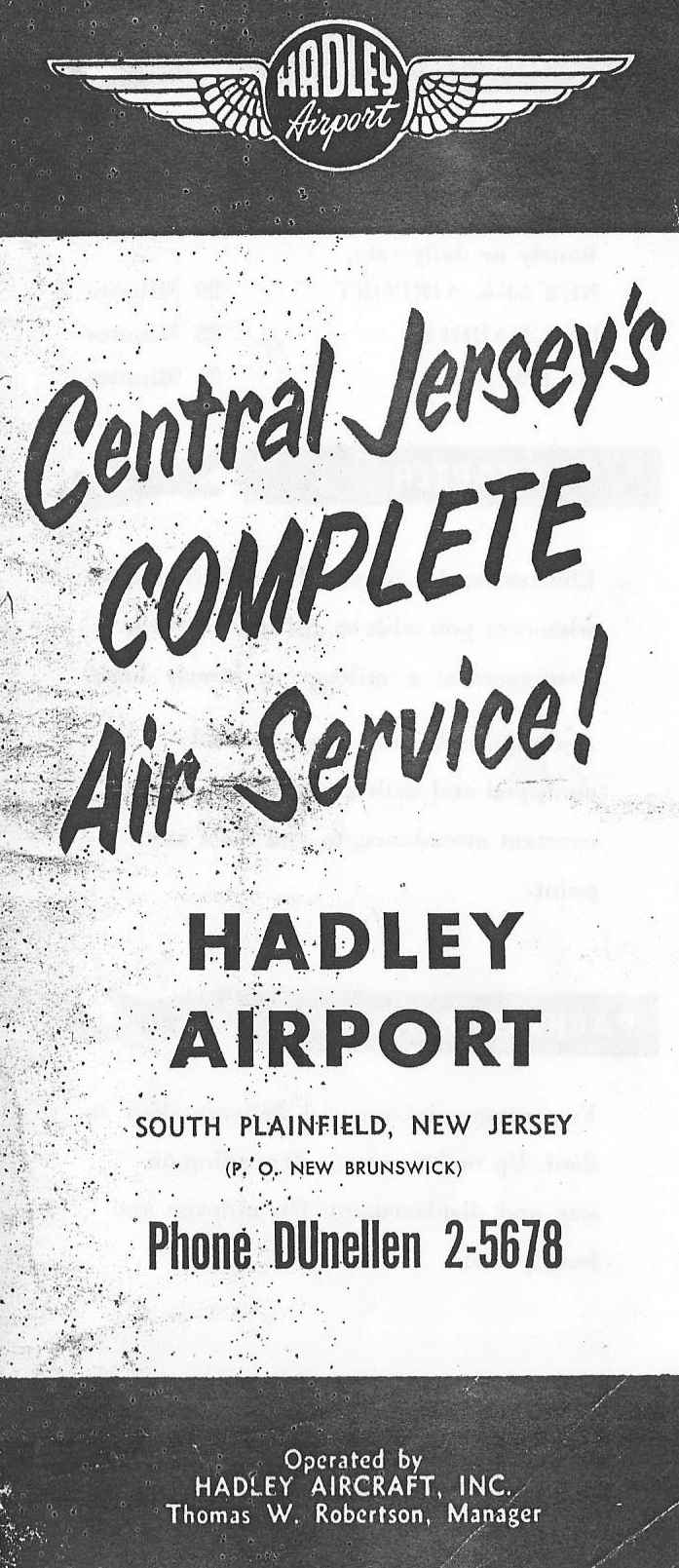
A crica 1930s brochure for Hadley Airport (courtesy of Khadi Madama).
Khadi
Madama recalled, “My father, Anthony [Madama] had served as a
photographer on location between 1939 & up until WW2
filming almost all of the Civil Air Patrol maneuvers that occurred at Hadley Airport.”
A 1940 aerial view depicted Hadley Field as a square-shaped grass field,
with 2 hangars along the west side of the field.
Several light aircraft were visible around the hangars.
Jacqueline Beusse recalled, “My mother won a contest at Hadley Airport when I was 4.
She was always interested in aviation. Her prize was a flight in an open-cockpit aircraft.
My father held onto my hand with my brother holding his other hand.
I remember the plane in the air. But not much more.
Much later I was told the pilot of the plane my mother was a passenger in was a stunt pilot and also carried mail for US Mail Service.
I do not think there was any tower in 1940.”
The 1944 US Army/Navy Directory of Airfields (courtesy of Ken Mercer)
described Hadley Field as having a 2,700' unpaved runway.
The remarks said, "Restricted to Civil Air Patrol" (most likely a temporary measure during WW2).
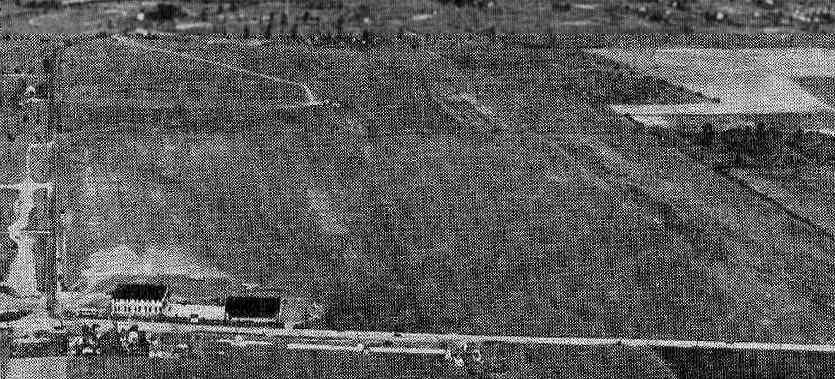
An aerial view of Hadley Field from the Haire Publishing Company's 1945 Airport Directory (courtesy of Chris Kennedy).
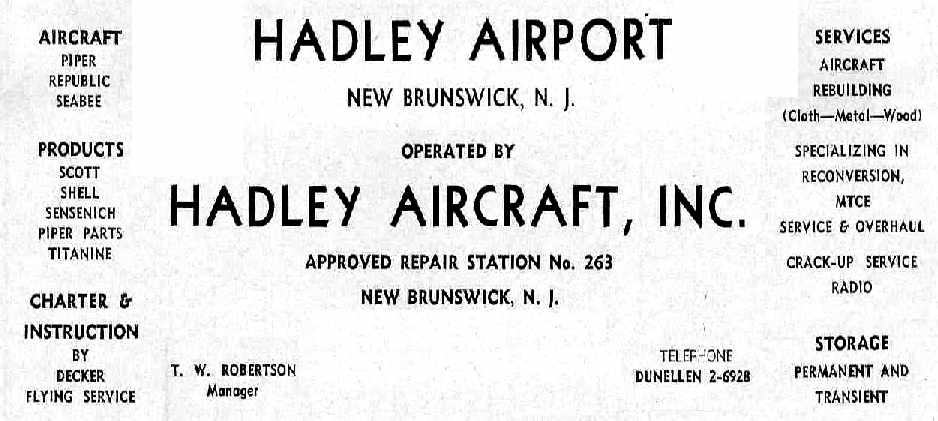
An advertisement for Hadley Field from the Haire Publishing Company's 1945 Airport Directory (courtesy of Chris Kennedy).
According to the History of South Plainfield,
"Bendix Aviation experimental planes & helicopters were tested at Hadley Airport."
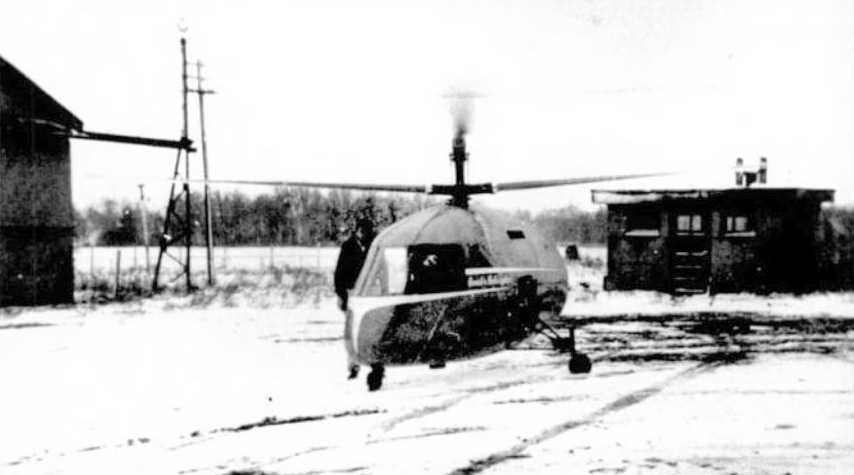
An undated view of a rare Bendix K prototype helicopter,
(manufactured between 1945-49), seen undergoing flight testing at a snowy Hadley Field.
The Bendix K had an unusual coaxial counterrotating rotor configuration, but never achieved certification.
Khadi Madama recalled, “My mother, Grace Madama, was a student pilot in 1946 at Hadley Airport, which historically was also a flight training center.
She loved when the plane flew upside down & other exciting maneuvers.
Grace took her lessons at Hadley Airport, because of the connection she & my father had with the Civil Air Patrol
and was also instrumental in the 'Canteen' that was located on site to feed all of the civilian volunteers.
Unfortunately, Grace was not able to complete her training because she became pregnant with me & believe me, I never heard the end of it!”
A 1947 aerial view showed that Hadley Field had gained 2 asphalt runways at some point between 1940-47.
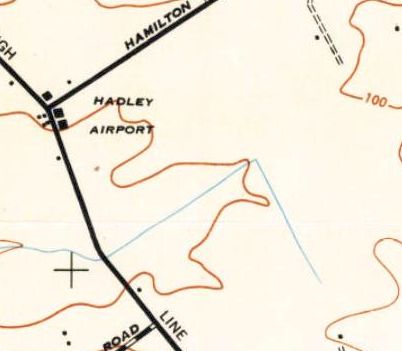
The 1947 USGS topo map depicted Hadley Airport as an open field with several small buildings on the west side.
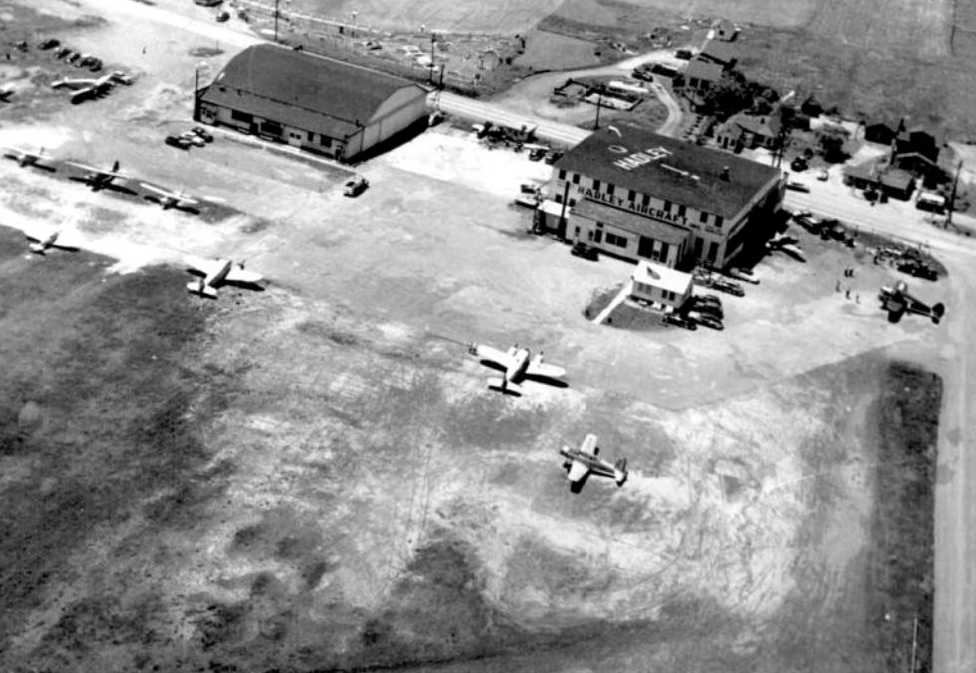
A circa 1950-58 aerial view looking southwest at Hadley Field's hangars, located along Stelton Road.
A total of 10 aircraft were visible, including 2 Cessna Bobcat twins & a surplus Vultee Valiant in the foreground.
A 1953 aerial view depicted 4 aircraft parked around the hangars.
Ed Wolf recalled, “Hadley Airport... that's where I learned how to fly in 1955.
After getting my license, I owned 3 different airplanes which I kept there.
A PT-19 which I kept hangared, an Aeronca 7AC & a Cessna 140 which were tied down on the field.
The field was operated by 'Robbie' Robertson, who I understand was a legend in his own right.”
Michael Robertson reported, “I am the grandson of Thomas Robertson who operated Hadley Airfield.
My father, Michael C. Robertson (youngest son of my grandfather) along with my uncles always share fond memories of growing up around Hadley & flying planes.”
Khadi Madama recalled, “I loved driving out to Hadley Airport into the mid-1950's with my father, Anthony Madama, which we did every weekend.
The sight of all of the planes & stepping into the hangars is still with me today. It was exhilarating.”
A 1956 aerial view depicted a significant increase in the number of aircraft visible at Hadley Field – 14.
A 1957 aerial view depicted 15 aircraft visible at Hadley Field.
Mel Haynes Sr. recalled, "I grew up in Edison
and took flying lessons at Hadley as did my father.
I soloed there, got my private there & was a line boy & shop monkey there for a few years."
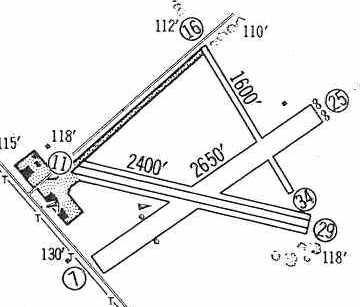
The 1960 Jeppesen Airway Manual (courtesy of Chris Kennedy)
depicted Hadley Field as having 3 unpaved runways (with the longest being the 2,650' Runway 7/25),
as well as a ramp on the west side of the field with several buildings.
Chuck Heller recalled, “I used to go to Hadley with my dad to watch the planes in the very early 1960s.”
A 1963 aerial view of Hadley Field showed 23 aircraft on the field.
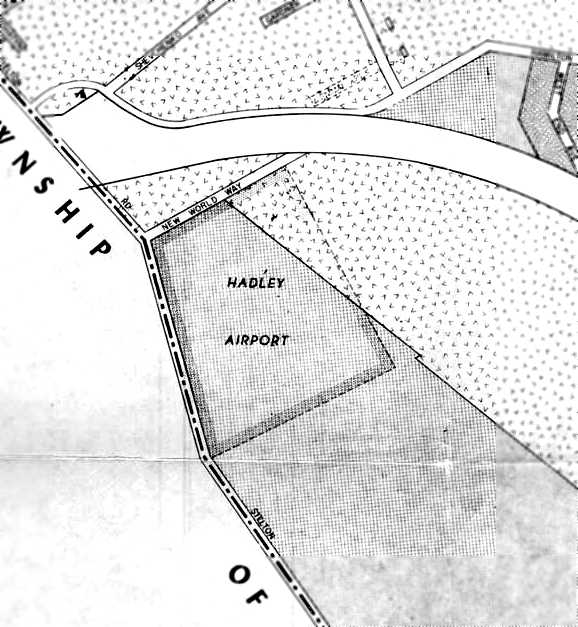
A 1966 Zoning Map of South Plainfield depicted Hadley Airport as having a rectangular outline.
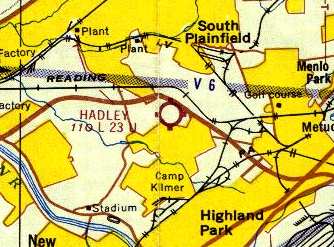
The last aeronautical chart depiction which has been located of Hadley Field was on the 1967 NY Local Aeronautical Chart (courtesy of Mike Keefe).
It described Hadley as having 3 turf runways, with the longest being 2,345'.
Mel Haynes Sr. recalled, "When they reenacted the airmail flight around 1967 or 1968
I propped the Jenny & made the papers but don't have a copy of the picture.
I really enjoyed working there & knew many of the locals & legends,
Tom Robertson in particular."
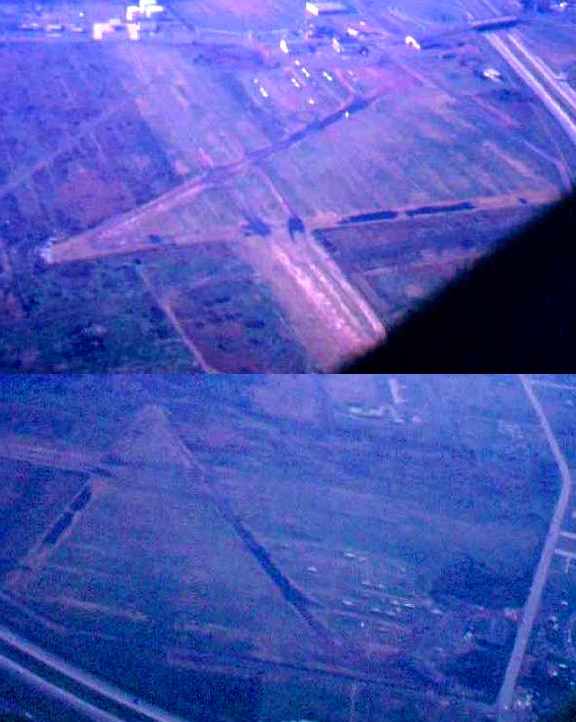
Two 1968 aerial views of Hadley Field by Mac Mayercik.
Mac recalled, “I learned to fly there & had a Champ in 1967-68, before moving it to Somerset Hills, also [now] gone.”
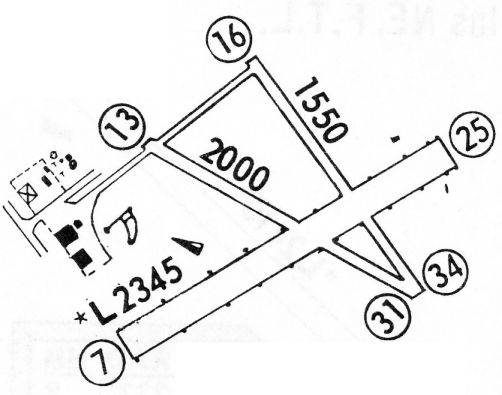
The last airport directory listing which has been located of Hadley Field was in the 1968 Flight Guide (courtesy of Robert Levittan).
It depicted Hadley as having 3 unpaved runways, with the longest being the 2,345' Runway 7/25,
and with a ramp with 3 buildings on the west side.
According to Peter Maefield's 1972 Wings Club of NYC speech (courtesy of Dave Kanzeg),
“Hadley was finally closed on 11/1/68”, after 44 years in operation.
According to Tom Beamer, "After it closed there was a big auction (unfortunately I didn't attend).
Among the items auctioned were parts from mailplanes of the 1920s."
In a 1996 report by the New Jersey General Aviation Study Commission's Subcommittee on Airport Closings,
reasons were given for the closing of 13 New Jersey general aviation airports.
According to the report, "Hadley Airport would have needed a costly upgrade in order to survive.
The community was opposed to preservation of the airport
and the land was sold to a developer, who erected a shopping center, industrial park, and hotel."
A 1969 aerial view showed that a new road had been cut through the center of Hadley Field.
The 2 runways were still recognizable, but both hangars had been removed.
A 1970 aerial view showed that portions of the 2 runways were still recognizable.
Hadley Field was no longer depicted at all on the 1972 NY Terminal Control Area Aeronautical Chart,
and a 1972 aerial view showed that it had been covered with new construction,
with not a trace remaining of the airport.
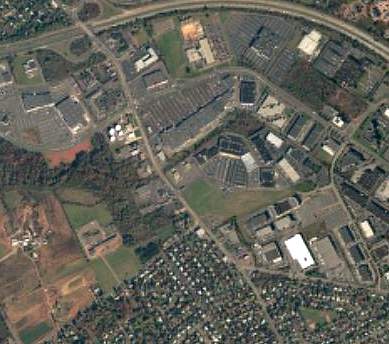
A circa 2000 aerial photo showed the site of Hadley Field had been redeveloped with an office campus & hotel,
and not a trace appeared to remain of the airport.
According to Douglas Wright, "The name lives on, at least,
immortalized in the name of the shopping mall that covers part of the site."
Peter Angelou reported in 2005, “Both of the hangars that were located at Hadley
were sold & moved to Blairstown Airport where they were both erected... only one was completed...
the other having only the framework erected.
It still is sitting there today... 'bare boned'.”
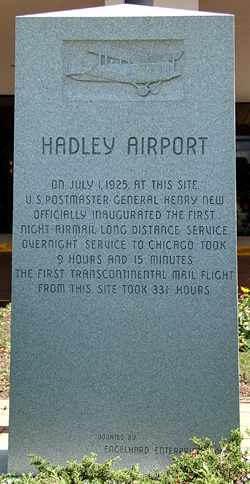
A 2007 photo by Jack McKillop of an engraved stone memorial which sits at the site of Hadley Airport.
Jack reported in 2007, “Part of the old airport is now a Holiday Inn.”
The site of Hadley Field is located at the intersection of Route 529 & Hadley Road (appropriately enough).
See also: http://www.airmailpioneers.org/history/HadleyField.htm
…………………………………………………………..
In 1955 Hadley Field gained an unusual neighbor - an Army Nike surface-to-air missile battery.
South Plainfield Battery NY-65 was a 2-magazine Nike missile battery,
first manned by Regular Army units & later by the NJ Army National Guard.
The Integrated Fire Control Site for the Nike battery was located east of Durham Avenue
The Launch Site was located at the intersection of Hadley Road & Durham Avenue,
close to the southern edge of Hadley Field.
The South Plainfield battery was originally equipped with 20 first-generation Nike Ajax missiles.
The earliest photo which has been located of the South Plainfield Nike battery was a 1956 aerial view.
NY-65 was chosen as one of a subset of Nike batteries to be upgraded
to the significantly more capable 2nd-generation Nike Hercules missile,
the first of which arrived at the NY-65 Battery in 1961.
Battery NY-65 was eventually equipped with 12 Nike Hercules missiles.
The last photo which has been located showing the battery was a 1970 aerial view.
The South Plainfield Nike battery remained operational until 1971.
A 1972 aerial view showed the above-ground portion of the missile launchers had been removed,
but the site otherwise remained intact.
A 1979 aerial view showed the launch site was still relatively intact, but used for parking.
All remains of the Nike missile site were subsequently obliterated (just like the historic Hadley Field).
A 1987 aerial view showed that a shopping plaza had covered the launch site at some point between 1979-87.
____________________________________________________
North Brunswick Airport, North Brunswick, NJ
40.468, -74.486 (Southwest of New York, NY)
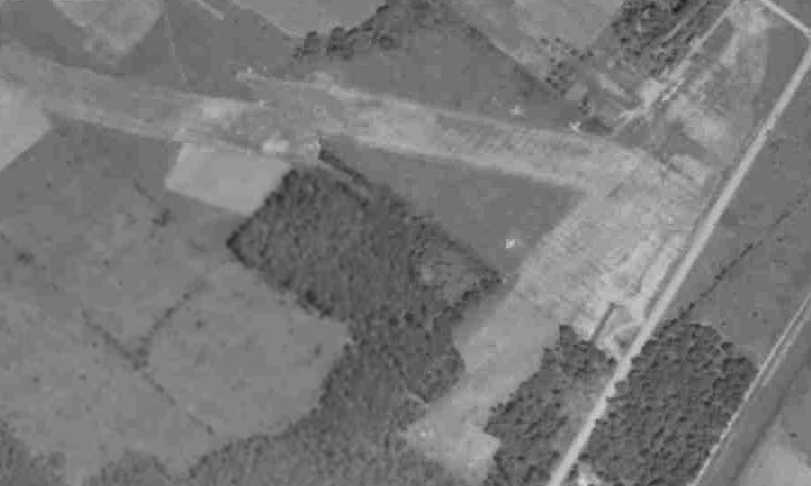
A 1947 aerial view depicted North Brunswick as having 2 grass runways, oriented northwest/southeast & northeast/southwest.
The North Brunswick Airport was evidently established at some point between 1945-47,
as no airfield was depicted at this location on a 1940 aerial photo nor on the 1945 NY Sectional Chart.
According to Joseph Novelli, “The property located at 1202 Airport Road... I obtained deeds for the property
and learned that Aeromotive Corporation purchased the lot (which was probably part of a larger lot) in 1945.”
The earliest photo of North Brunswick Airport which has been located was a 1947 aerial view.
It depicted North Brunswick as having 2 grass runways, oriented northwest/southeast & northeast/southwest.
A total of 6 light aircraft were visible on the east side of the field, along with a long hangar building.
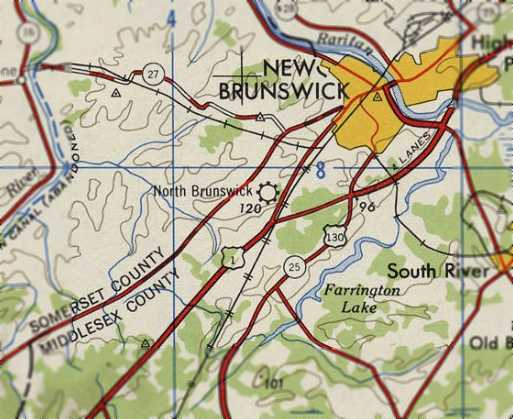
North Brunswick Airport, as depicted on the 1947 USGS topo map.
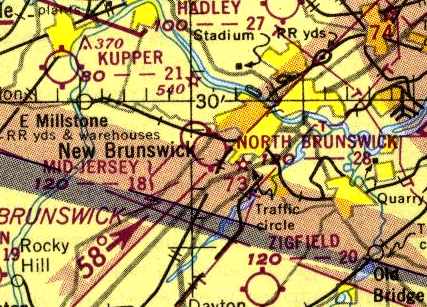
The earliest aeronautical chart depiction of North Brunswick Airport which has been located
was on the 1950 NY Sectional Chart (courtesy of Mike Keefe).
It depicted North Brunswick as having a 2,800' unpaved runway.
Gus Kuhlman recalled, “North Brunswick had an airport for quite a while.
Off Jersey Avenue there's a road called Airport Road. It's industrial, where the industries are.
That was an airport. It ran from Jersey Avenue up to Route 27.
That was their landing strip there. That's the field. You can't tell too much.
A friend of mine had an airplane there that we used to fly. That was an active private airport.
One time when I was the police commissioner, we got a call about an airplane wreck in the woods south of that.
We went down there, and it was the son of the fellow who owned the airport.
He had gotten his solo license, and he was out practicing.
I don't know now what happened really, whether the motor stalled or anything.
But it went into the ground, and he was killed.
But that was a very active airport at the time.”
A 1953 aerial photo depicted 11 light aircraft on the east side of the field.
A 3rd much longer northwest/southeast runway had been added at some point between 1947-53,
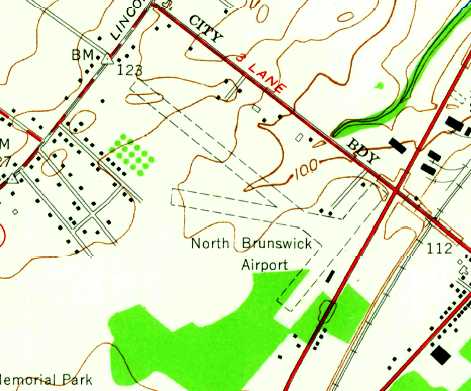
The 1954 USGS topo map depicted North Brunswick as having 3 unpaved runways & a few small buildings.
Arthur Stoller recalled, “In the summer of 1955 I began flying &and training for my private license
at the North Brunswick airport using the GI Bill.
My instructor was Art Rooney, a fine instructor & a great guy.
The airport was owned by a gentleman named Walt Gingrich.
He had a daughter Barbara (who I used to tutor in her high school physics), and a son named Bruce.
They had 3 yellow Aeronca Champs 7A2 that were used for training, and for giving people local rides.
According to my log book, the numbers of these Aeronca's were: 83219, 3418E, and 1840E.
Ground school was held in their small office building.
It cost $6 / hour (including fuel) to rent a plane solo.
Since the GI bill covered 2/3 of the cost, it cost me $2 per hour to fly.”
Arthur continued,. “Walt's son Bruce was 15 years old & was bought up around the airport, and was taking flying lessons for years.
There were 3 instances where he was written up in the New Brunswick newspaper, The Daily Home News.
The first time, was when he had his first solo on his 16th birthday.
He soloed a twin-engine plane, and was written up as the youngest multi-engine pilot in the country.
The second time was when another plane was attempting to land,
but one landing gear deployed, but the other would not come down.
Bruce stood on the back of a pick-up truck which was driven along the runway,
and he held up the wing until the aircraft had lost most of its speed.”
A 1956 aerial view showed that North Brunswick Airport had gained a 2nd row of T-hangars,
and a total of 8 light aircraft were visible on the field.
A 1957 aerial view depicted the field in a similar manner.
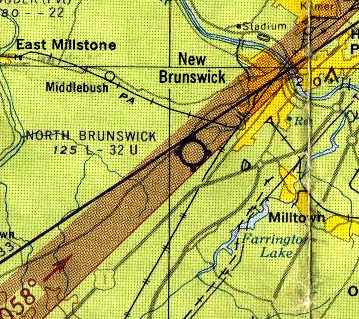
The 1962 NY Local Aeronautical Chart (courtesy of Mike Keefe)
depicted North Brunswick as having a 3,200' unpaved runway.
The 1962 AOPA Airport Directory described North Brunswick as having 3 sod runways,
with the longest being the 3,400' Runway 14/32.
The field was described as offering major repairs, hangars, tiedowns, charter, and fuel,
and the operator was listed as Aeromotive Corporation.
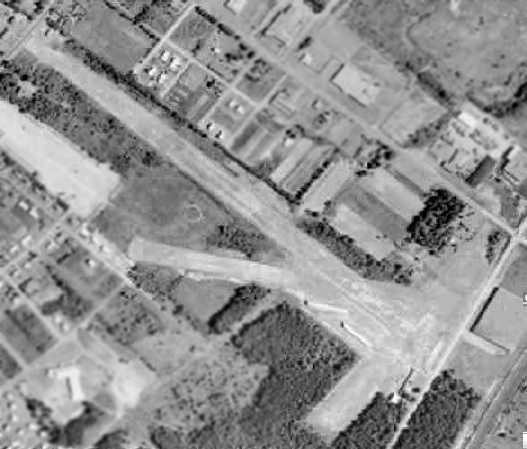
The last photo which has been located of the North Brunswick Airport was a 1963 aerial view.
It showed that North Brunswick had gained a 3rd set of T-hangars,
west of the runway intersection, at some point between 1957-63.
Only 4 light aircraft were visible parked outdoors at the field.
Arthur Stoller recalled, “After the airport had been there for many years,
someone built a housing development just beyond the far end of the runway.
Pretty soon calls were coming in to complain about the noise when planes took off.
I could never understand why anyone would buy a house at the end of a runway,
and then be surprised to hear aircraft noise.
At any rate, we were asked to dog-leg off to the right as soon as we had enough altitude.”
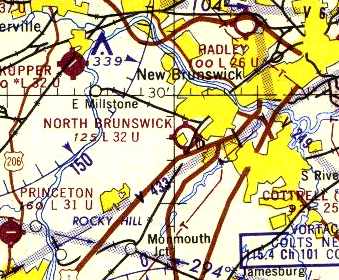
The last depiction which has been located of North Brunswick Airport was on the 1965 NY Sectional Chart.
It depicted the field as having a 3,200' unpaved runway.
In a 1996 report by the New Jersey General Aviation Study Commission's Subcommittee on Airport Closings,
reasons were given for the closing of 13 New Jersey general aviation airports.
According to the report, "In the case of North Brunswick Airport,
the end of G.I. Bill training caused the downturn of development off the end of the runway
and contributed to the decision to sell.
North Brunswick Airport was another case where encroachment contributed to an airport's closing.”
According to Joseph Novelli, deeds for the property located at 1202 Airport Road showed that Aeromotive Corporation sold the lot in 1965.
North Brunswick Airport was evidently closed at some point between 1965-68,
as it was no longer listed among active airports in the 1968 Flight Guide (courtesy of Robert Levittan)
nor depicted at all on the 1969 USGS topo map.
A 1969 aerial photo showed that 2 large industrial buildings had been built over the eastern portion of the site,
and housing developments covered the western portion.
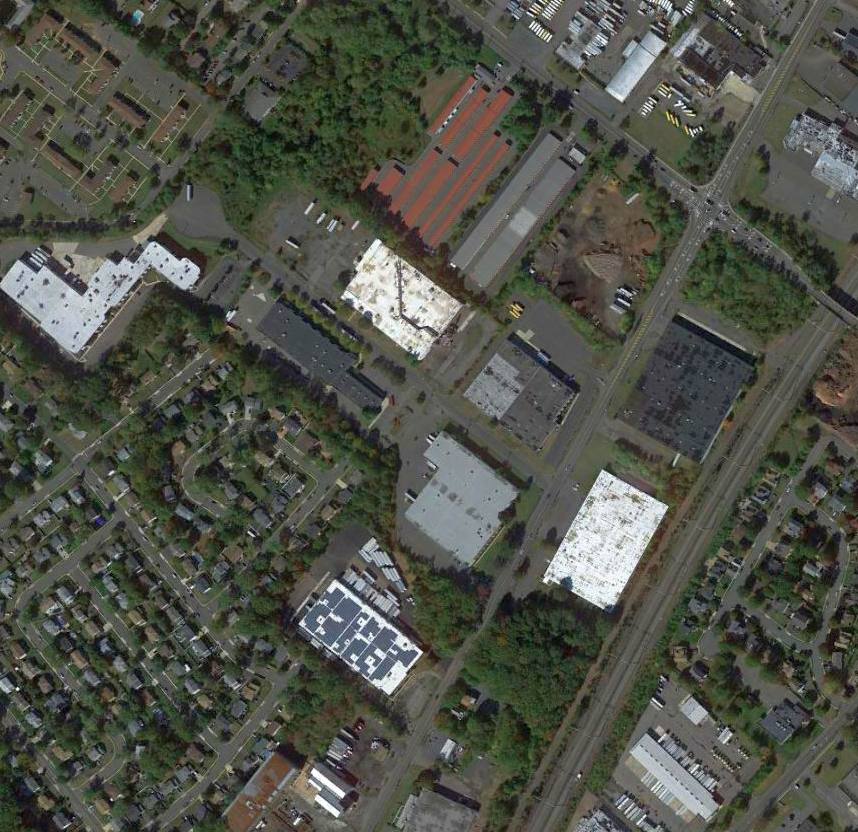
A 2014 aerial view showed no trace remaining of North Brunswick Airport.
The site of North Brunswick Airport is located at 1200 Airport Road, appropriately enough.
Thanks to Neal Dillman for pointing out this airfield.
____________________________________________________
40.61, -74.319 (West of New York, NY)
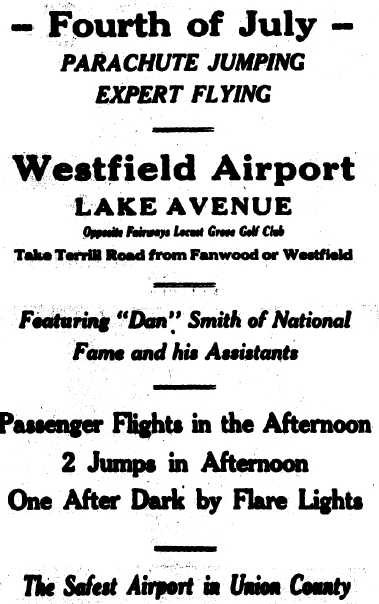
A Jul 1928 advertisement for a parachute jumping exhibition at Westfield Airport (courtesy of Mark Hess).
According to a talk given by former Mayor Garland Boothe at a meeting of the Westfield Historical Society,
E.R. Crow, the owner of the former Westfield Ford agency on North Avenue,
helped select the site for the airport during the summer of 1928.
He served as the Westfield Airport Corporation’s 1st president while Alan Bruce Conlin served as the airport’s lawyer.
Westfield debuted its airport on October 21, 1928
(although some newspaper clippings indicate the airport opened on March 31, 1929).
The airport was located on what was previously farmland.
An 11/23/55 article (courtesy of Mark Hess) observed,
“The field started out in 1928 with predictions of big success.”
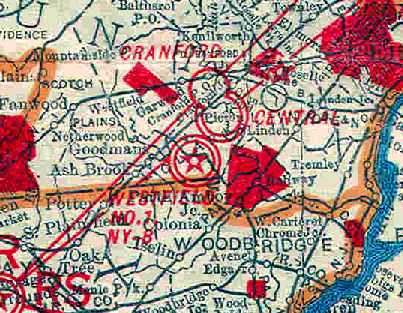
The earliest depiction of the Westfield Airport which has been located
was on the 1930 Rand-McNally Air Trails Map (courtesy of Chris Kennedy).
It depicted as Intermediate Field #1 along the NY-B Airway (New York to Baltimore?).
The field's operator was listed as the Atlantic Air Service,
and it was described as having 3 runways,
with the longest being the 2,500' northeast/southwest strip.
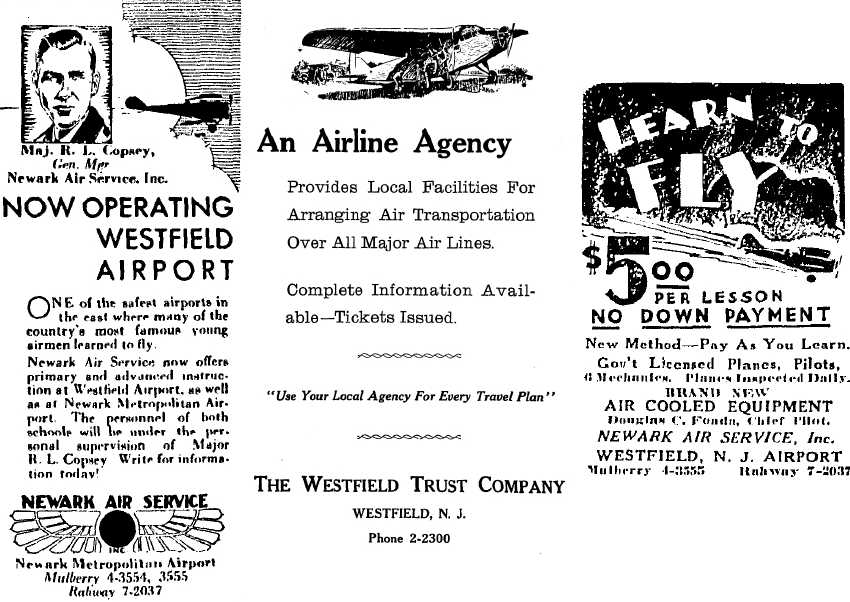
Three 1931 advertisements for Newark Air Service & The Westfield Trust Company, operating from Westfield Airport (courtesy of Mark Hess).
A third anniversary dinner was held for the airport in 1931 at the Echo Lake Country Club,
attended by State Senator Arthur Pierson.
Garland Boothe explained that the airport was fairly large,
with 3 runways, the longest of which was 2,700' (and eventually located parallel to the Garden State Parkway).
The facility also had 2 hangars located across the Clark Township & Union County line in Woodbridge.
"The airport was typical of the day, grass strips, biplanes & loud authoritative piston engines", according to Garland Boothe.
There was no air traffic control at the airport.
The main runway was located behind Madison Hill Road in Clark.
Garland Boothe explained that the 1st pilot to land a plane at the airport was the late Cap Smith, a Westfield realtor.
Smith landed periodically at the Westfield Airport.

The earliest aeronautical chart depiction which has been located of Westfield Airport
was on the November 1931 NYC-Albany Air Navigation Map.
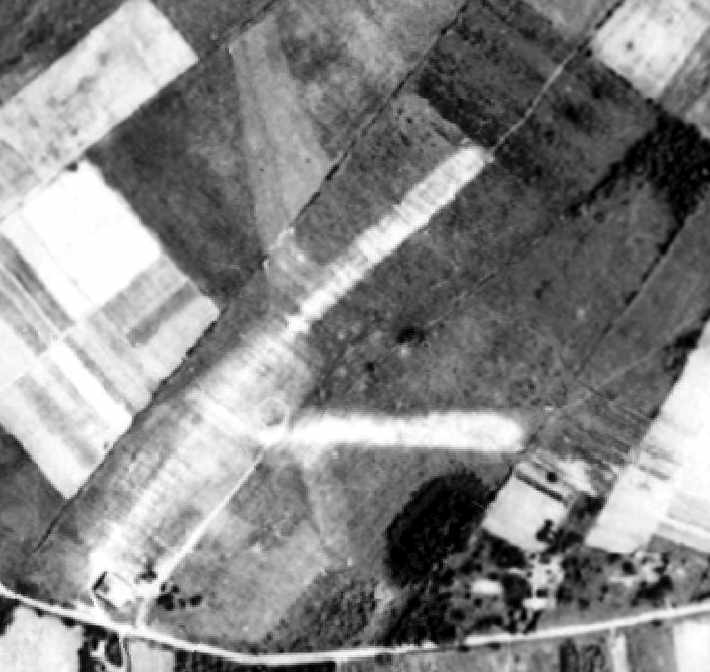
A 1931 aerial view depicted Westfield Airport as having 3 unpaved runways,
with a hangar on the southwest corner of the field.
A circular airport marking was visible near the runway intersection.
According to Garland Boothe, Cap Smith landed at the Westfield Airport in May of 1938
to pick up some letters as part of a celebration to mark the 20th anniversary of air mail.
Bob Buck, formerly of Trinity Place & who used to fly a glider at the airport with a friend,
set an altitude record out of Westfield Airport of over 15,000' while using oxygen.
This flight almost became a tragic one, however, when the pilot could not find his way down through storm clouds.
Buck finally found a hole in the clouds over Summit & returned home with a realization that flying that day,
which had been against the advice of others at the airport, had not been such a good idea.
Westfield Airport hosted parachute jumps (one of which resulted in a fatality),
air races & aerobatics as well as rides.
A big air meet was held in June of 1931, co-sponsored by the Westfield real estate board,
which included warbirds & planes from World War I.
The Airport Directory Company's 1933 Airport Directory (courtesy of Chris Kennedy)
described Westfield as having 3 runways, with the longest being 1,800'.
A hangar was said to have "Westfield" painted on the roof.
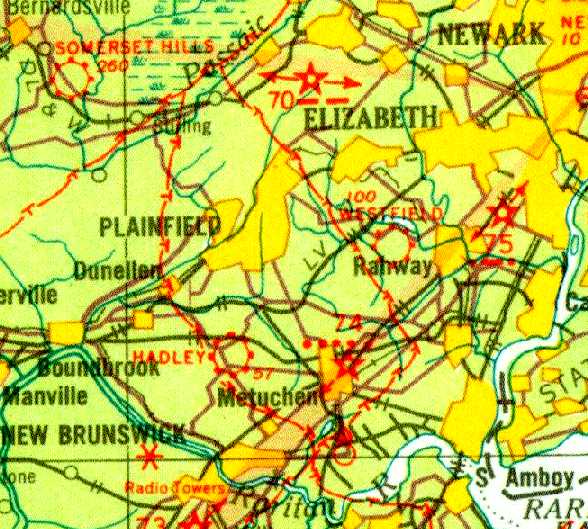
The 1934 Sectional Aeronautical Chart depicted Westfield Airport as a commercial/municipal field.
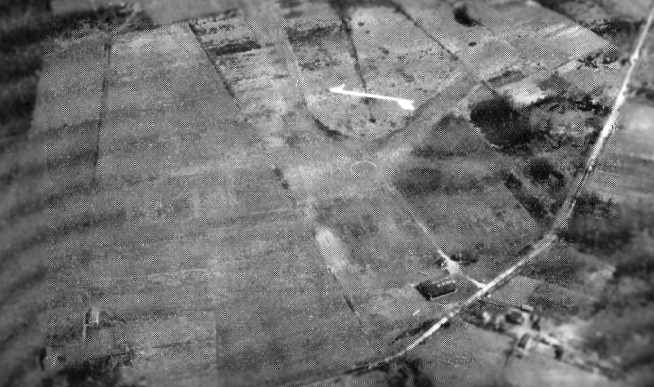
An aerial view looking east at Westfield Airport
from the Airport Directory Company's 1937 Airport Directory (courtesy of Bob Rambo).
The directory described Westfield as having 3 sod runways,
with the longest being the 2,600' northeast/southwest strip.
A single hangar on the southwest side of the field was said to have "Westfield" painted on the roof.
A 1940 aerial view depicted the hangar at the southern end of the field,
but there were no aircraft visible outside.
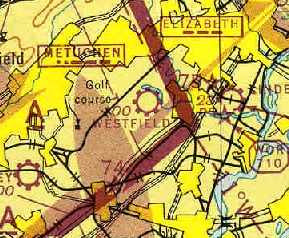
The 1945 NY Sectional Chart depicted Westfield as a commercial airport.
A 1947 aerial view depicted a total of 23 light aircraft parked at Westfield Airport.
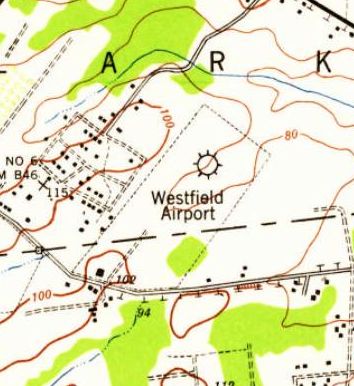
The 1947 USGS topo map depicted Westfield Airport as a rectangular clearing with a single building on the southwest side.
Carl Frank recalled, “The hangar & operations 'shack' were in Colonia (Woodbridge).
I only recall 2 runways. The runways were in Clark.
The east/west runway was clipped to permit the Parkway roadway to cleave its was through New Jersey. That was in 1947-48.
The dividing line between Middlesex County & Union County was at the south edge of the east/west runway.
This runway was then to be called the 'Short Runway'.
The airport was forever noted as the Westfield Airport. Truly it should be called Westfield's Airport.”
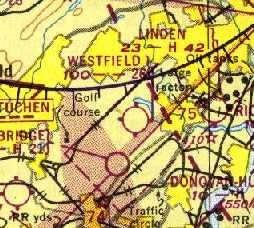
The 1950 NY Sectional Chart (courtesy of Mike Keefe) depicted Westfield as having a 2,600' unpaved runway.
George Manser recalled, “In July 1952, I was a passenger in an aircraft that crashed on the farm across from the airport.
I recovered from my injuries & took an aircraft solo up on my 16th birthday, November 13, 1953.”
An 11/23/55 article (courtesy of Mark Hess) observed:
“Operations began running into different obstacles which eventually resulted in the field's demise.
In 1952 an attempt was made by resident groups of Clark, Colonia, Westfield, Rahway and Scotch Plains to have the field closed because of alleged stunt flying by pilots.
The airport management was cleared of the charges by state aeronautical experts, but was forced to change its flight patterns thereafter.”
A 1954 aerial view depicted a busy airport, with several dozen light aircraft.
An 11/23/55 article (courtesy of Mark Hess) observed:
“Litigation suits brought the ownership of the airport to courts,
which resulted in the property being purchased by a building concern a year ago.”
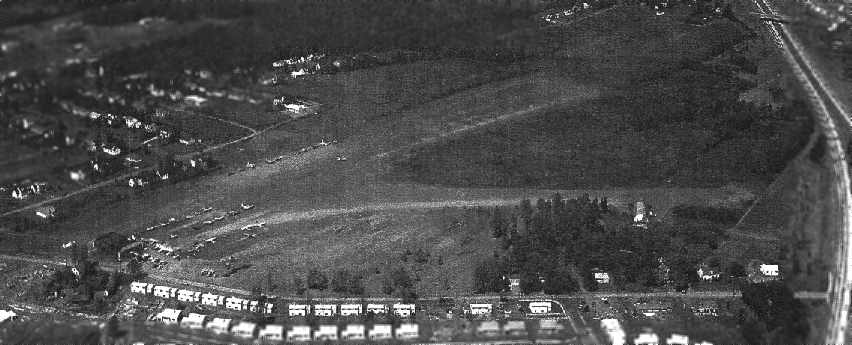
A 1955 aerial view looking north at Westfield Airport (by Carl Frank, courtesy of George Manser)
showed the field to have 2 grass runways, oriented east/west & northeast/southwest.
Note the Garden State Parkway bordering the field to the east,
and the numerous houses which had started to surround the field (and would be the ultimate cause of its demise).
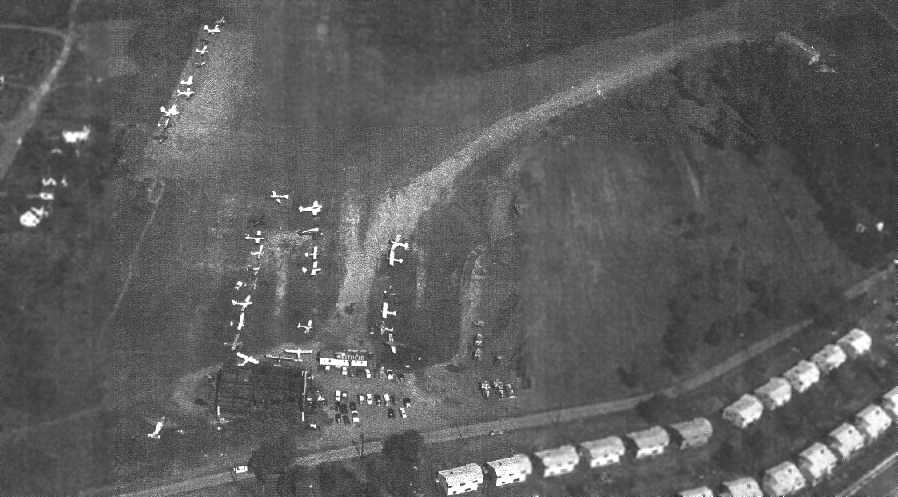
A 1955 aerial view looking northeast at Westfield Airport (by Carl Frank, courtesy of George Manser).
A single dark hangar was located at the southwest corner of the field, along with an office building which had “Westfield” painted on the roof.
Another Quonset-hut type building is visible at the right side of the photo.
A total of over 30 light aircraft were visible parked at the field.
George Manser recalled, “My last flights at Westfield Airport
were during my leave time from the Air Force in the Summer of 1955.
There were many pilots that learned to fly at this airport who went on to bigger & better things in aviation.
Many careers started at Westfield Airport, covering the entire gamut of aviation.”
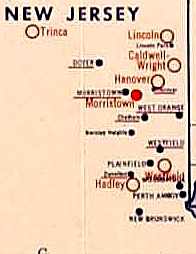
The last depiction of the Westfield Airport which has been located
was on a 1955 NY State Department of Commerce map of airports.
An 11/23/55 article entitled “Westfield Airport To Close Sunday” (courtesy of Mark Hess) observed:
“After 27 years of operation, the Westfield Airport will close its operations Sunday.
Rick Decker, airport operator, stated he has already transferred most of his activities to Somerset Hill Airport, Basking Ridge.
The builder, Sommer Brothers Construction Co., plans to construct 93 homes on the site, most of which are reported already sold.”
The 1956 USGS topo map no longer depicted the Westfield Airport,
but instead showed the newly-built Garden State Parkway cutting through the eastern portion of the former property.
A 1957 aerial view showed that houses had covered the southern portion of the former airport,
but the northern portion of the primary runway was still clear.

A 2014 aerial view looking north showed no trace appears to remain of Westfield Airport.
The site of Westfield Airport is located northwest of the intersection of the Garden State Parkway & Lake Avenue.
The site of the east/west runway is now Dorset Drive,
and the site of the northeast/southwest runway is now Jupiter Street.
Thanks to Kris Fink (whose grandfather worked at Westfield Airport) for pointing out this airfield.
____________________________________________________
40.426, -74.078 (South of New York, NY)
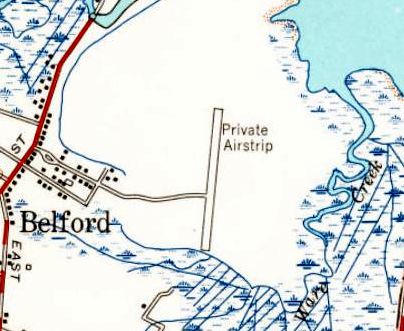
The 1954 USGS topo map depicted Belford simply as "Private Airstrip".
This airfield originally belonged to the J. Howard Smith Fish Factory in Port Monmouth across the Belford Creek
(according to Belford resident Harry Nolan, via John Gorto).
The J. Howard Smith Fish company had a plant there for processing Menhaden,
and they used aircraft to spot schools of fish for the boats.
The Belford Airfield was evidently established at some point between 1947-53,
as a 1947 aerial photo showed an empty field with no sign of aviation facilities,
and no airfield was depicted on the 1949 USGS topo map.
The earliest depiction which has been located of the Belford Airfield was a 1953 aerial view.
It depicted Belford as having a single paved north/south runway.
The 1954 USGS topo map depicted Belford as a single north/south runway, labeled simply as "Private Airstrip".
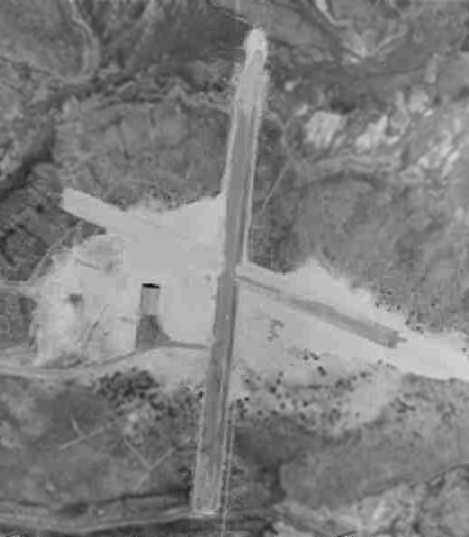
A 1957 aerial view depicted the Belford Airfield as having a single paved north/south runway,
with the crosswind runway apparently under construction.
A hangar had been added at some point between 1953-57 southwest of the runway intersection.
A 1963 aerial view showed that construction had been completed on the paved crosswind runway.
No airfield at this site could be located in either the 1962 or 1982 AOPA Airport Directories.
The airfield wasn't depicted at all on Sectional Charts from 1958, 1965, or 1975,
the 1979 NY TCA chart (courtesy of Bill Suffa), or the 1969 USGS topo map.
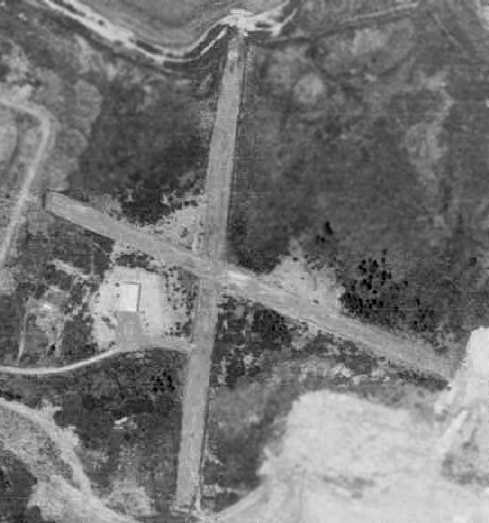
A 1970 aerial view showed the Belford runways.
According to Tom Beamer, “The building was a hangar, I remember it active/open in the 1970s."
A 1979 aerial view showed the 2 runways remaining clear, but both were painted with closed-runway “X” symbols.
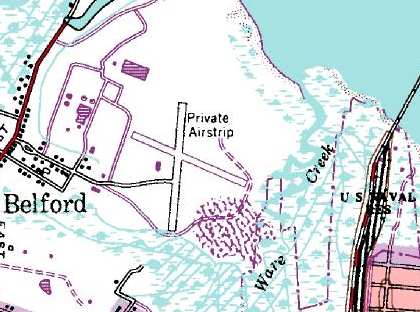
The airfield was depicted on the 1981 USGS topo map, labeled simply as"Private Airstrip".
It depicted the field as having two 1,700' runways, oriented north/south & northwest/southeast.
The airfield was still depicted on the 1986 USGS topo map.
The Belford Airfield was evidently closed at some point before 1995,
as the 1995 USGS aerial view showed piles of mulch on portions of both runways.
According to Gus Fraser, "Students at Linden use it [the Belford Airfield] to practice off-field landings (down to 500ft)."
Tom Beamer reported in 2003, "Belford is now a municipal mulching operation.”
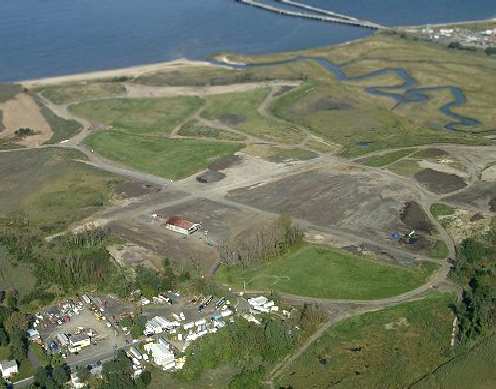
A 2003 aerial view by Rich Galiano, looking northeast at the Belford Airport.
William Angus reported in 2005, “Belford Airfield is owned by Monmouth County
and leased to the Middletown Department of Public Works for $1/year (or some such minimal figure).
Officials were gracious enough to allow me to visit the site & document the operations.
Part of the property is a landfill (now closed).
The metal hangar remains but looks like hell.
I spoke with one employee who showed me the interior
and pointed out pipes that led to bathroom facilities for a small apartment for pilots.
I commented the holes in the walls looked like bullet holes,
to which he responded 'There certainly are bullet holes! I know because I put them there as a kid!'
Apparently many of the pilots & their families were hunters.”
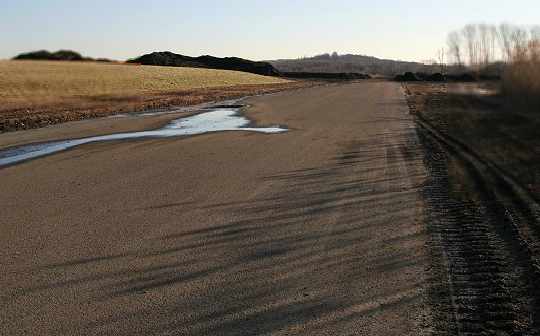
A January 2006 photo by Rich Galiano, “Looking roughly south down the main runway
at the huge piles of leaf compost that give the site a very distinctive pungent odor.
Both runways were clear, with the compost off to the sides, and the asphalt mostly intact.
There are no traces of numbers or X's.”
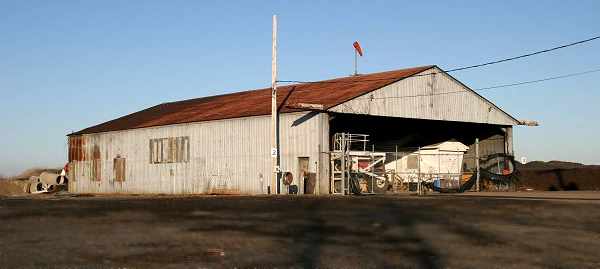
A January 2006 photo by Rich Galiano of “the hangar, full of earth-moving equipment.
I was very surprised to see a wind sock still up on the roof after all the years & hurricanes.
What are those things made of?”
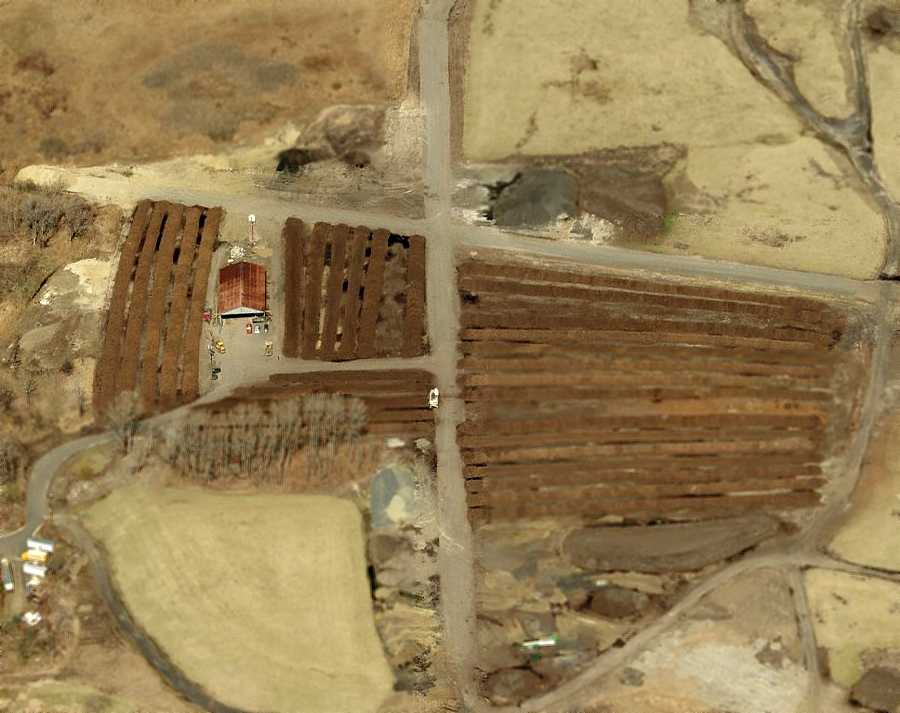
A circa 2006 aerial view looking north at the Belford Airport, showing the 2 runways & the hangar.
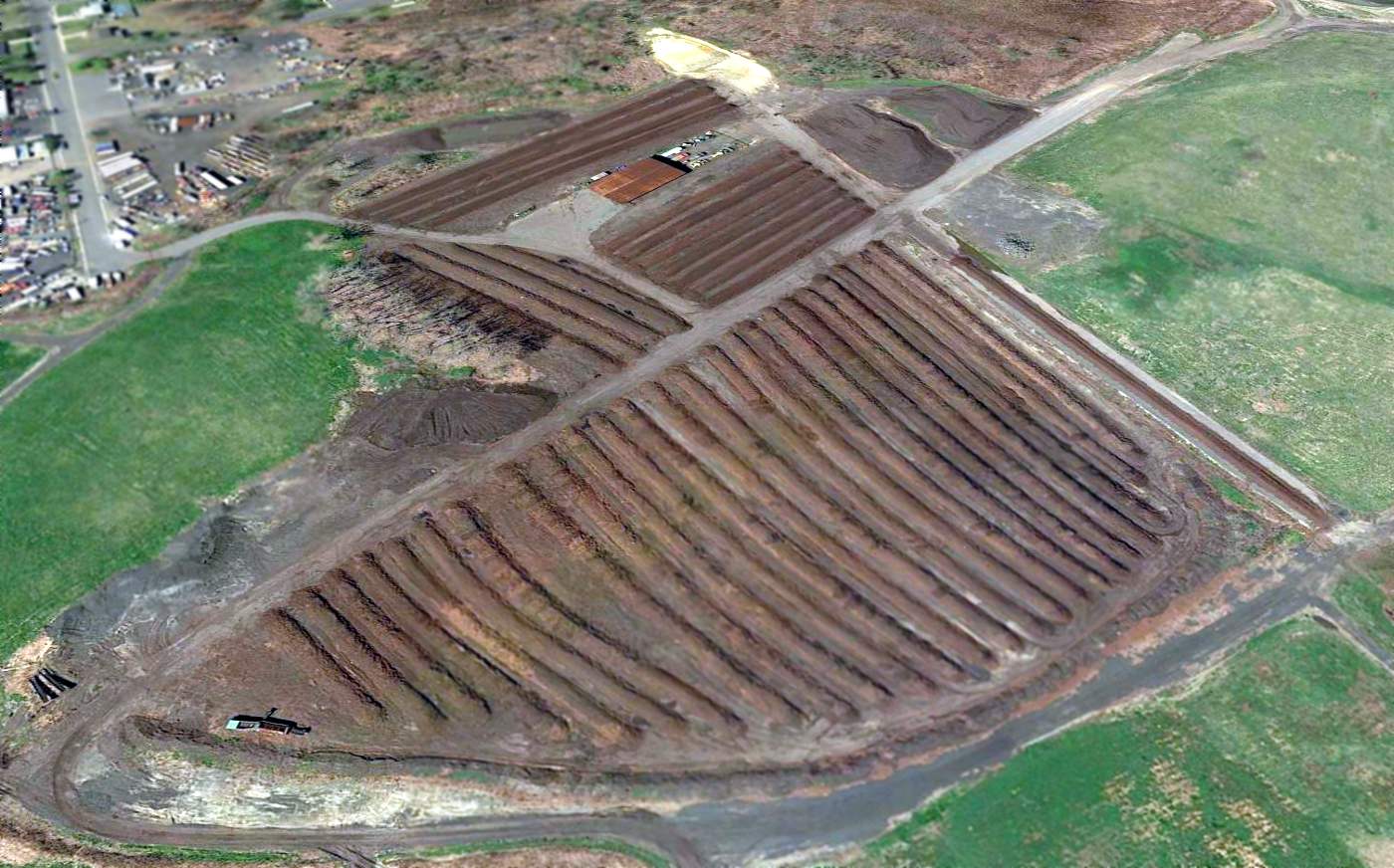
A 2016 aerial view looking northwest at the site of Belford Airfield showed that the remains of both paved runways still existed,
along with a single hangar, southwest of the runway intersection.
The Belford Airfield is located at the eastern terminus of Centre Avenue, just east of the town of Belford.
Thanks to Gus Fraser for pointing out this airfield.
____________________________________________________
Aeromarine Factory Airfield / Keyport Airport, Keyport, NJ
40.445, -74.188 (Southwest of New York, NY)
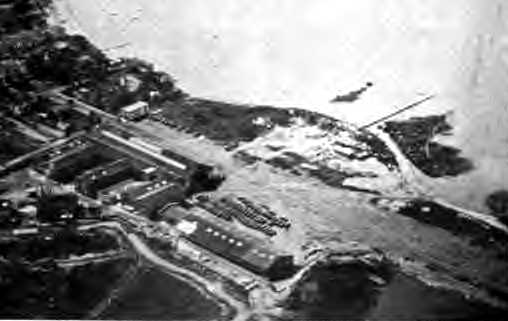
The Aeromarine Airfield, as depicted on an undated aerial view looking northwest
from the 1921 Eytinge's Flying Guide (courtesy of Alex Sheppard).
New York businessman Inglis Uppercu founded the Aeromarine Plane & Motor Company in New Jersey in 1914.
Initially the Boland Aeroplane Company, Uppercu renamed the firm Aeromarine
when Boland died in a crash & his widow sold Uppercu control.
The facilities of the Aeromarine Plane & Motor Company were constructed in 1917 on the east side of Keyport.
The site eventually consisted of several large factory buildings.
An unpaved runway ran in between the factory buildings & the coast, oriented northeast/southwest.
Very quickly the company began developing useful purposes for its Aeromarine Model 40 Flying Boat.
Focusing on mail delivery, these aviation innovators successfully delivered mail to a ship at sea in 1919.
Aeromarine manufactured landplanes, flying boats, engines, and propellers.
Aeromarine employed 900 employees at peak of the First World War.
They produced 200 39-A/39-B aircraft for the USN beginning in 1917,
converted Curtiss /Navy F-5lL & HS-2L flying boats into airliners,
built 25 Martin MB-2s as NBS-1s in 1921-22,
designed & built a number of other landplane & flying boats models in small quantities,
and in 1923 built the 1st all-metal flying boat in the US.
Aeromarine's Inglis Uppercu was also credited with invention of the inertial starter.
Aeromarine Airways Inc, began operations in 1919 between NYC & Atlantic City.
They also operated between Key West & Cuba, NYC & Havana, and Cleveland & Detroit, all in Curtiss Flying boats.
The earliest depiction which has been located of the Aeromarine Airfield
was an undated aerial view from the 1921 Eytinge's Flying Guide (courtesy of Alex Sheppard).
It depicted the field as having a single unpaved east/west runway,
with factory buildings on the southwest side.
The directory described the “Aeromarine Plane & Motor Company” field
as being 1,800' x 600', with letters on the roof, and indicated the field also had a seaplane station.
Aeromarine Airways ceased operations in 1923.
The Aeromarine-Klemm Corporation began operations in 1928,
license building the German Klemm.
The Upper-Burnelli Aircraft Corporation began operations in 1929.
Uppercu was Vincent Burnelli’s backer in his development of lifting body aircraft,
that culminated in the Burnelli CBY-3 Loadmaster built in Canada.
The 1930 "Rand McNally Standard Map of New Jersey With Air Trails" (courtesy of Chris Kennedy)
described the Aeromarine Airport as being operated by the Aeromarine Klemm Corporation.
The field was described as having a single 1,000' northeast/southwest runway.
It also depicted the adjacent seaplane base.
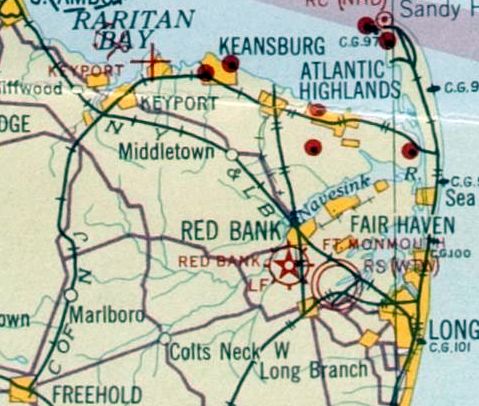
The earliest aeronautical chart depiction which has been located of Keyport Airport
was on the November 1931 NYC-Albany Air Navigation Map.
The Aeromarine-Klemm Corporation ceased operations in 1932.
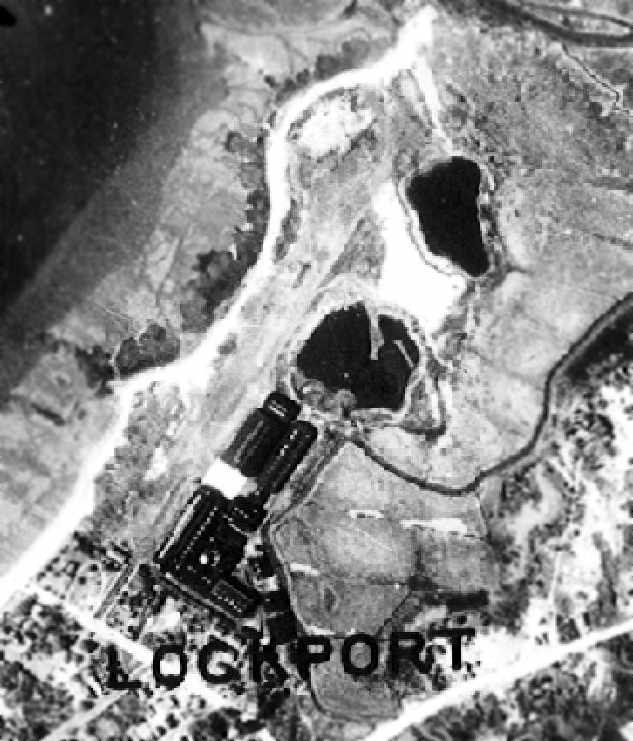
A circa early 1930s aerial view depicted the Aeromarine factory buildings,
along with the single unpaved runway along the coastline.
The Upper-Burnelli Aircraft Corporation ceased operations in 1934.
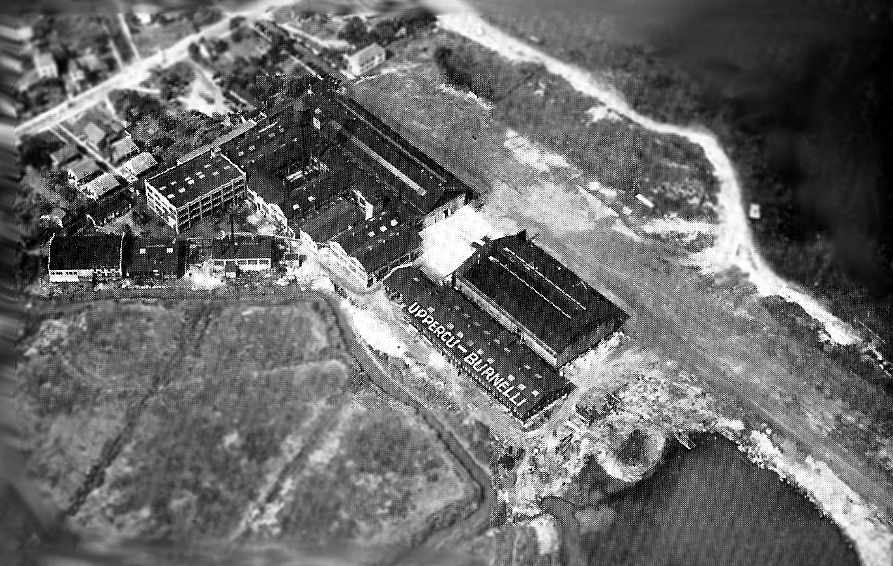
An undated aerial photo looking northwest at the Aeromarine Uppercu-Burnelli factory (courtesy of Tom Beamer).
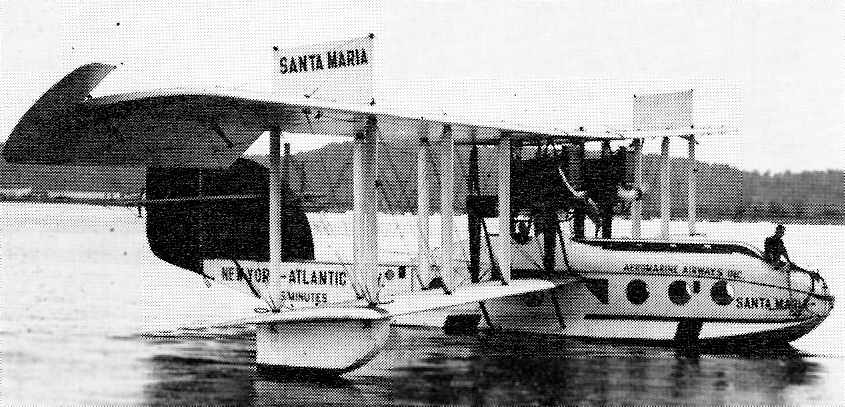
An undated view of F-5L converted by Aeromarine (courtesy of Tom Beamer).
The 1934 Department of Commerce Airport Directory (according to Chris Kennedy)
described Aeromarine Field as having 2 sod runways oriented in an "L" shape,
with the longest being an 1,800' northeast/southwest strip.
A 1935 photo of an Aeromarine ALK-26A floatplane (courtesy of Tom Beamer).
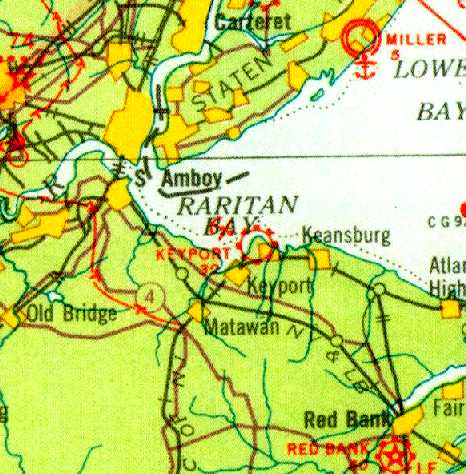
The the 1934 Sectional Chart depicted Keyport Airport as a commercial/municipal field.
The exact date of the end of operations at the Aeromarine Keyport site is unknown,
but Tom Beamer said, "I've seen 1937 listed as the end of operations."
However, the Aeromarine airfield was still listed among active airfields
in the Airport Directory Company's 1938 Airport Directory (according to Chris Kennedy).
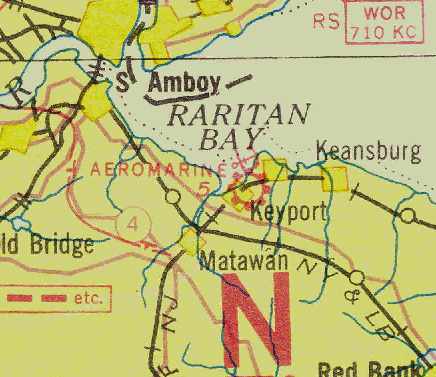
Aeromarine was still depicted as an active commercial airfield
on the August 1938 NY Sectional Chart (courtesy of Chris Kennedy).
Candee Preston recalled that her father, Rhea Preston, learned to fly from Keyport Airport, “and which his friends flew out of.”
The Aeromarine airfield was evidently closed at some point between 1938-43,
as no airfield or seaplane facility was depicted at the location of Aeromarine
on the 1943 NY Sectional Chart (according to Chris Kennedy).
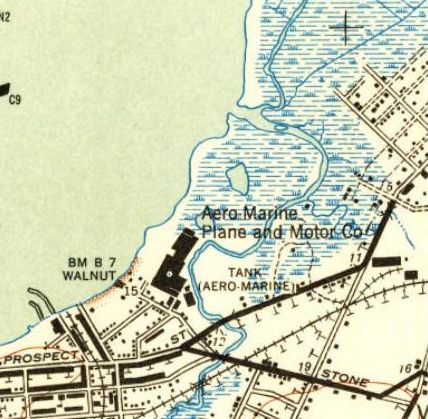
The 1947 USGS topo map depicted the “Aero Marine Plane & Motor Co”.
According to Robert Giannetti (President of Infern-O-Therm Corporation),
the former main Aeromarine factory building has been the location of the Infern-O-Therm Corporation since 1966.
Today the Aeromarine site is known as Keyport Aeromarine Industrial Park.
The Keyport Yacht Club had plans in 1997 for a modest portion of one building
to be dedicated as a museum to the Aeromarine Plane & Motor Company.
Tom Beamer reported in 2003, "The site is still intact but terribly rundown.
The buildings were in use by a variety of concerns when I visited a few years ago.
Erosion along the waterfront has reclaimed a portion of the runway."
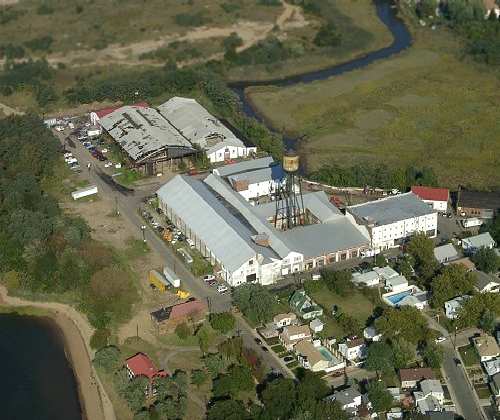
A 2003 aerial view by Rich Galiano, looking northeast at the former Aeromarine factory buildings.
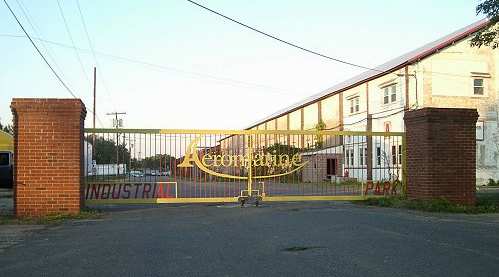
A 2003 photo by Rich Galiano of the wrought iron gate to the "Aeromarine Industrial Park".
"The wrought-iron gate looks nice, but is obviously of modern construction.
Normally it is left open; I closed it for the photo."
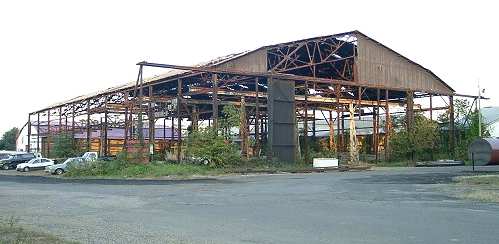
A 2003 photo by Rich Galiano. Rich observed, "The big hangar is little more than a skeleton. It is used to store construction equipment."
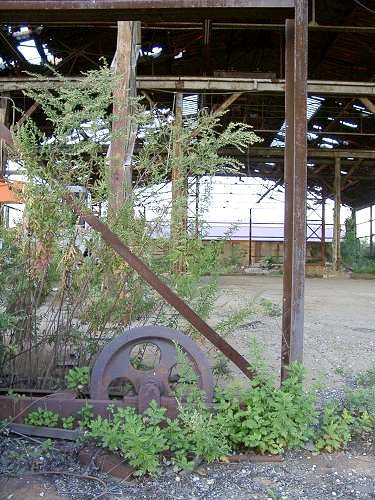
A 2003 photo by Rich Galiano, "Looking inside the hangar, past one of the door rollers."
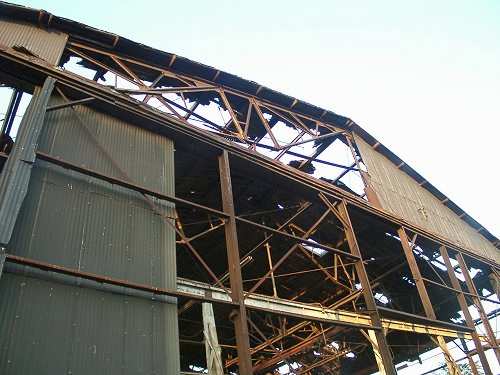
A 2003 photo by Rich Galiano, "Looking up through the rotted wooden roof."
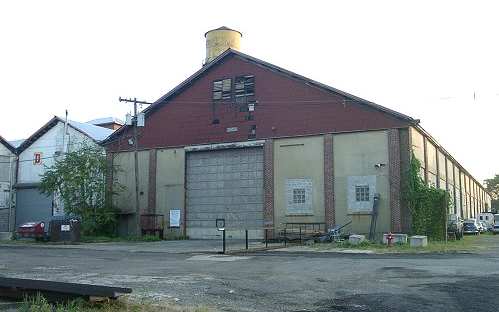
A 2003 photo by Rich Galiano. Rich observed, "The main factory building, opposite the hangar, with traces of full-width door rollers evident."
William Angus reported in 2005, “Aeromarine Airfield is in worse shape then was depicted in the 2003 photos.
According to the local business that is run there, the hangar is slated for tear-down within the next few weeks.
The entire facility is slated for demolition by year's end.
Local opposition seems to have been unable to stop the planned demolition & building of McMansions.”
However, Robert Giannetti (President of Infern-O-Therm Corporation) reported in 2007,
“Infern-O-Therm Corporation is a manufacturer of industrial heating equipment for the asphalt & concrete producing industry.
We have been in the main factory building at Aeromarine since 1966.
The Areomarine complex is not slated to be torn down
and is to remain as an industrial complex for years to come.
Most building have new roofs & windows.
The old hangar in the back of the complex is having work done to it as I write this, restoring it to as new condition.
There are over 10 business operating from the complex with approximately 100 employees.”
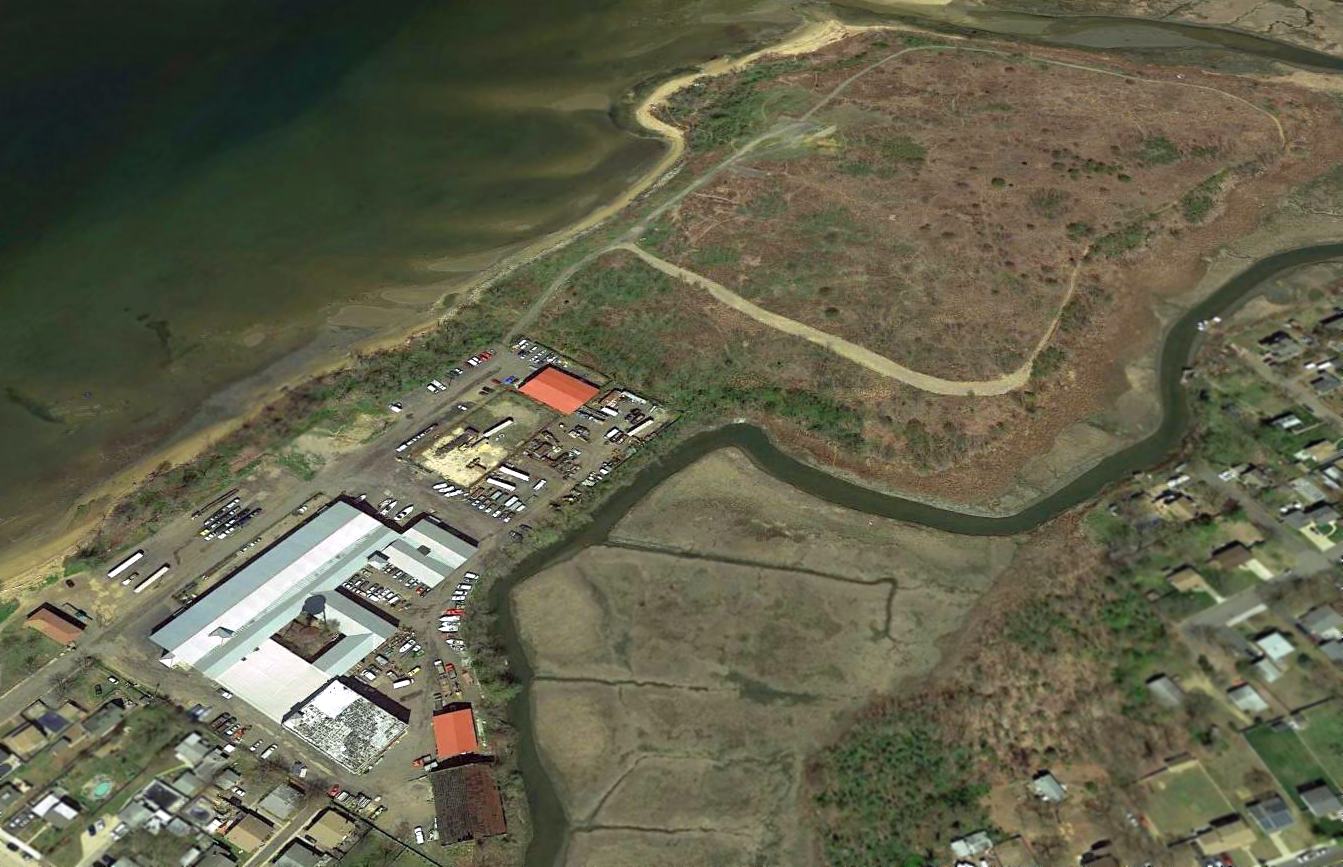
A 2016 aerial view looking north showed the former Aeromarine factory buildings still standing.
The Aeromarine Factory site is located at the end of Locust Street, northeast of Walnut Street.
____________________________________________________
Ramapo Valley Airport (1st location), Mahwah, NJ
41.102, -74.162 (Northwest of New York, NY)
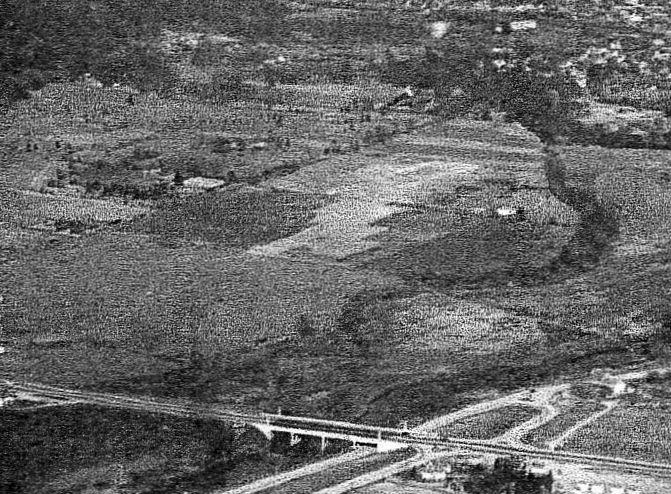
A 1946 aerial view looking north showing Ramapo Valley Airport under construction (the light colored area in the center).
According to Dick Greene, "Ramapo Valley Airport was owned & built by my late father-in-law, Fred L. Wehran."
Wehran had previously owned & developed the Teterboro Air Terminal, from 1939-48.
The earliest depiction which has been located of the Ramapo Valley Airport
was a 1946 aerial view showing the airport still under construction.
According to Adam Raines, Ramapo Valley Airport began operating in 1946.
Adam reported, “Billy Beard... [had] a short tenure operating the Ramapo Valley Airport in Mahwah.
The one in Mahwah was owned by Fred Wehran, the owner of Teterboro airport.
Fred lived near this land & felt it would be well suited as a feeder airport for Teterboro.”
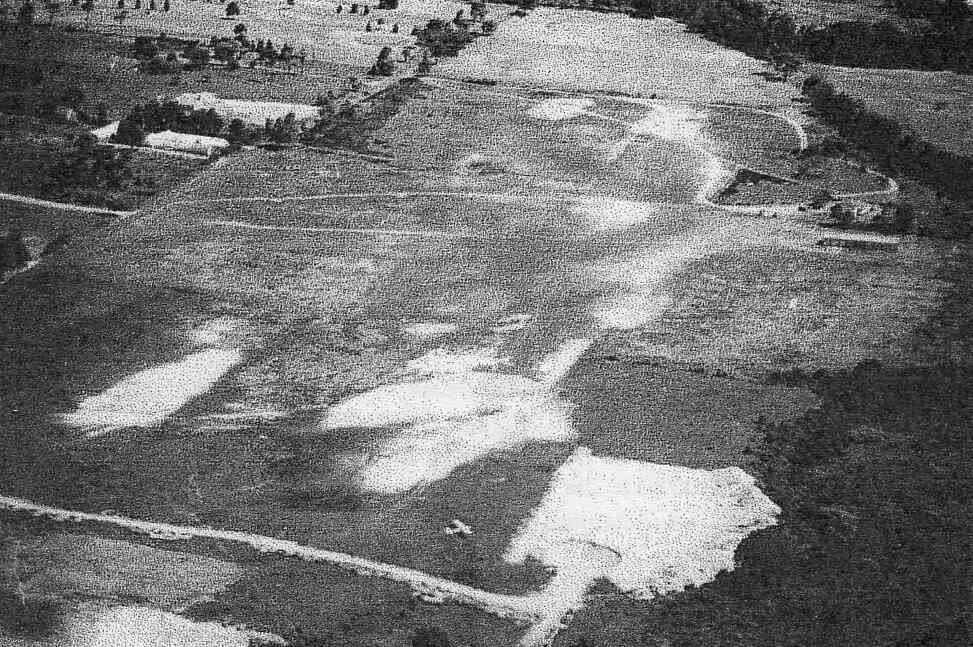
A circa 1940s aerial view looking north at Ramapo Valley Airport, with a single Piper Cub in the foreground,
next to the sand & gravel pit from which material was drawn to fill holes in the remainder of the airfield.
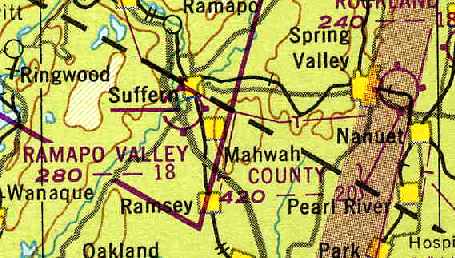
The earliest aeronautical chart depiction of the Ramapo Valley Airport in NJ which has been located
was on the 1949 NY Sectional Chart (courtesy of Chris Kennedy).
It depicted Ramapo Valley as a commercial airport with an 1,800' unpaved runway,
located adjacent to the northwest side of Mahwah, NJ.
Bill Lanning recalled of Ramapo Valley Airport, "I grew up in the area & can remember it well.
State Highway 17 is in it's approximate same position as it is now.
There was a road that made its way between what is now a propane gas business & a service station.
The grass strip was on one side of the road & the Hovenkamp Golf Course was on the other."
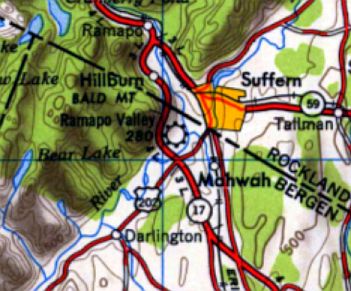
Ramapo Valley Airport, as depicted on the 1950 USGS topo map.
The earliest photo of the Ramapo Valley Airport in NJ which has been located was a 1952 aerial view.
It depicted Ramapo Valley as having a single unpaved northeast/southwest runway,
with a dozen light aircraft visible parked on the east side of the field.
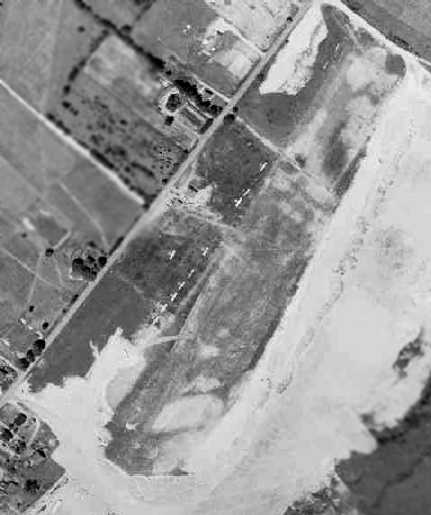
The last photo which has been located showing Ramapo Valley Airport was a 1953 aerial view.
It depicted Ramapo Valley as having a single unpaved northeast/southwest runway,
with a total of 10 light aircraft visible parked on the west side of the field.
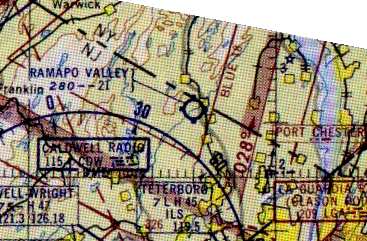
Ramapo Valley Airport was still depicted as an active airfield in its NJ location
on the 1953 Flight Chart (courtesy of Scott O'Donnell).
Ramapo Valley Airport was still depicted on the 1953 USGS topo map.
Nearby resident Bill Lanning recalled that the airport "ceased to exist when the Ford Motor Company purchased the land
and converted it into what was the largest auto-making plant under one roof."
The exact date of closure of Ramapo Valley Airport in NJ is unknown,
but it was apparently closed at some point between 1953-55,
as the 1955 USGS topo map depicted the automobile factory at the location of the former airport.
This was a huge Ford Motor Company Mahwah assembly plant,
which at the time of it's completion was the largest motor vehicle assembly plant in the United States.
It produced the Edsel, Ford Galaxie, Ford LTD, Ford Granada, Ford Fairmont, Mercury Monarch, Mercury Zephyr, and Lincoln Versailles.
At some point between 1955-57, another airport named Ramapo Valley Airport
was established just a few miles to the east in Spring Valley, NY.
However, the Ramapo Valley Airport in NY had no relation to the Ramapo Valley Airport in NJ - other than using the same name.
A 1965 aerial view showed the factory covering the site,
with no trace remaining of the airport.
The Ford factory built on the site of the airport was closed in 1980.
Bill Lanning recalled that after the Ford factory was closed,
“The property was vacant for a year or two & a 27-story office / Sheraton hotel was built in its place."
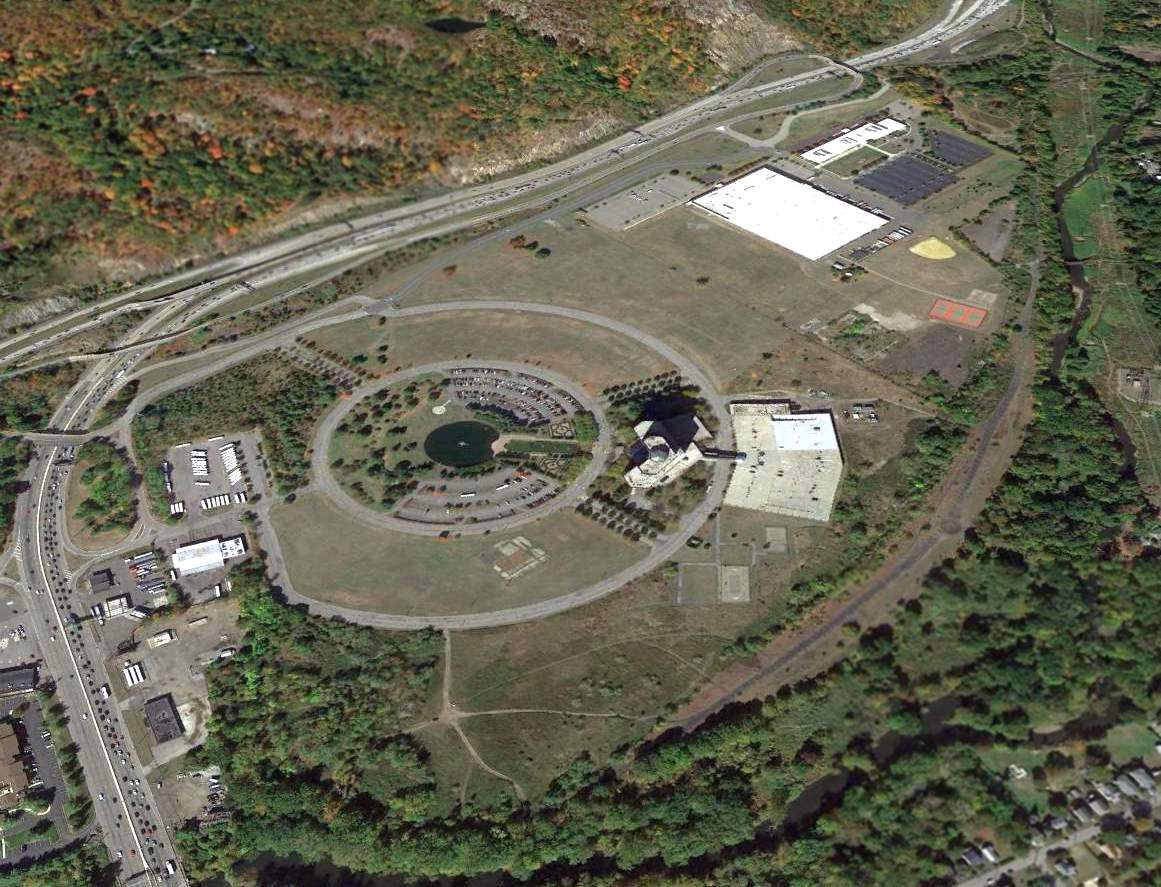
A 2014 aerial view looking northwest showed the Sheraton hotel complex covering the site of Ramapo Valley Airport.
The site of Ramapo Valley Airport is located east of the intersection of Route 287 & Route 17.
____________________________________________________
Towaco Airport / Montville Airpark, Towaco, NJ
40.932, -74.338 (Northeast of Morristown Municipal Airport, NJ)
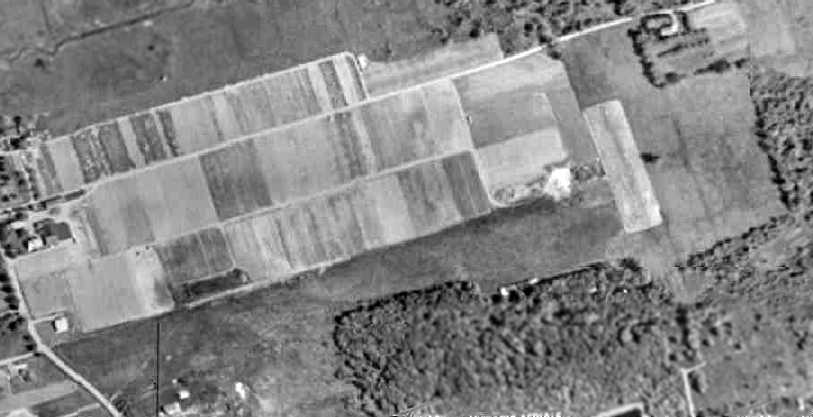
A 1957 aerial view depicted the Towaco Airport as having a single grass northeast/southwest runway.
This general aviation airport was evidently established at some point between 1947-56,
as it was not yet listed among active airfields in the 1945 AAF Airfield Directory (courtesy of Scott Murdock)
nor depicted on the 1947 USGS topo map.
Edward Adams recalled, “Towaco Airport... I grew up in Towaco, born there in 1947, and remember the planes taking off overhead from a very young age.
The grass dogleg strip was there all of my adolescent years, and the owners were a man name Frank Reiser from Paterson, and a Barry Hoffman from Spring Valley, NY.”
The earliest depiction which has been located of the Towaco Airport was on the 1956 USGS topo map.
It depicted a single unpaved northeast/southwest runway, labeled simply as “Airport”.
The earliest photo which has been located of the Towaco Airport was a 1957 aerial view.
It depicted Towaco as having a single grass northeast/southwest runway.
A small barn was located on the southeast side of the runway,
but no aircraft were visible on the field.
Towaco was not yet depicted at all on the 1958 NY Sectional Chart (courtesy of Norman Freed).
Edward Adams recalled, “Towaco Airport... My older brother worked there doing odd jobs, working off flight time learning to fly.
I experienced my first flight there in a J3 around 1958/59.”
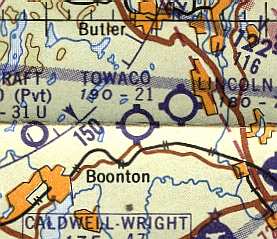
The earliest aeronautical chart depiction of the Towaco Airport which has been located
was on the 1960 NY Sectional Chart (courtesy of Mike Keefe).
It described Towaco as having a single 2,100' turf runway.
Forrest Smith recalled, “I remember only 2 or 3 planes there when I was growing up... one being a Stinson.”
The 1962 AOPA Airport Directory described Towaco as having a single 2,700' sod runway.
A 1963 aerial view depicted 3 single-engine aircraft next to the barn on the southeast side of Towaco Airport's runway.
The 1964 USGS topo map continued to label the runway simply as “Airport”.
The 1965 NY Sectional Chart (courtesy of John Voss)
described Towaco Airport as having a single 3,000' turf runway.
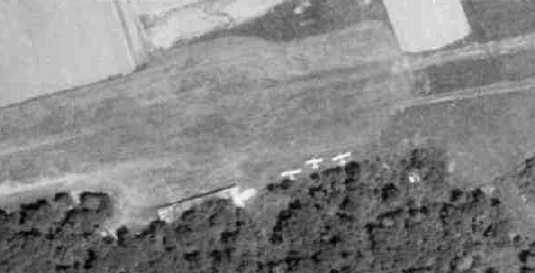
A closeup from a 1966 aerial view, showing 3 single-engine aircraft next to the barn on the southeast side of Towaco Airport's runway.

The 1968 Flight Guide (courtesy of Robert Levittan) depicted Towaco as having a single 2,600' unpaved Runway 9/27,
with a few small buildings on the south side.
The 1969 NY Sectional Chart (according to Chris Kennedy) described Towaco as having a single 2,600' turf runway.
In a 1970 aerial view, the Towaco Airport was still intact, but there were no aircraft visible on the field.
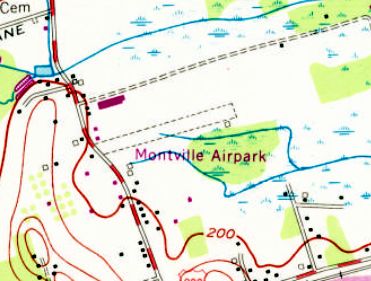
The airport was evidently renamed at some point between 1969-70,
as the 1970 USGS topo map labeled the runway as “Montville Airpark”.
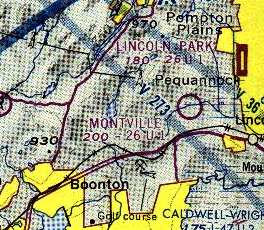
The only aeronautical chart depiction which has been located of Montville Airport
was on the 1975 NY Local Aeronautical Chart (courtesy of Mike Keefe).
Montville Airpark was apparently closed (for reasons unknown) at some point between 1975-79,
as it was no longer depicted at all (not even as an abandoned airfield)
on the 1979 NY TCA chart (courtesy of Bill Suffa).
It was still labeled "Montville Airpark" on the 1981 USGS topo map,
and "Mountville Airpark" on the 1986 USGS topo map,
but it the airport was evidently already closed by that point.
A 1987 aerial view showed that a building had been built over the southwestern portion of the runway at some point between 1970-87.
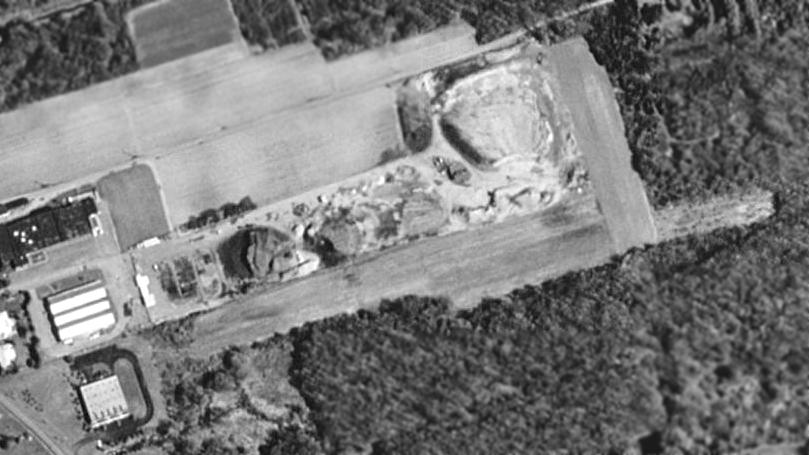
As seen in the 1995 USGS aerial photo, the site of Towaco Airport was covered by Dan Como's construction contracting site.
The airfield remains consists of a 2,000' grass runway & a shorter crosswind grass runway.
Aaron Gould reported in 2003 that "the Towaco Airport, if my bearings are correct, is still visible as an open field.
It is on private property however & is relatively unremarkable.
There are no artifacts of any sort that I could spot."
Forrest Smith visited the Towaco Airport site in 2005.
He reported, “They used to have a wind sock at the top of the old barn there, but it is gone.
The barn is still there though.”
The Towaco Airport is located on the east side of Route 202 (Jacksonville Rd).
It is located only 1.5 miles southwest of the present-day Lincoln Park Airport.
Thanks to Aaron Gould for pointing out this airfield.
____________________________________________________
Passaic County Airport / Murchio Field / Murchio Airport, Paterson, NJ
40.957, -74.237 (West of New York, NY)
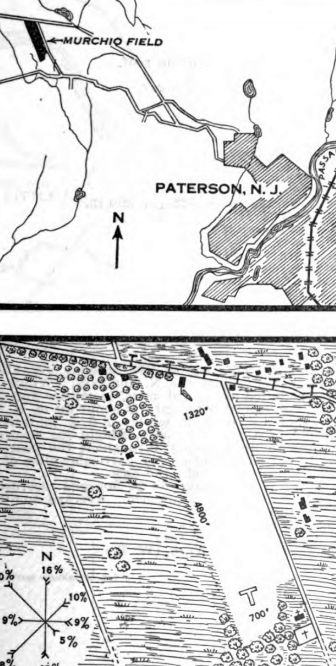
Murchio Field, as depicted on the 1928 Commerce Department Airway Bulletin.
The date of construction of Murchio Airport has not been determined.
The earliest depiction which has been located of Murchi Field
was on the 1928 Commerce Department Airway Bulletin.
It depicted Murchio Field as a rectangular clearing measuring 4,800' along the northwest/southeast axis.
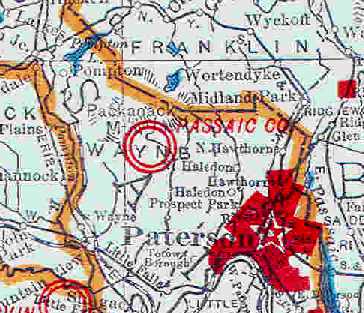
The 1930 Rand McNally "Map of NJ with Air Trails" (courtesy of Chris Kennedy)
described the "Passaic County Airport (Murchio Field)" as being operated by the County,
and described it as consisting of a rectangular field, measuring 5,000' north/south by 1,320' east/west.

A 1931 aerial view depicted Murchio Airport as consisting of an open grass field,
oriented northwest/southeast, with a few small buildings along the north side of the field.
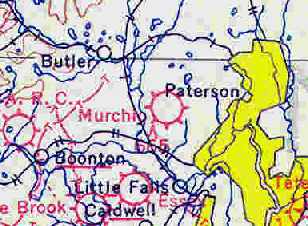
The 1934 U.S. Navy Aviation Chart (courtesy of Chris Kennedy) depicted Murchio Field as a commercial airport.
Murchio Airport was depicted as an auxiliary airfield on the 1935 Regional Aeronautical Chart.
The Airport Directory Company's 1937 Airport Directory (courtesy of Bob Rambo)
described Murchio as a commercial airport,
consisting of a 2,600' x 1,000' rectangular sod field.
A hangar was said to have "Paterson" painted on the roof.
According to the book "Wayne Township" by Cathy Tobin, crowds gathered on Sundays at Murchio’s Airport in the 1930s
to watch Bill Rhode (known as the "Smiling Daredevil") jump out of airplanes & parachute to the ground.
In 1938, Rhode jumped with 5 parachutes & set a record that he still holds.
Stan Varner recalled, "I often flew night-time 'Civil Air Patrols' 1943-44 out of Murchio's flying a 'Cub Coupe'.
It was not much of an airport then - no lights.
There was a little church located just off the southeast corner of the airport.
I remember Mr. Murchio as being older & handicapped. His daughter often helped out.
I remember they had an instructor named Bill Winterbottom.
There was also a Paterson policeman named Fred Petersen who often moonlighted there as an instructor.
There were 4 or 5 other Wright Aero engineers who rented Murchio's planes in 1943-45 to get in some flying time."
The April 1944 US Army/Navy Directory of Airfields (courtesy of Ken Mercer)
described Murchio Airport as having a 3,200' unpaved runway,
but the remarks said "Restricted to CAP [Civil Air Patrol]."
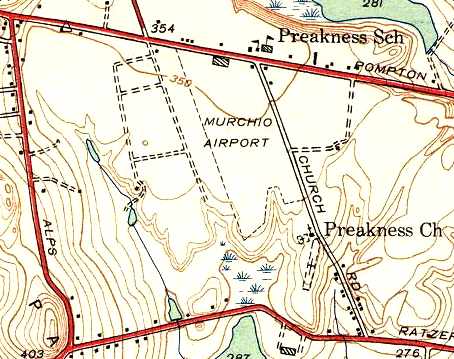
The most detailed depiction of Murchio Airport which has been located was on the 1944 USGS topo map.
It depicted the field as roughly rectangular in shape,
with the longest dimension running north-northwest/south-southeast, parallel to Church Road.
A single building (a hangar?) was depicted along the north side of the field.
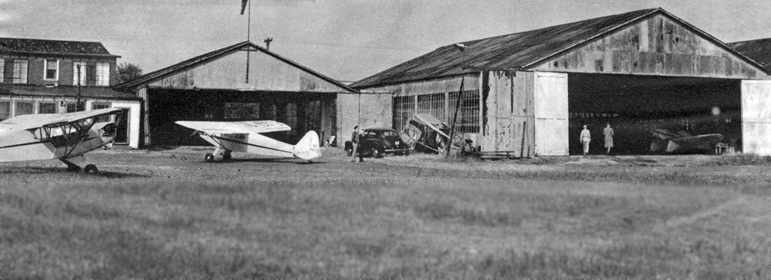
A photo of 2 Piper Cubs in front of the hangars at Murchio Airport, from a January 1946 magazine article (courtesy of Dan MacPherson).
The field was described as consisting of 92 acres,
with 3 metal hangars & a combination flight office & restaurant.

An aerial view of the hangars at Murchio Airport from a January 1946 magazine article (courtesy of Dan MacPherson).
Valerie Bornstein recalled, “Murchio's Airport... My Uncle John Syrek operated or leased the airport in the late 1940s.
My mother & aunt worked in the office. His son, my cousin Danny Syrek may have operated the airport or another nearby for a while.”
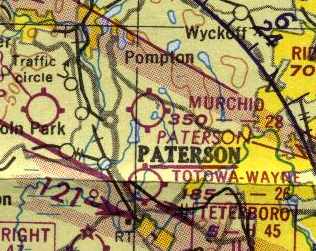
The 1950 NY Sectional Chart (courtesy of Mike Keefe) depicted Murchio Airport as having a 2,800' unpaved runway.
Alan Fischer recalled, “My father Albert Fischer was a B-24 pilot in WWII.
After coming home he was tired of flying. He got a job driving a truck for the Little Falls Laundry.
However he began instructing at Murchio's to earn some extra money as well as taking out some of the pay in flight time.
I was no more than 5 years old - 1951 when he would take me flying.
I would sit in the front of a Piper cub - so very proud & watch as Pop spun the prop.
He also took our family up in a Stinson.
He would let me 'fly' which got my mother & sister in the back seat feeling queezy to say the least.
I do recall a row of trees as well as the Church steeple at the airfield.
No one ever took a picture of us there probably because my parents couldn't afford a camera.”
Janet Nottingham recalled, “I went to school directly across the street
(known as The Paterson-Hamburg Turnpike) from the airport.
There was a plane that crashed after takeoff.
It went down just after passing over the school & killed the pilot & passenger. This was in the early 1950s.
The airport closed shortly thereafter & became a housing development.
I remember the building across the street from the school with the airplane on it as being a restaurant.”
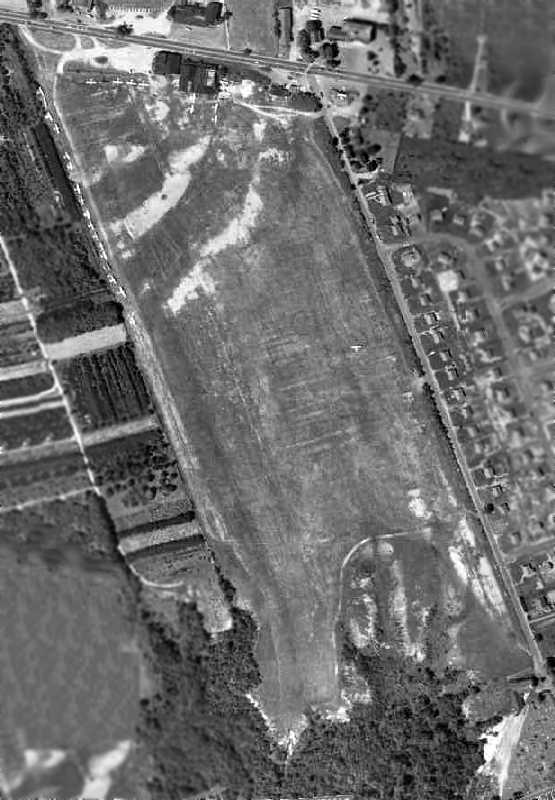
The last photo which has been located showing the Murchio Airport was a 1953 aerial view.
The field was evidently well-utilized right up to the end,
as a total of 25 aircraft were visible parked around the periphery of the northwest end of the field.
Murchio Airport was evidently closed at some point between 1953-58,
as it was no longer depicted at all on the 1958 NY Sectional Chart.
In a 1996 report by the New Jersey General Aviation Study Commission's Subcommittee on Airport Closings,
reasons were given for the closing of 13 New Jersey general aviation airports.
According to the report, "Murchio Airport closed when the owner/operator died & his survivors had no interest in the airport."
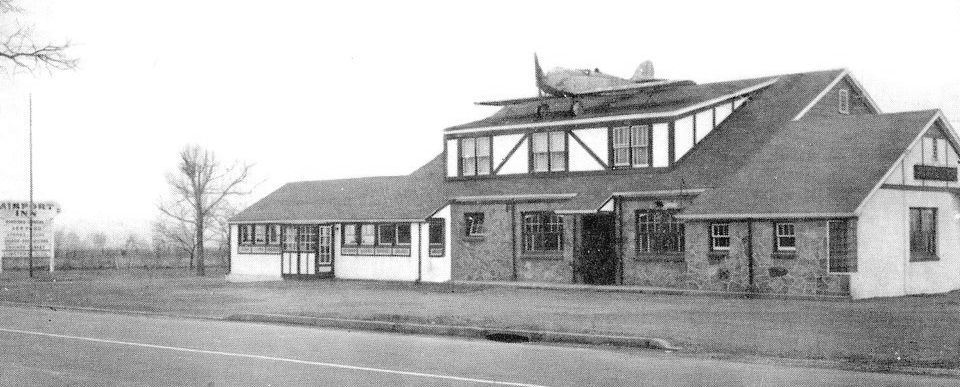
An undated photo of the Airport Inn (courtesy of Pete Milano), with an unidentified low-wing monoplane on its roof,
located at the northeast corner of Hamburg Turnpike & Church Lane, across the street from the site of Murchio Airport.
A 1966 aerial view showed that the property had been covered by housing & a shopping center,
with not a trace remaining of Murchio Airport.
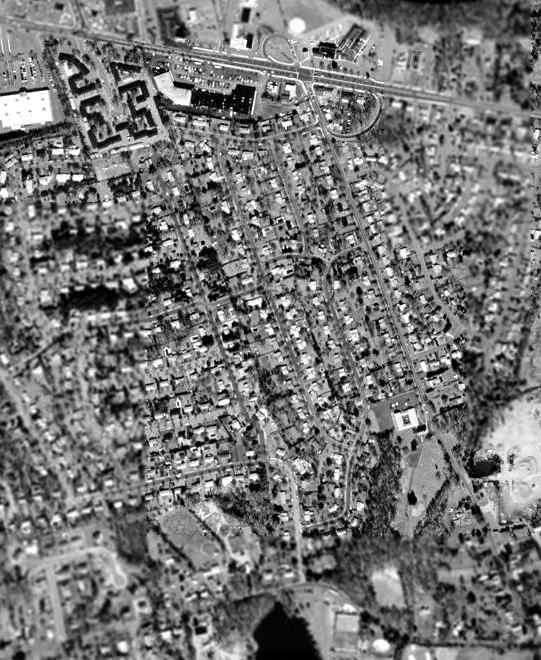
The 1995 USGS aerial photo of the site of Murchio Airport shows that it has been covered by housing & a shopping center,
and not a trace appeared to remain of the airport.
Ken Hopkins reported in 2004 of the former Murchio Airport,
"It is now the site of a Mobile gas station & the T-Bowl shopping center, and of course, houses along Church Lane.
On the other side of Church Lane on the Hamburg Turnpike, there was a building that had an airplane on it's roof.
That building is now a bank."
The site of Murchio Airport is located southwest of the intersection of Church Lane & Hamburg Turnpike.
____________________________________________________
Totowa-Wayne Airport, Paterson, NJ
40.909, -74.247 (West of New York, NY)
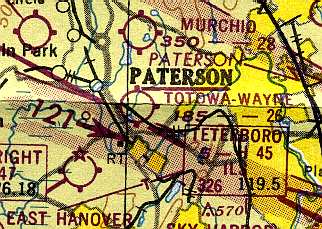
Totowa-Wayne Airport, as depicted on the 1950 NY Sectional Chart (courtesy of Mike Keefe).
This general aviation airport was evidently constructed at some point between 1949-50,
as it was not depicted on a 1931 aerial photo nor on the 1949 NY Sectional Chart (according to Chris Kennedy).
The earliest reference to Totowa-Wayne Airport which has been located
was on the 1950 NY Sectional Chart (courtesy of Mike Keefe),
which described the field as having a 2,600' unpaved runway.

The earliest photo that has been located of Totowa-Wayne Airport was a 1953 aerial view.
It depicted the field as having a single unpaved east/west runway,
with a single hangar on the northeast side,
around which were parked 9 light aircraft.
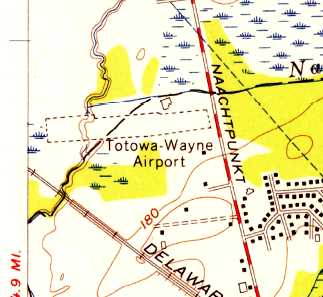
The 1955 USGS topo map depicted Totowa-Wayne Airport as having a single unpaved east/west runway.
Totowa-Wayne was depicted as a commercial airport on the 1958 NY Sectional Chart (courtesy of Norman Freed),
with a singe 2,850' hard-surfaced runway.
John De Nicola recalled, "Although I started flying at Teterboro,
I moved to Totowa-Wayne on advice of Pete Kenny because Teterboro was already getting crowded.
Pete Kenny was the aircraft mechanic who maintained Arthur Godfrey's planes.
Pete himself was a colorful character but that's another story.
The 1st entry in my log book for Totowa-Wayne was dated 10/19/56."
John continued, "You mention the length of the runway as 2,850'.
That's correct because I remember my instructor mentioning that to me.
About one third of the runway at each end was hard-surfaced.
The center third was more like a gravel road. Hard, but a lot of loose gravel."
"The owners & operators of Totowa-Wayne Airport were Jacob Brain & Jacob Brain, cousins.
One was generally known as Jack Brain.
The other was generally known as Jake Brain.
Jack was the flight instructor, although they had other instructors,
and did all the flying part of the business.
His cousin, Jake, was more concerned with running the office & the repair shop.
As a side note, Jack was an FAA flight examiner & gave me my flight test when I finally got my private ticket."
Totowa-Wayne was also "locally known as Brain Field" (according to Dick Greene).
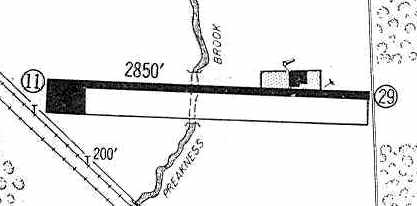
The 1960 Jeppesen Airway Manual (courtesy of Chris Kennedy)
depicted Totowa-Wayne as having a single 2,850' paved Runway 11/29,
with a ramp on the northeast side with a single hangar,
and another ramp on the southwest end of the runway.
Totowa-Wayne Airport, as depicted on the 1961 NY Local Aeronautical Chart (courtesy of Mike Keefe).
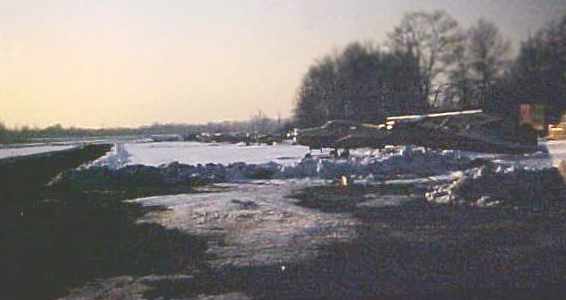
A December 1961 photo of Totowa-Wayne Airport by Wayne Hansen,
looking west from the hangar along the taxiway north of the runway.
Wayne Hansen recalled, “Growing up in Montclair, NJ,
I took my 1st flight instruction in June 1961 at Totowa-Wayne about 10 days after high school graduation.
I soloed the end of the summer in the early straight-tail Cessna 150s they used for training.
I remember Jack Brain & his wife who ran the airport, and the 2 or 3 instructors I had,
and have log book entries for all of them.”
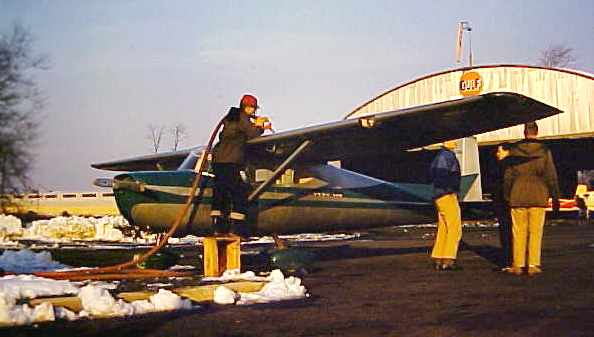
A December 1961 photo by Wayne Hansen looking northeast at Totowa Wayne Airport,
of a lineman fueling N5739E, a 1959 Cessna 150 'Straight Tail', s/n 17239.
Wayne remarked that this was “one of 4 early Cessna 150's that the airport had for flight training & rental.”
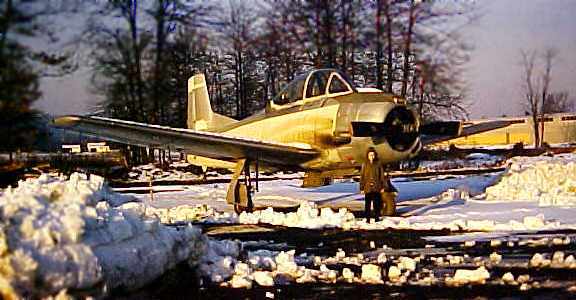
A December 1961 photo by Wayne Hansen of David Hansen in front of a T-28 Trojan at Totowa-Wayne Airport.
The 1962 AOPA Airport Directory described Totowa-Wayne Airport as having a single 3,000' asphalt Runway 9/27,
and listed the operator as Jack Brain.
The Aerodromes table on the 1965 NY Sectional Chart (courtesy of John Voss)
described Totowa-Wayne as having a single 2,850' asphalt runway.
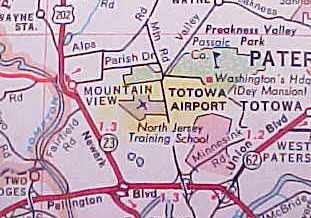
Totowa Wayne Airport, as depicted on a 1965 NJ road map (courtesy of Wayne Hansen).

A closeup from a 1966 aerial view showed how well-utilized Totowa Wayne Airport was right up until the end,
with a total of over 32 aircraft visible parked outside.
Note the hangar with “Totowa Wayne” painted on the roof.
An aerial photo looking west at Totowa Wayne Airport, from an advertisement on a street map (circa late 1960s?), courtesy of Mark Mastroieni.
It depicted the field as having a paved runway, a paved taxiway & ramp,
and a single arched-roof hangar with attached office.
The operator was listed as Brain Flights Inc.
John De Nicola recalled, "Totowa-Wayne was partly in Totowa & partly in Wayne, hence the name Totowa-Wayne.
It was never quite clear to me where the line was that put the airport in the 2 townships.
However, from the conversations back then,
I surmised that the creek that cut across the middle of the runway was the boundary between the 2 towns.
In the picture [above] you will note the suggestions of a smudged line
cutting across the runway about halfway down at the 1st bend in the taxiway.
That was the creek.
On occasion when we got an unusually heavy rain & the creek overflowed leaving the area near the creek underwater.
That's the runway the taxiway & the tie-down area (which is behind the words "BRAIN" & "Riverview" in the picture).
Heavy steel structures shaped like an inverted U were used to span the creek, both the runway & taxiway.
This may explain the reason the middle of the runway was more like a dirt road.
It was easier to grade the runway so that when you rolled from the ground to the 'bridge' section
and then back to the hard ground there would be no bumps.
Every once in awhile they graded it to keep it fairly smooth."
Thomas Ploch recalled, "Totowa-Wayne Airport was on Riverview Drive near the Totowa Wayne border.
The threshold was very close to the road.”
Totowa-Wayne was still depicted as an active airport on the 1967 NY Local Aeronautical Chart (courtesy of Mike Keefe),
and described as having a single 2,850' asphalt runway.
John De Nicola recalled, ""Totowa-Wayne Airport closed sometime in 1967.
I was still living in New Jersey when they started to sell off the assets of the airport
and remember going there one day to see the dismemberment of an airport."

The last airport directory listing which has been located of Totowa Wayne Airport was in the 1968 Flight Guide (courtesy of Robert Levittan).
It depicted Totwa Wayne as having a 2,850' paved Runway 10/28, and a ramp with 2 buildings on the northeast side.
In a 1996 report by the New Jersey General Aviation Study Commission's Subcommittee on Airport Closings,
reasons were given for the closing of 13 New Jersey general aviation airports.
According to the report, "Totowa-Wayne Airport,
which was one of the best & most profitable airport operations in the State,
was forced to close after the township doubled the taxes in 2 consecutive years.
The most often recommended suggestion for tax relief,
eliminated taxes on public use portions of an airport such as runways & taxiways,
even if feasible, would not solve the problem.
Communities could still raise the rate on the taxable portion of the airport to drive the operator out of business,
as was done, for example, at Totowa-Wayne, a successful operation."
John De Nicola observed, "The issue of real estate taxes as the reason for closing is accurate.
Over the years we had numerous occasions to talk to Jack about many things.
I distinctly remember Jack telling us about the problems he was having with the local politicians
on more than one occasion & the tax issue.
But of course what really struck fear in my heart
was when he said that if they raise the taxes again he will have to close the airport."
Thomas Bowdler recalled, "I don't remember the exact year it was torn up but an industrial park was built on the site,
the main road of which paralleled the runway, perpendicular to Riverview Drive."
Totowa-Wayne was no longer depicted at all on the 1969 NY Sectional Chart (according to Chris Kennedy).
A 1970 aerial view showed that a large industrial building had been constructed over the eastern portion of the runway,
but the western half remained clear.
The smaller hangar had been removed at some point between 1966-70,
but the larger hangar remained standing.
A 1979 aerial view showed that all traces of the airport had been removed at some point between 1970-79,
with several large industrial buildings having been built over the remainder of the former airport,
covering the western portion of the runway & the site of the main hangar.
A circa 2001 aerial photo of the site of the Totowa-Wayne Airport.
The area has been redeveloped as an industrial park,
and not a trace appears to remain of the airport.
According to Thomas Ploch,”Today Thomas's Muffins & Roche have buildings on the site."
Totowa-Wayne Airport was located near the intersection of Riverview Drive & Edison Drive.
____________________________________________________
East Hanover Airport / Hanover Airport (N58), Hanover, NJ
40.84, -74.345 (Northeast of Morristown Municipal Airport, NJ)
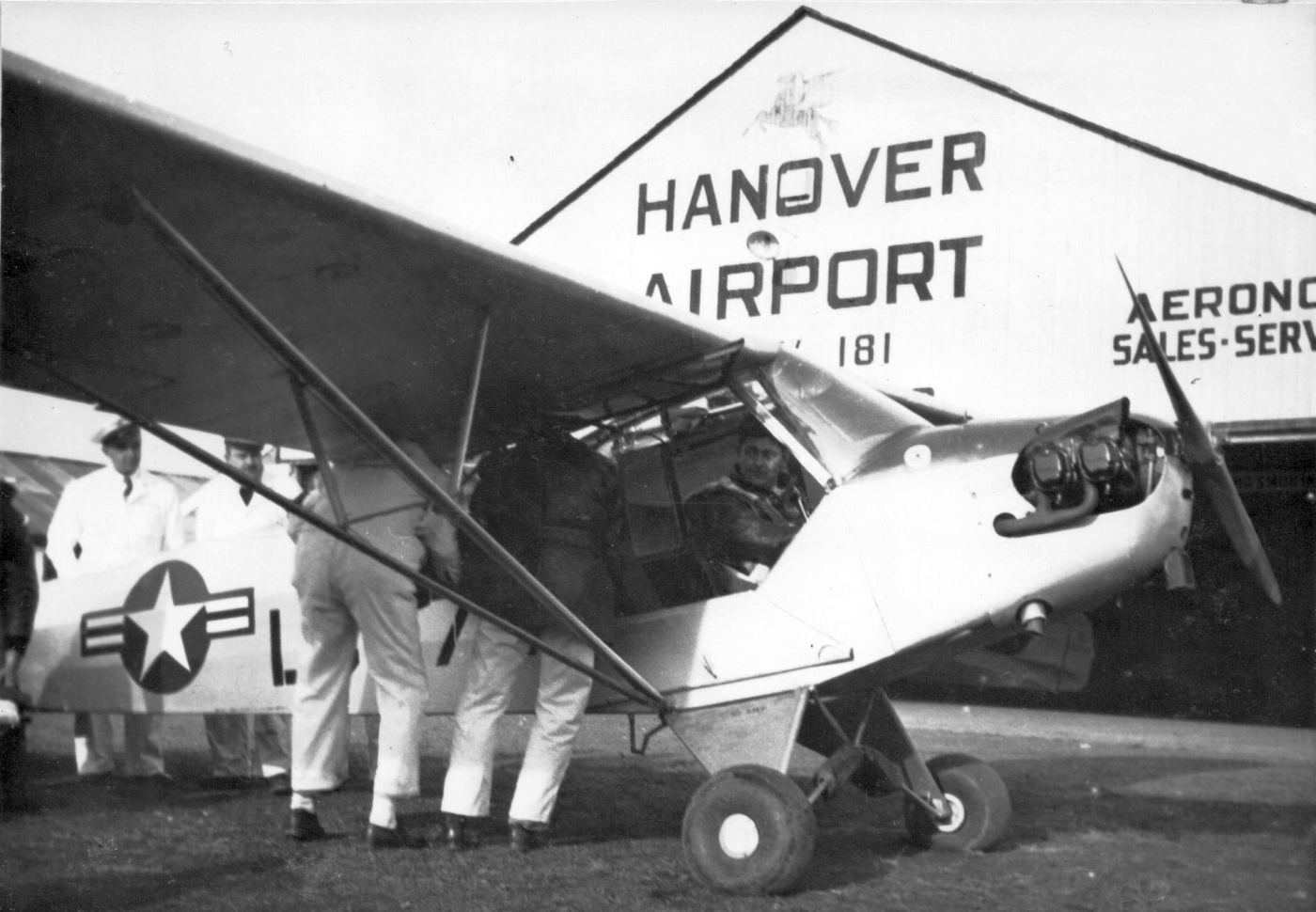
A 1946-49 photo by Don Reid (courtesy of Bruce Reid) of a Civil Air Patrol rescue/evacuation practice with a Piper L-4 Cub in front of a Hanover Airport hangar.
No airfield was yet depicted at this location on a 1931 aerial photo.
An article in the Daily Record reported that Gertrude Tannenbaum's father
had started the East Hanover Airport on his farm sometime between 1944-49.
According to David Schober, “My father.. He operated the airport [Hanover] when it opened after WWII for a couple years;
I would guess between 1946-49.
Tom Oram was actually one of my dad's students, and I think he took over after my dad went to work elsewhere.
It was during that time frame that the runway was changed from grass/mud to gravel.”
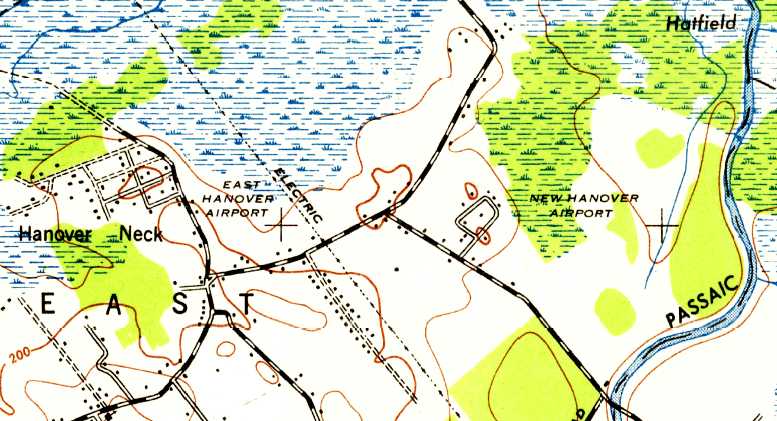
The 1947 USGS topo map depicted both an “East Hanover Airport” & a “New Hanover Airport” to the east.
The earliest aeronautical chart depiction which has been located of East Hanover Airport
was on the 1949 NY Sectional Chart (according to Chris Kennedy).
It depicted East Hanover Airport as having a 2,000' unpaved runway.
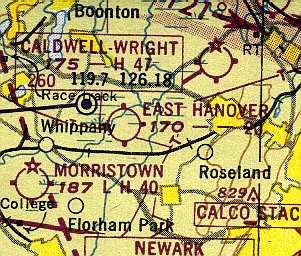
The 1950 NY Sectional Chart (courtesy of Mike Keefe)
depicted East Hanover Airport as having a 2,000' unpaved runway.
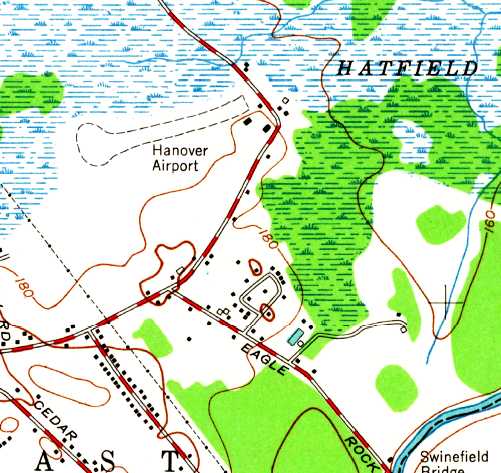
The 1954 USGS topo map depicted the “Hanover Airport” as having a single unpaved northeast/southwest runway,
with a few small buildings on the east side.
The “New Hanover Airport” to the east was no longer depicted.
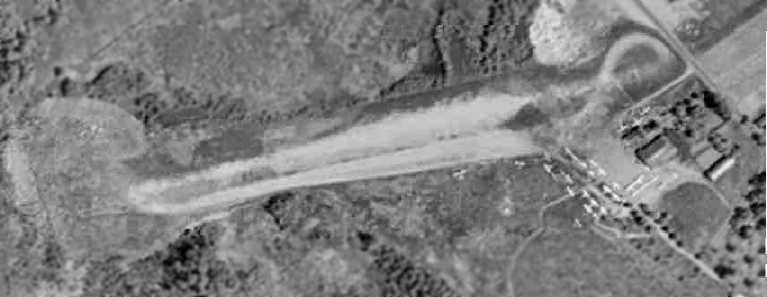
The earliest photo which has been located of Hanover Airport was a 1957 aerial view.
It depicted the field as having a single unpaved northeast/southwest runway.
A hangar & other small buildings sat at the east end of the field,
around which were visible 27 light aircraft.
Hanover Airport was depicted on the 1958 NY Sectional Chart (courtesy of Norman Freed)
as having a single 2,500' turf & bare runway.
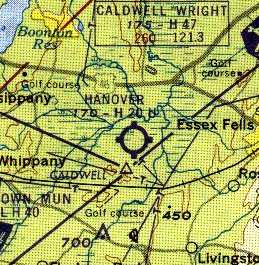
The runway at Hanover had been paved at some point between 1958-61,
as the 1961 NY Local Aeronautical Chart (courtesy of Mike Keefe)
described the field as having a single 2,000' asphalt runway.
Ronald McCormack recalled, “I made my 1st solo flight from Hanover in a Piper Supercub in 1961.
My instructor was Claud Brown.
He was a former crop duster & he had a terribly deformed leg sustained in a crop dusting accident.”
The 1962 AOPA Airport Directory described Hanover as having a single 2,000' paved runway,
and listed the operator as Thomas Oram.
A 1963 aerial view depicted Hanover's newly paved runway.
Skip Degan recalled, “My 1st flight lesson was 6/17/64, with Bill Rhode CFI.
I soloed a Luscombe at Hanover on 7/28/64, 8 hours with Mr. Rhode's sign-off.
I was a member of the Icarus Flying Club.
I think Mr. Rhode had well over 20,000 instructor hours at that time.
Hanover was a real neat place for a kid into aviation.
It had a restaurant that was second-to-none.
It had hundreds of airplane models hanging from the ceiling & a small lunch counter.
Tom Oram's daughter & son-in-law worked at the place.
I remember there being a hangar full of great airplanes, including a Staggerwing, among others.
Down the tie-down line was Ernie White's T-6, which I had the pleasure of riding in on a short hop to Cherry Ridge in PA.”
Thomas Oram owned & operated the Hanover Airport for over 20 years.
He had a life long love for flying & was licensed to operate of both fixed wing aircraft & helicopters.
He received recognition & many awards for his assistance in rescue work,
hunting fugitives from the law & surveying traffic snarls,
including a Gold PBA award for his service when he went up in his helicopter in pursuit of bank robbers.
He brought joy to kids by flying Santa in a helicopter to a number of shopping centers during the holidays
& landing with Batman & Robin at White Meadow Lake.
Tom Gilbertson recalled, “My father, John Gilbertson was a TWA Flight Engineer
and in the early 1960s the pilots' union demanded that flight engineers obtain their commercial pilot's license with instrument rating.
Once he had his license he went looking for an airplane.
In December of 1964 he found a Taylorcraft for sale at Hanover Airport.
He bought the airplane from Jack Lenehan.
My father, brother Jack & I had the Taylorcraft based at Hanover from 1964-70.”
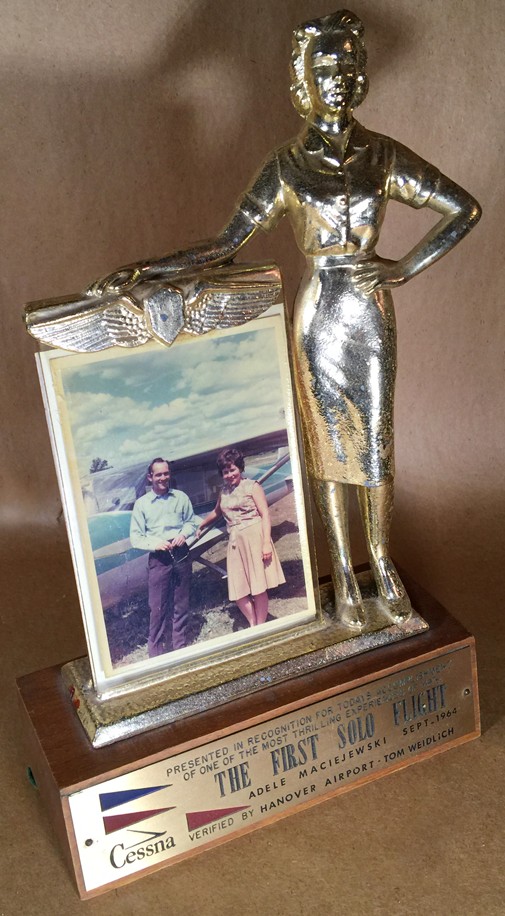
A photo by Sandee Weiner of a trophy sent by Cessna to her mother, Adele Maciejewski to commemorate her September 1964 first solo flight from Hanover Airport, instructed by Tom Weidlich.
Sandee Weiner recalled, “My mom & father both flew out of Hanover Airport.”
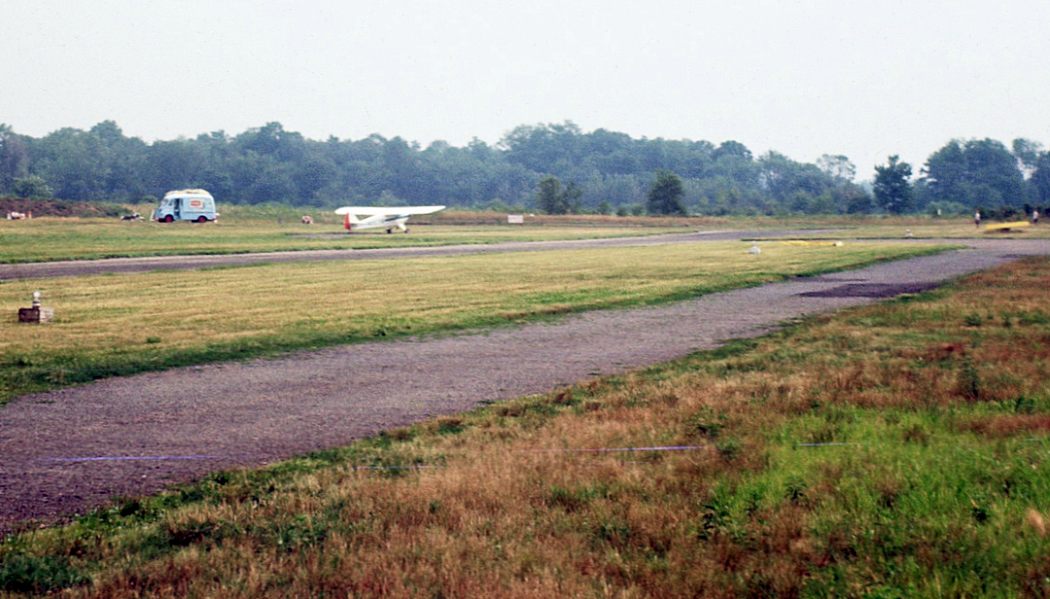
An August 1965 photo by Tom Gilbertson at Hanover Airport “taken from the west end of the taxiway towards the approach end of Runway 27.
You can see a blue hot dog truck on Ridgedale Avenue. He sold a lot of hot dogs on the weekends!
People would be all over the place to watch the airplanes.”
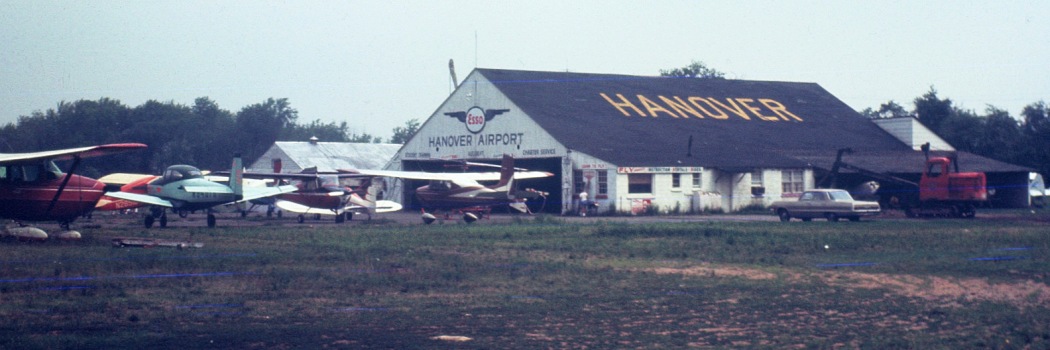
An August 1965 photo by Tom Gilbertson of the Hanover Airport hangar.
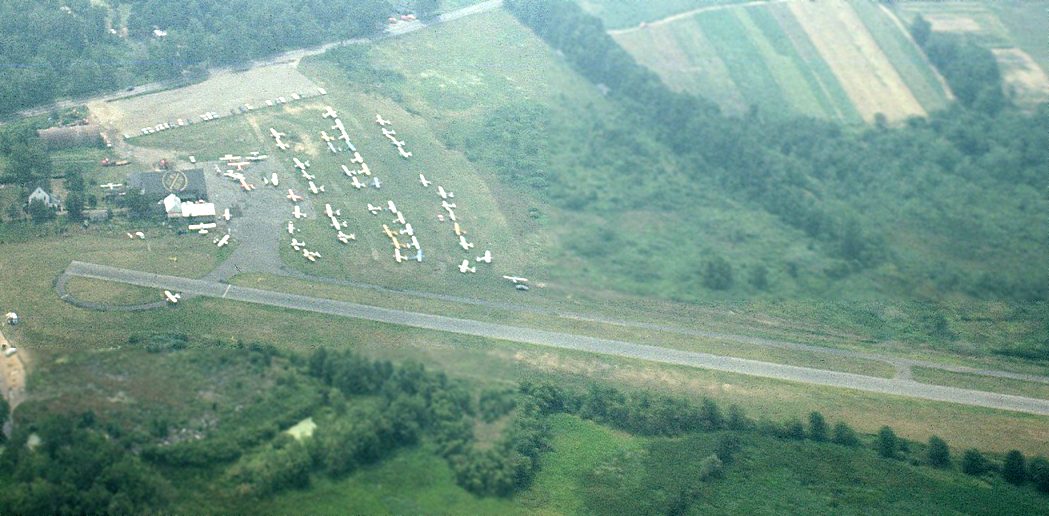
An August 1965 aerial view by Tom Gilbertson looking south at Hanover Airport.
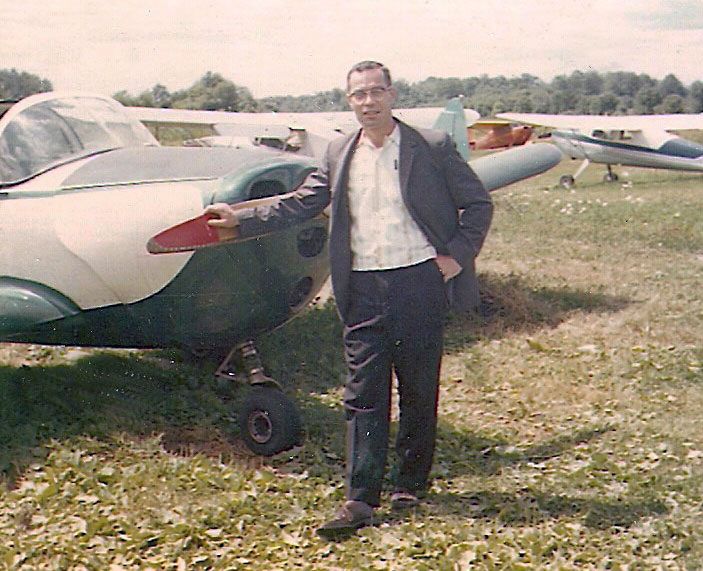
A 1965 photo by Ellie Maciejewski of Stanley Maciejewski in front of their 1946 Ercoupe at Hanover Airport (courtesy of Sandee Weiner).
Sandee Weiner, their daughter, recalled, “My father re-fabric'ed the 1946 Ercoupe himself, and painted it a nice red & white.
He even drove it to our house along Ridgedale Avenue - after taking the wings off!”
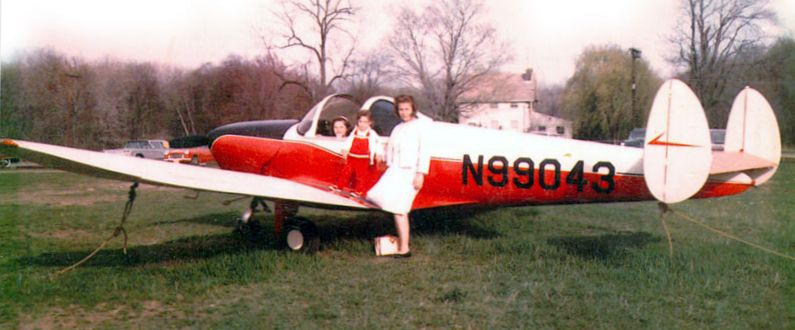
A 1965 photo by Stanley Maciejewski of Ellie Maciejewski, her daughter Sandee standing on the wing,
and Sandee's sister in the cockpit of their Ercoupe at Hanover Airport (courtesy of Sandee Weiner).
Sandee Weiner, their daughter, recalled, “ Although both my parents had their pilot’s licenses, we never actually all flew together - neither did my Mom & Dad - they only went up alone.
My mom said that when I was little, she would 'tie' me to the hangar ... basically a rope tied to my baby walker.
She said I would sit there all day, bouncing up & down watching her do touch-n-go's!”
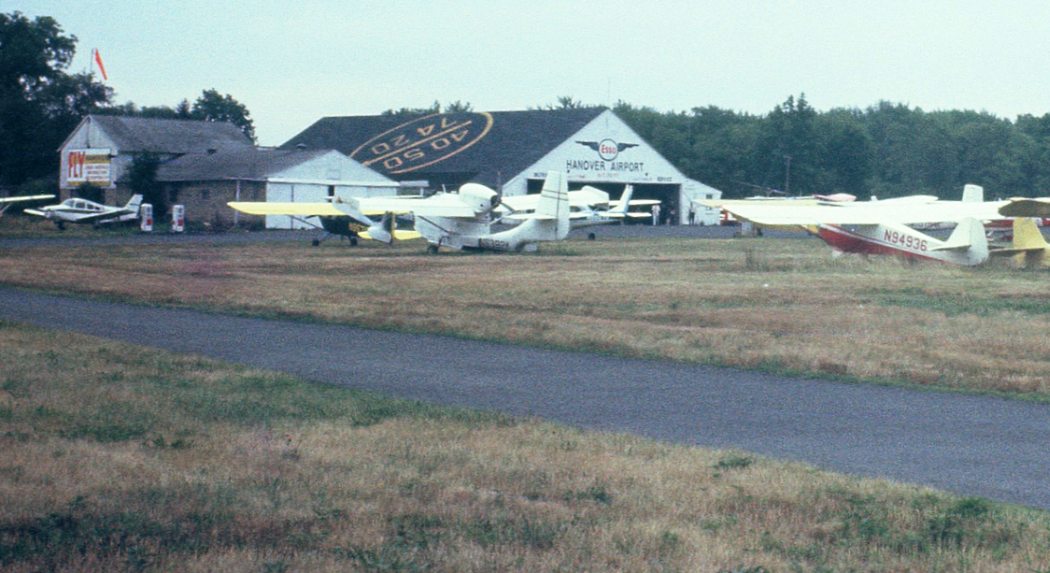
A 7/30/66 photo by Tom Gilbertson of planes parked in front of the Hanover Airport hangar, including a Republic SeaBee amphibian.
Tom Gilbertson recalled, “My father taught me some basics but since he was not an instructor I flew with Bill Rhode who was an incredible pilot & instructor.
Anyone who remembers Hanover will remember Bill. I made my first solo in the Taylorcraft on 6/23/67 at 16 years old.
My brother Jack also learned to fly in it & went on to an airline career with Allegheny Airlines/USAir.
Hanover was an extremely friendly place. We made a lot of friends there.
Even when the weather was not good we would go to the airport & socialize at the lunch counter that was run by Helen, Tom Oram's first wife.
Along with all of the airplanes I also remember a 1956 Ford Country Squire
that had been put out to pasture in the weeds alongside the maintenance hangar by the Runway 27 approach end.
It had 'Fly Hanover Airport' in big letters on both sides.”
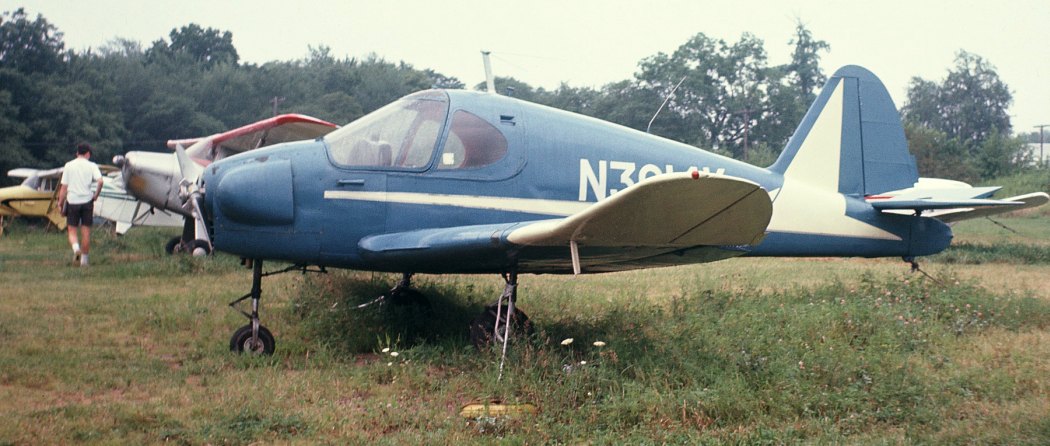
An August 1967 photo by Tom Gilbertson at Hanover Airport of “an odd duck - a Culver Cadet.”
Bill Fusselmman recalled, “Hanover Airport... During the time period 1967-69, I was a newly-minted Commercial Pilot, 26 years old.
Tom Oram gave me a job flying 'Sky Rides' on weekends in one of his Cessna 172s.
I probably have logged well over 1,000 takeoffs & landings at Hanover Airport flying those sky rides taking people up on weekends for an 18 minute flight.
Tom complained that he was losing money if I took more than 18 minutes!
When I got my Certified Flight Instructor rating, I became an instructor also in addition to doing the sky rides, instructing in Tom's Cessna 150s & 172s, circa 1968.
I did a few pilot checkouts for ICARUS Flying Club members in addition to my regular flight instructor duties for Tom.
Tom also took me for a few evening rides in his helicopter when we closed up for the day.
I remember when Tom & Helen Oram's daughter, Jill, married a young guy named Billy, about 1968.”
The 1968 Flight Guide (courtesy of Robert Levittan) depicted Hanover Airport
as having a 2,000' paved Runway 9/27, and a ramp & several buildings on the southeast side.
David Schober recalled, “Hanover Airport... I learned to fly there in 1969 with my father as my flight instructor.”
A 1970 aerial view depicted the main hangar at Hanover, and over 60 light aircraft visible parked on the field.
According to Mac Lewis (who learned to fly at Hanover in 1972),
the locals referred to it as "Hangover International", as it was a very loose operation.
There was a power line fairly close to the southwest runway end.
This led to developing skill at a high approach & slipping to final for landing.
David Schober recalled, “There were 2 hangars there up through 1973.”
Hanover's main hangar burned down in 1973,
according to an article that appeared in the Newark Star-Ledger in 2000.
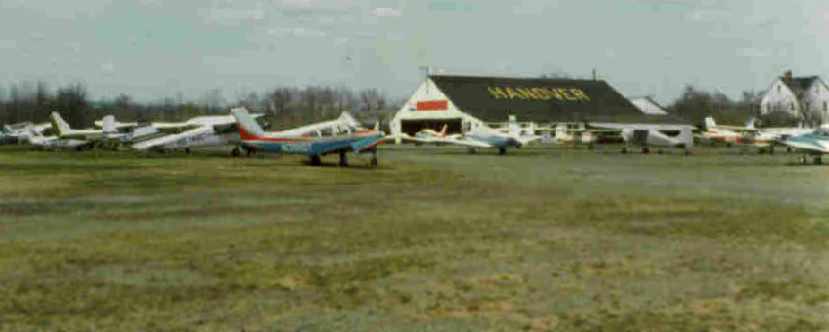
An April 1975 photo by Tom Gilbertson of a large number of aircraft in front of the hangar at Hanover.
According to David Schober, this picture “is of the smaller hangar that was used for maintenance.
The larger hangar was a fair amount larger with a Quonset-type roof.
It was located adjacent to the one in the picture, a little to the right and closer to the camera.”
The 1975 NY Local Aeronautical Chart (courtesy of Mike Keefe)
depicted Hanover Airport as having a 2,000' paved runway.
In spite of Hanover having such a short runway, Richard Krentz recalled,
"I landed a DC-3 at that place when it was active.
I think we did that around 1975.
Landing the DC-3 at Hanover was a piece of cake,
but, getting out of there was another story.
Luckily the tree line was shallow on the departure end,
however, getting over the power lines a short distance from there was another story.
We were a gutted ship with not too much fuel aboard.
At full power from the stop, rotation was started at about 1,000' or so & a slow climb was initiated.
As we approached the wires we made a shallow turn to parallel the wires
and the rest was history as we climbed out.
Needless to say that noise abatement was an issue for a few days after that."
Erika Eick recalled, "At Hanover, I took lessons with the Civil Air Patrol in a beat-up Cessna 150, around the mid-1970s."
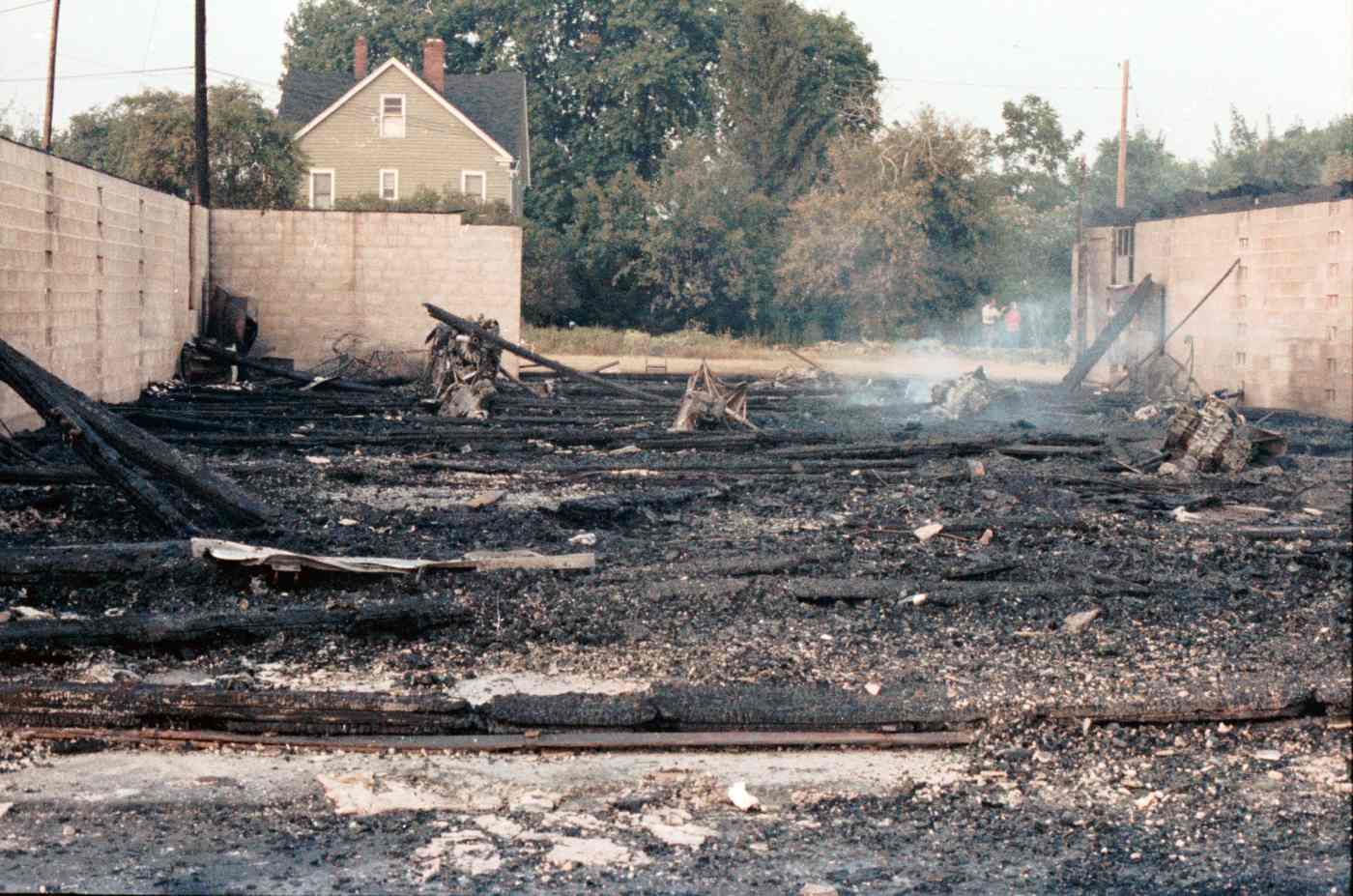
A circa 1976 photo by Neal Lanetti of the still-smoking remains of the Hanover Airport hangar.
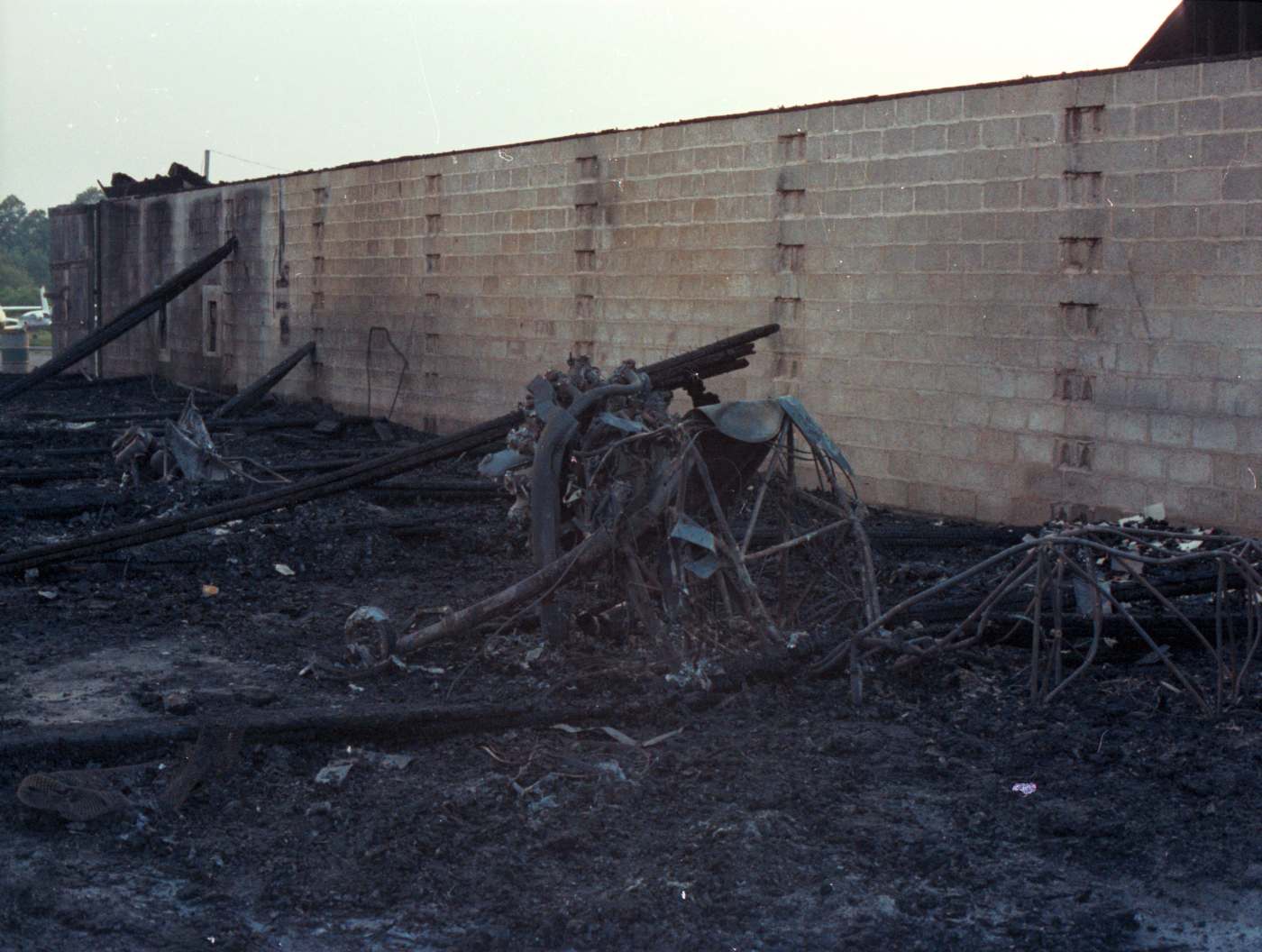
A circa 1976 photo by Neal Lanetti of the still-smoking remains of the Hanover Airport hangar.
A circa 1976 photo by Neal Lanetti of the remains of the Hanover Airport hangar after the fire.
Neal noted, “This is what's left of the tubular frame of a biplane (Stearman?) complete with radial engine.”
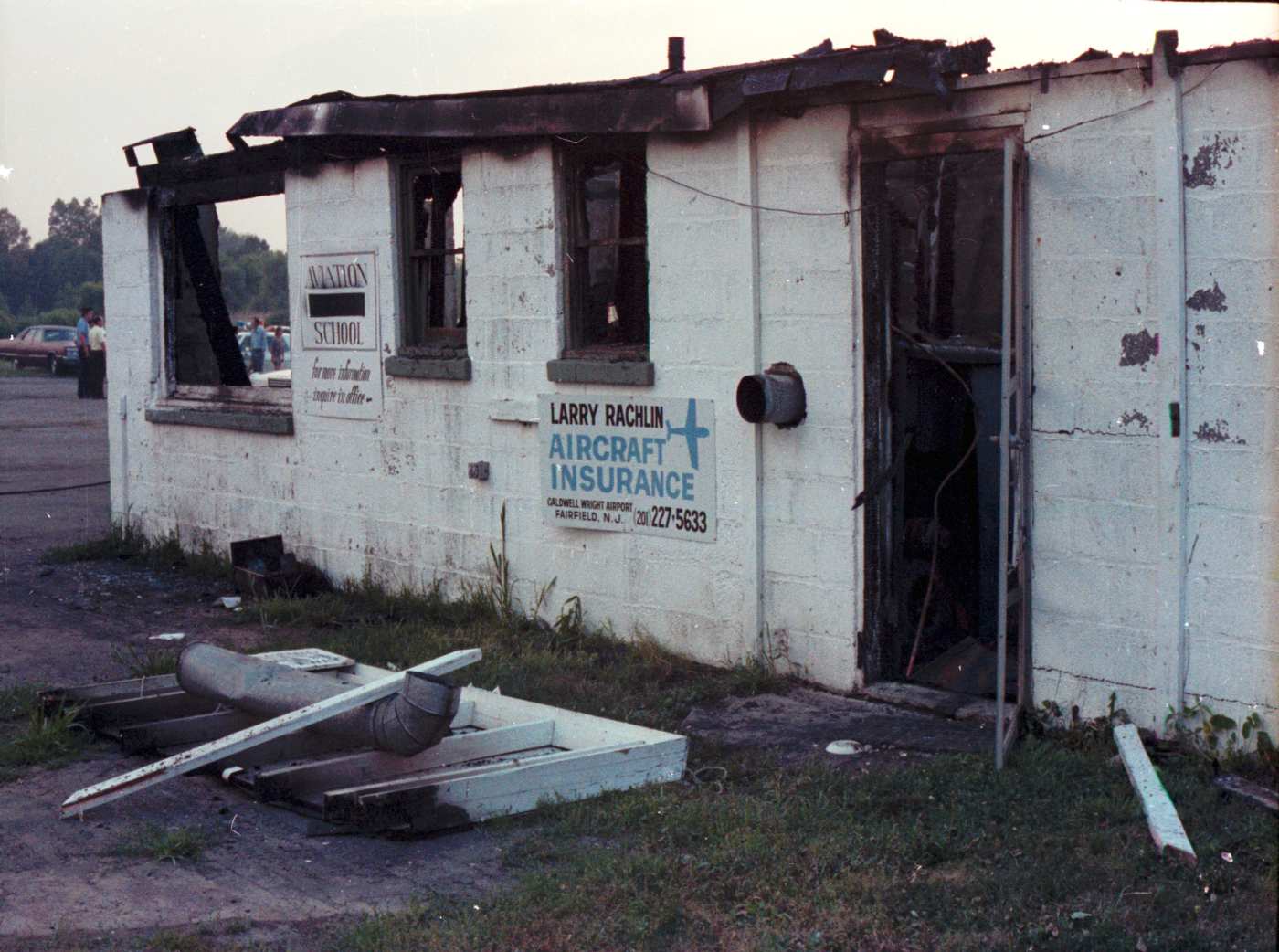
A circa 1976 photo by Neal Lanetti of the remains of the Hanover Airport hangar after the fire, ironically showing an insurance sign on the hangar wall.
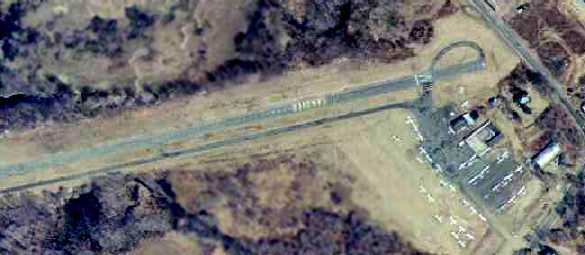
A 1979 aerial view depicted the remains of Hanover's main hangar (which had burned down several years before).
The airport was still very well-utilized, with a total of 40 light aircraft visible parked outside.
Hanover was still depicted as an active airfield on the 1979 NY TCA chart (courtesy of Bill Suffa).
It was shown as having a single 2,000' paved east/west runway.
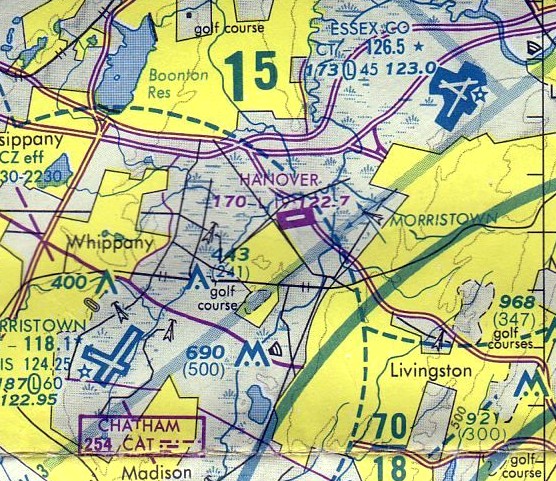
The last aeronautical chart depiction which has been located of Hanover Airport
was on the June 1982 NY Terminal Aeronautical Chart (courtesy of Mitchell Hymowitz).
Hanover's depicted runway length had decreased to a mere 1,900'.

The 1983 Flight Guide (courtesy of Chris Kennedy)
depicted Hanover as having a single 1,957' paved Runway 9/27,
with a parallel taxiway on the south side
leading to a ramp on the southwest corner of the field with an office & one other building (a hangar?).
This airport's history started to come to an end in 1984.
According to an article by Joe Malinconico in the 10/8/85 issue of The Daily Record,
Anthony Pugliese bought the land in 1984 from Ethel Steppel & Gertrude Tannenbaum.
Pugliese planned to build a 217,000 square foot office complex on the 53-acre site.
However, the land was zoned residential at the time
and a variance would have been required to build an office complex on the site.
Pugliese apparently sent the township a letter stating his intentions
to construct low-income housing on the site if his bid for an office complex was refused.
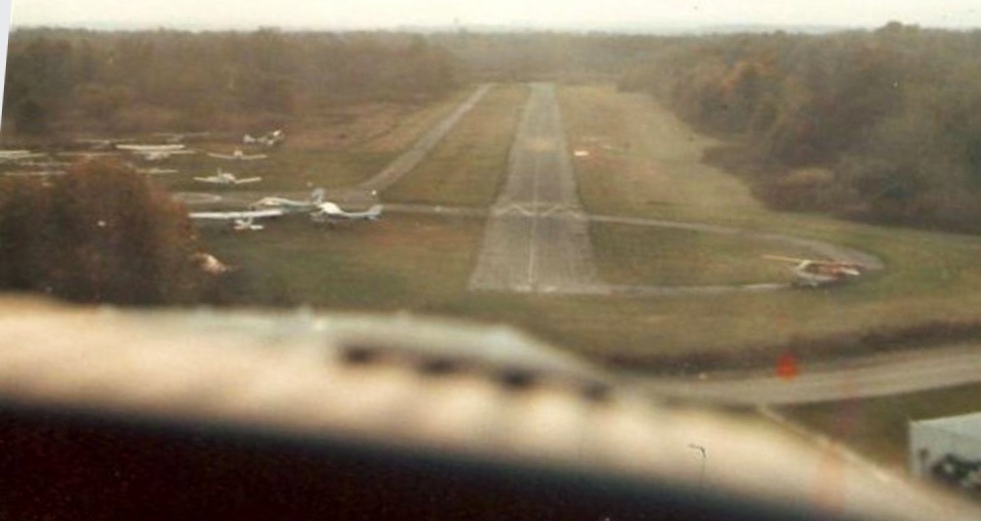
The last photo that has been located showing Hanover Airport while it was still open was a 1985 aerial view (courtesy of George Schaefer).
George reported, the “picture was taken from inside my plane by Patricia Farnsworth in the right seat as we were landing at Hanover shortly before it closed about 1985.
The aircraft was Piper Cherokee 140, N9743W. I miss the old place!”
One of the airport's licenses, issued by the FAA, had expired at the end of August, 1985,
and the new owner, Pugliese, refused to apply for renewal.
He announced the airport's closure.
According to Udo Ottenfield, who had managed the airport for about 6 years,
all planes at the airport would be removed by Friday, October 11.
Ottenfield claimed that the airport had been losing money to the tune of $10,000-$15,000 / year.
At its closing, the airport was the home of Eagle Flying Services, a flying school, as well as aircraft salespeople & mechanics.
There were also plane rentals available at the airport. It was usually home to about 75 small aircraft.
In a 1996 report by the New Jersey General Aviation Study Commission's Subcommittee on Airport Closings,
reasons were given for the closing of 13 New Jersey general aviation airports.
According to the report, Hanover Airport closed because it was rundown, mismanaged,
and not producing enough revenue to carry itself,
and its absentee owners were not interested in owning a facility which provided no return.
Although it had already been closed, Hanover was still depicted as an airfield on the 1986 USGS topo map.
A 1987 aerial view depicted the empty ramps of the closed airport.
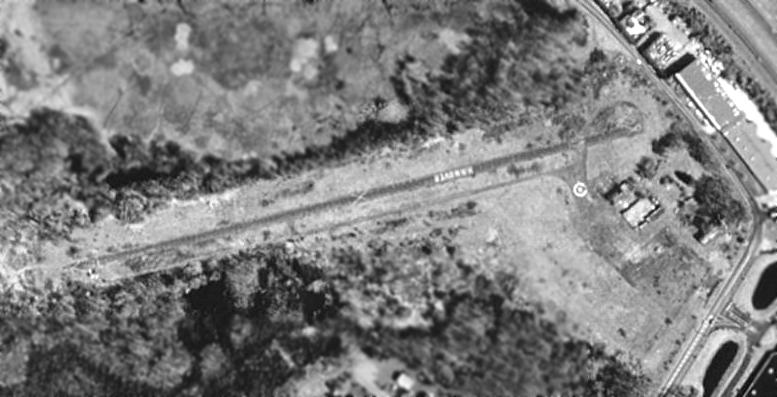
USGS aerial photo 1995.
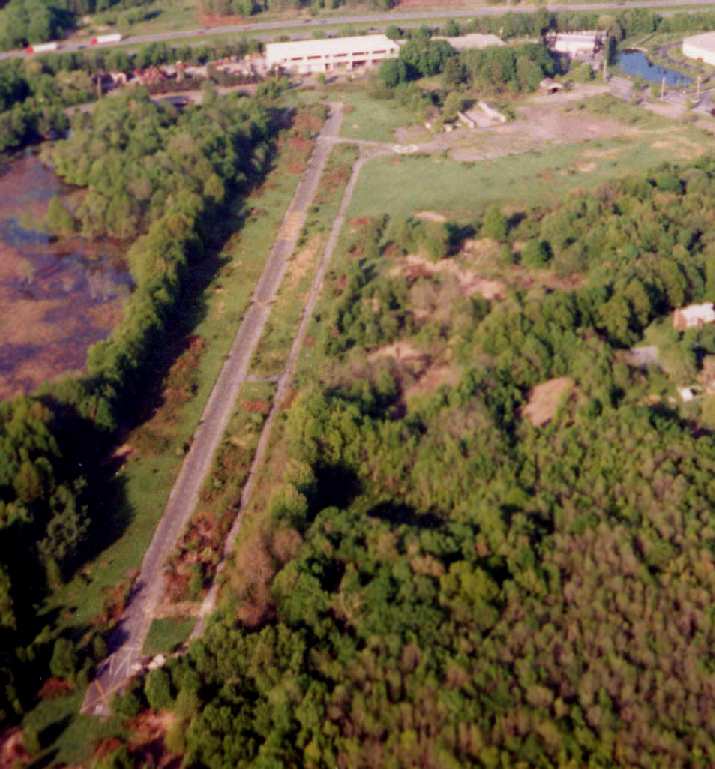
A 1996 aerial view looking east at the remains of Hanover Airport by Philip Kineyko.
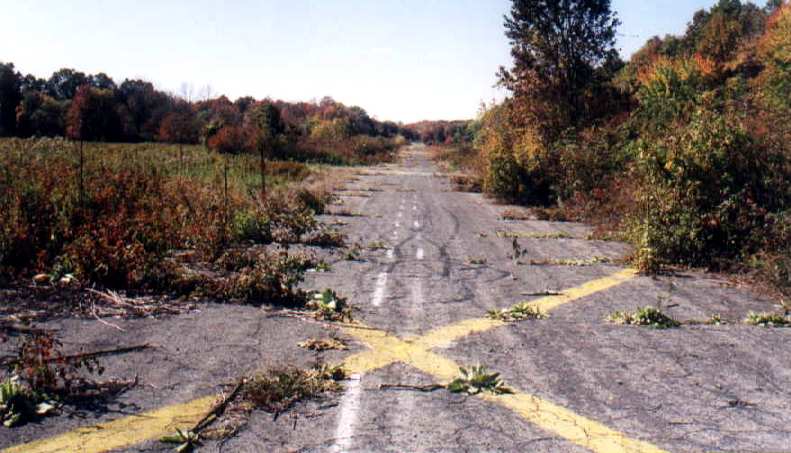
A 2001 photo of the overgrown remains of the runway at Hanover Airport.
Photo is © 2001 by Bill Treloar, used by permission.
The airfield consists of a single 2,000' paved runway, a parallel taxiway,
a small paved ramp, and a Quonset hut style hangar & a few buildings, which still stand.
The runway has become overgrown & has painted "X" closed runway markings,
but also still has "Hanover" painted on its midsection.
In general, none of the airport facilities have been removed.
Part of the airfield property is used by a local industry for parking.
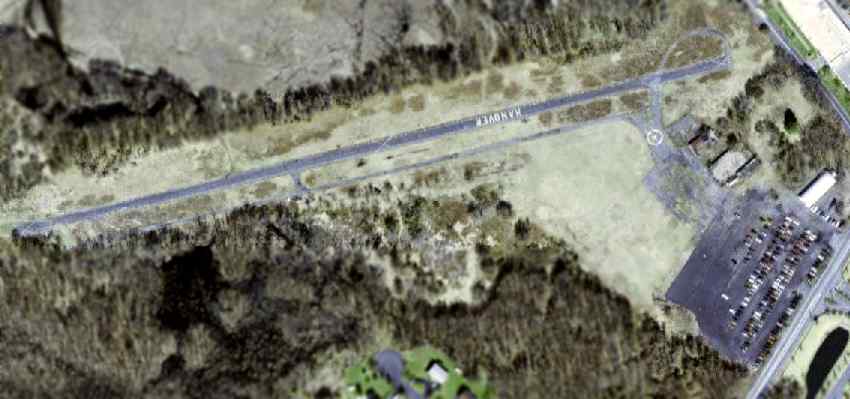
A circa 2001-2005 USGS aerial photo of the airfield, which remained largely intact.
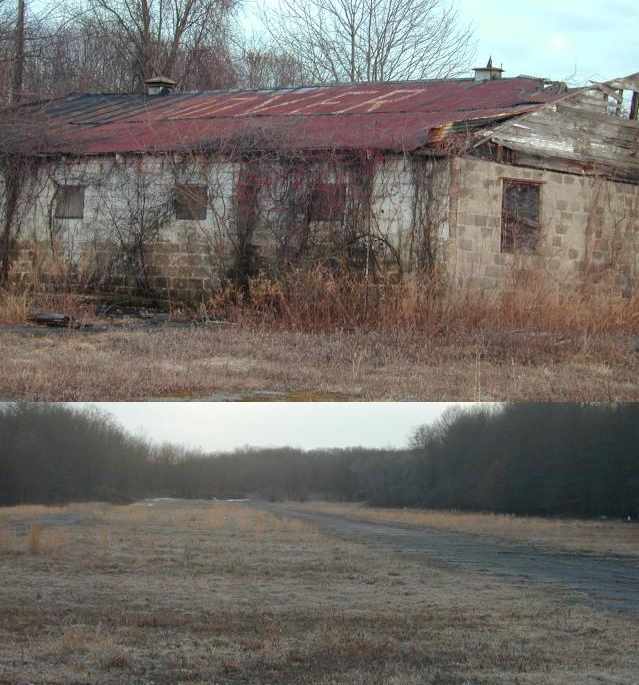
Two circa 2001-2002 photos of the hangar & runway at Hanover (courtesy of Skip Degan).
Aaron Gould reported in 2003 that "the runway is slowly becoming unusable
for anything but the most dire aviation emergencies.
I recently drove out onto the field
and found there to be several potholes which pushed my suspension to the limits.
I'd hate to feel them in a 172 at 40kts."
A web site for a local realtor states,
"There is much interest in (and controversy over) rezoning this piece of real estate."
Aaron Gould reported in 2004, "I observed a survey crew on the runway taking measurements & my heart jumped at the possibilities,
but alas... to no avail."
According to material gathered by Bill Treloar, on March 8, 2004,
the Township Council passed an ordinance changing the zoning
of the 52-acre airport from "residential" to "park".
The township had been in purchasing negotiations with the owners for several years,
and planned to designate the area for "passive recreation"
and to serve as a recharge area for the Whippany River.
Apparently, the township was also considering smoothing out the sharp bend in Ridgedale Avenue
at the corner of the airport.
A $2 million bond was approved in 2003 to buy the airport,
with the help of some Green Acres funding.
Despite that, the township was not in possession of the property in 2004,
and was still in active negotiations with the owner, Richard Ullman.
William Angus reported in 2005, “East Hanover is owned privately but the property is being sold to the town
which will convert it to parkland or green acres, open spaces, something along those lines.
The landing strip is still there as is the hangar which is in very bad shape.
It is unclear if either will remain once it is converted to parkland.”
Mark Krefting reported in 2005, “I just flew over the old Hanover field a couple of months ago
and was amazed how intact, at least from the air, it looked.
The runway was visible, untouched, with the letters 'Hanover' clearly visible from the air.”
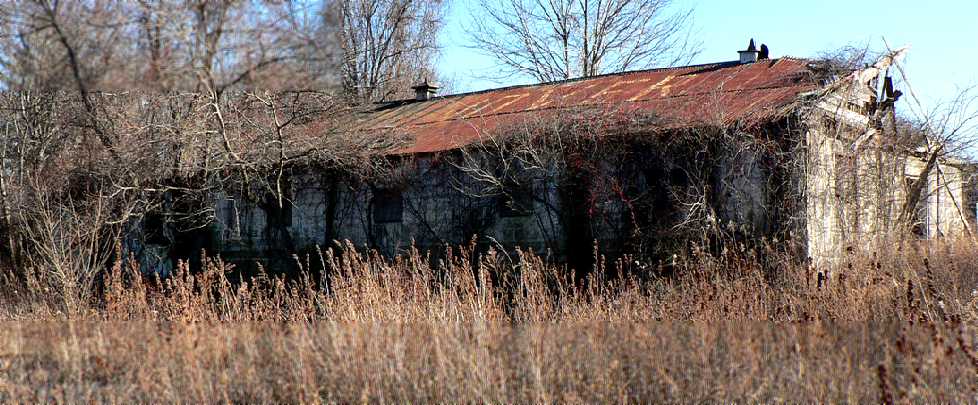
A December 2006 photo by Daniel Berek of the Hanover hangar, with the “Hanover” lettering still visible on the roof.
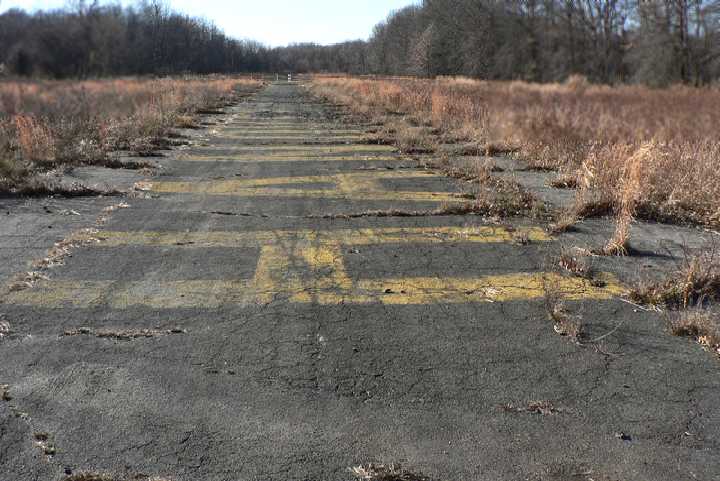
A December 2006 photo by Daniel Berek looking west along Hanover's former Runway 27, with the “Hanover” lettering still visible.
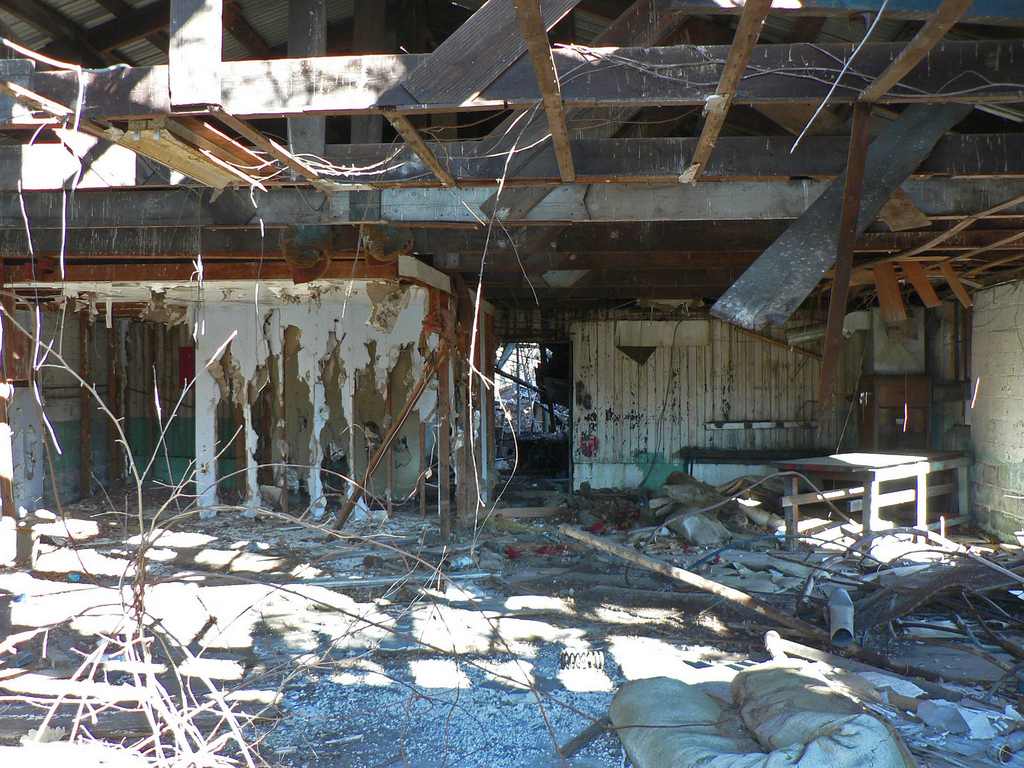
A 12/10/06 photo by Daniel Berek, “Inside the main terminal of what was once a thriving general-aviation airport.”
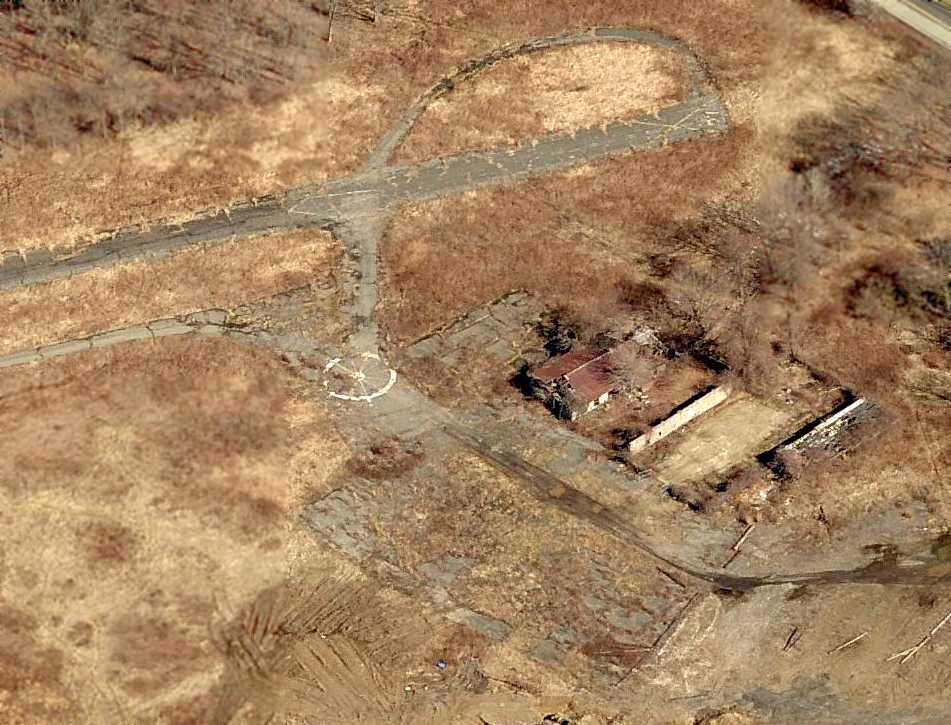
A circa 2006-2010 aerial view looking north at the remains of Hanover Airport,
including the runway, taxiways, ramp, and remains of 2 hangars.
Bill Fusselman recalled, “I lost track of the Oram's & Hanover Airport, returning in 2009 to find it gone. That was a sad day!”
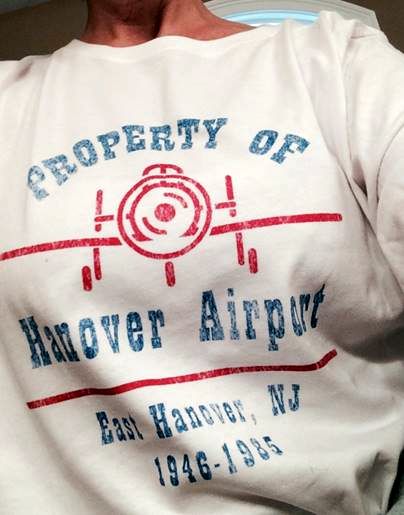
A T-shirt created by Sandee Weiner to commemorate Hanover Airport.
The site of Hanover Airport is located adjacent to the south side of Interstate 280, west of Ridgedale Ave.
Thanks to Aaron Gould for pointing out this airfield,
and to James G. for providing further historical background.
____________________________________________________
Since this site was first put on the web in 1999, its popularity has grown tremendously.
That has caused it to often exceed bandwidth limitations
set by the company which I pay to host it on the web.
If the total quantity of material on this site is to continue to grow,
it will require ever-increasing funding to pay its expenses.
Therefore, I request financial contributions from site visitors,
to help defray the increasing costs of the site
and ensure that it continues to be available & to grow.
What would you pay for a good aviation magazine, or a good aviation book?
Please consider a donation of an equivalent amount, at the least.
This site is not supported by commercial advertising –
it is purely supported by donations.
If you enjoy the site, and would like to make a financial contribution,
you
may use a credit card via
![]() ,
using one of 2 methods:
,
using one of 2 methods:
To make a one-time donation of an amount of your choice:
Or you can sign up for a $10 monthly subscription to help support the site on an ongoing basis:
Or if you prefer to contact me directly concerning a contribution (for a mailing address to send a check),
please contact me at: paulandterryfreeman@gmail.com
If you enjoy this web site, please support it with a financial contribution.
please contact me at: paulandterryfreeman@gmail.com
If you enjoy this web site, please support it with a financial contribution.
____________________________________________________
This site covers airfields in all 50 states.